VLT Part 2
• January 17, 2018: Globular star clusters are huge spheres of tens of thousands of stars that orbit most galaxies. They are among the oldest known stellar systems in the Universe and date back to near the beginning of galaxy growth and evolution. More than 150 are currently known to belong to the Milky Way. 119)
- One particular cluster, called NGC 3201 and situated in the southern constellation of Vela (The Sails), has now been studied using the MUSE instrument on ESO’s Very Large Telescope in Chile. An international team of astronomers has found that one of the stars in NGC 3201 is behaving very oddly — it is being flung backwards and forwards at speeds of several hundred thousand kilometers per hour, with the pattern repeating every 167 days.
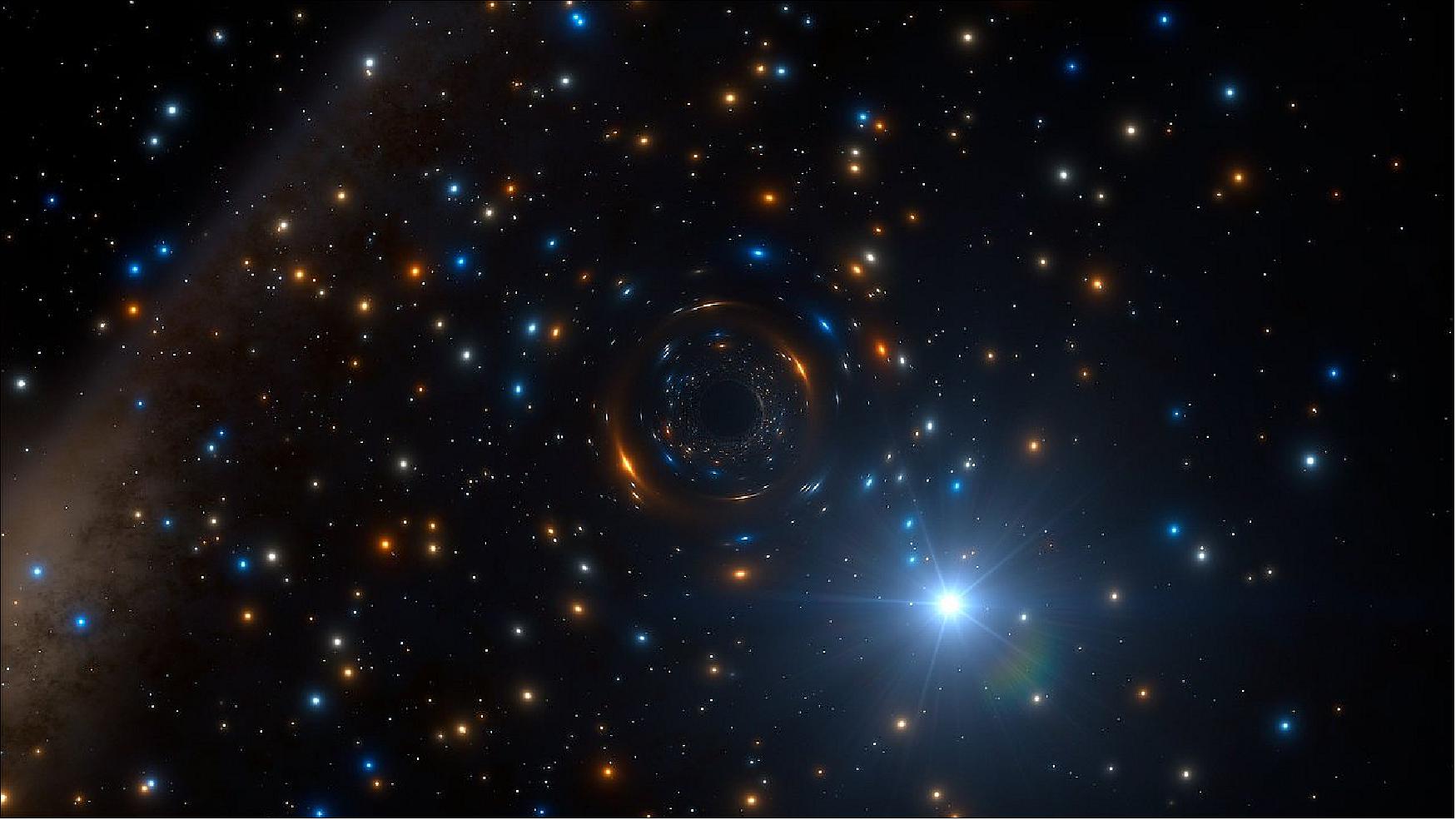
- Lead author Benjamin Giesers (Georg-August-Universität Göttingen, Germany) was intrigued by the star’s behavior: “It was orbiting something that was completely invisible, which had a mass more than four times the Sun — this could only be a black hole! The first one found in a globular cluster by directly observing its gravitational pull.” 120)
- The relationship between black holes and globular clusters is an important but mysterious one. Because of their large masses and great ages, these clusters are thought to have produced a large number of stellar-mass black holes — created as massive stars within them exploded and collapsed over the long lifetime of the cluster.
- ESO’s MUSE instrument provides astronomers with a unique ability to measure the motions of thousands of far away stars at the same time. With this new finding, the team have for the first time been able to detect an inactive black hole at the heart of a globular cluster — one that is not currently swallowing matter and is not surrounded by a glowing disc of gas. They could estimate the black hole’s mass through the movements of a star caught up in its enormous gravitational pull.
- From its observed properties the star was determined to be about 0.8 times the mass of our Sun, and the mass of its mysterious counterpart was calculated at around 4.36 times the Sun’s mass — almost certainly a black hole.
- Recent detections of radio and X-ray sources in globular clusters, as well as the 2016 detection of gravitational-wave signals produced by the merging of two stellar-mass black holes, suggest that these relatively small black holes may be more common in globular clusters than previously thought.
- Giesers concludes: “Until recently, it was assumed that almost all black holes would disappear from globular clusters after a short time and that systems like this should not even exist! But clearly this is not the case — our discovery is the first direct detection of the gravitational effects of a stellar-mass black hole in a globular cluster. This finding helps in understanding the formation of globular clusters and the evolution of black holes and binary systems — vital in the context of understanding gravitational wave sources.”
• December 13, 2017: The OmegaCAM camera on ESO’s VLT Survey Telescope has captured this glittering view of the stellar nursery called Sharpless 29 (Figure 80). Many astronomical phenomena can be seen in this giant image, including cosmic dust and gas clouds that reflect, absorb, and re-emit the light of hot young stars within the nebula. 121)
- The region of sky pictured is listed in the Sparpless Catalog of H II regions: interstellar clouds of ionized gas, rife with star formation. Also known as Sh 2-29, Sharpless 29 is located about 5500 light-years away in the constellation of Sagittarius (The Archer), next door to the larger Lagoon Nebula. It contains many astronomical wonders, including the highly active star formation site of NGC 6559, the nebula at the center of the image.
- This central nebula is Sharpless 29’s most striking feature. Though just a few light-years across, it showcases the havoc that stars can wreak when they form within an interstellar cloud. The hot young stars in this image are no more than two million years old and are blasting out streams of high-energy radiation. This energy heats up the surrounding dust and gas, while their stellar winds dramatically erode and sculpt their birthplace. In fact, the nebula contains a prominent cavity that was carved out by an energetic binary star system. This cavity is expanding, causing the interstellar material to pile up and create the reddish arc-shaped border.
- When interstellar dust and gas are bombarded with ultraviolet light from hot young stars, the energy causes them to shine brilliantly. The diffuse red glow permeating this image comes from the emission of hydrogen gas, while the shimmering blue light is caused by reflection and scattering off small dust particles. As well as emission and reflection, absorption takes place in this region. Patches of dust block out the light as it travels towards us, preventing us from seeing the stars behind it, and smaller tendrils of dust create the dark filamentary structures within the clouds.
- The rich and diverse environment of Sharpless 29 offers astronomers a smorgasbord of physical properties to study. The triggered formation of stars, the influence of the young stars upon dust and gas, and the disturbance of magnetic fields can all be observed and examined in this single area.
- But young, massive stars live fast and die young. They will eventually explosively end their lives in a supernova, leaving behind rich debris of gas and dust. In tens of millions of years, this will be swept away and only an open cluster of stars will remain.
- Sharpless 29 was observed with ESO’s OmegaCAM on the VLT Survey Telescope (VST) at Cerro Paranal in Chile. OmegaCAM produces images that cover an area of sky more than 300 times greater than the largest field of view imager of the NASA/ESA Hubble Space Telescope, and can observe over a wide range of wavelengths from the ultraviolet to the infrared. Its hallmark feature is its ability to capture the very red spectral line H-alpha, created when the electron inside a hydrogen atom loses energy, a prominent occurrence in a nebula like Sharpless 29.
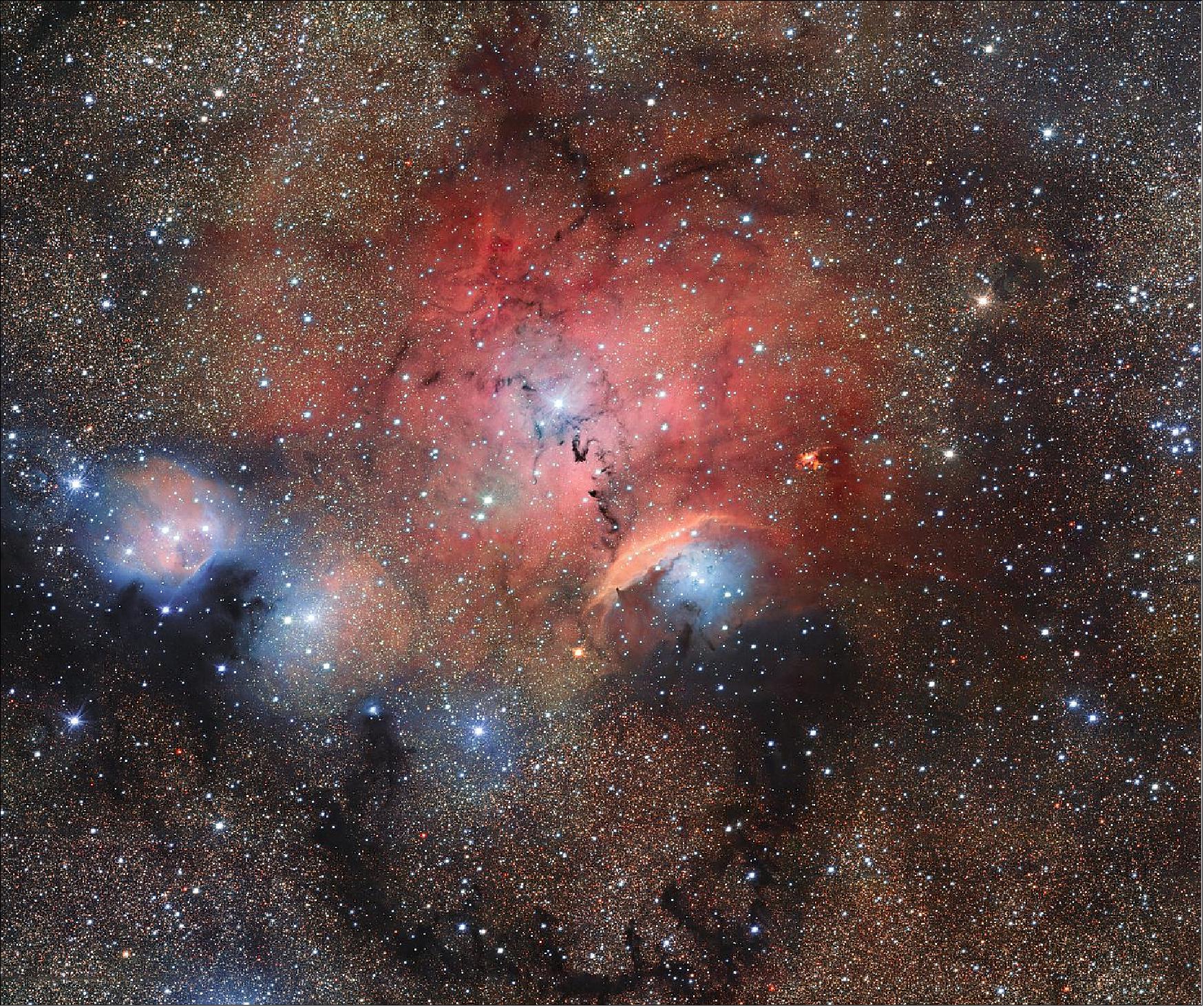
• August 23, 2017: To the unaided eye the famous, bright star Antares shines with a strong red tint in the heart of the constellation of Scorpius (The Scorpion). It is a huge and comparatively cool red supergiant star in the late stages of its life, on the way to becoming a supernova. 122)
- A team of astronomers, led by Keiichi Ohnaka, of the Universidad Católica del Norte in Chile, has now used ESO’s Very Large Telescope Interferometer (VLTI) at the Paranal Observatory in Chile to map Antares’s surface and to measure the motions of the surface material. This is the best image of the surface and atmosphere of any star other than the Sun.
- The VLTI is a unique facility that can combine the light from up to four telescopes, either the 8.2 meter Unit Telescopes, or the smaller Auxiliary Telescopes, to create a virtual telescope equivalent to a single mirror up to 200 m across. This allows it to resolve fine details far beyond what can be seen with a single telescope alone.
- “How stars like Antares lose mass so quickly in the final phase of their evolution has been a problem for over half a century,” said Keiichi Ohnaka, who is also the lead author of the paper. “The VLTI is the only facility that can directly measure the gas motions in the extended atmosphere of Antares — a crucial step towards clarifying this problem. The next challenge is to identify what’s driving the turbulent motions.”
- Using the new results the team has created the first two-dimensional velocity map of the atmosphere of a star other than the Sun. They did this using the VLTI with three of the Auxiliary Telescopes and an instrument called AMBER to make separate images of the surface of Antares over a small range of infrared wavelengths. The team then used these data to calculate the difference between the speed of the atmospheric gas at different positions on the star and the average speed over the entire star. This resulted in a map of the relative speed of the atmospheric gas across the entire disc of Antares — the first ever created for a star other than the Sun.
- The astronomers found turbulent, low-density gas much further from the star than predicted, and concluded that the movement could not result from convection, that is, from large-scale movement of matter which transfers energy from the core to the outer atmosphere of many stars. They reason that a new, currently unknown, process may be needed to explain these movements in the extended atmospheres of red supergiants like Antares.
- “In the future, this observing technique can be applied to different types of stars to study their surfaces and atmospheres in unprecedented detail. This has been limited to just the Sun up to now,” concludes Ohnaka. “Our work brings stellar astrophysics to a new dimension and opens an entirely new window to observe stars.”
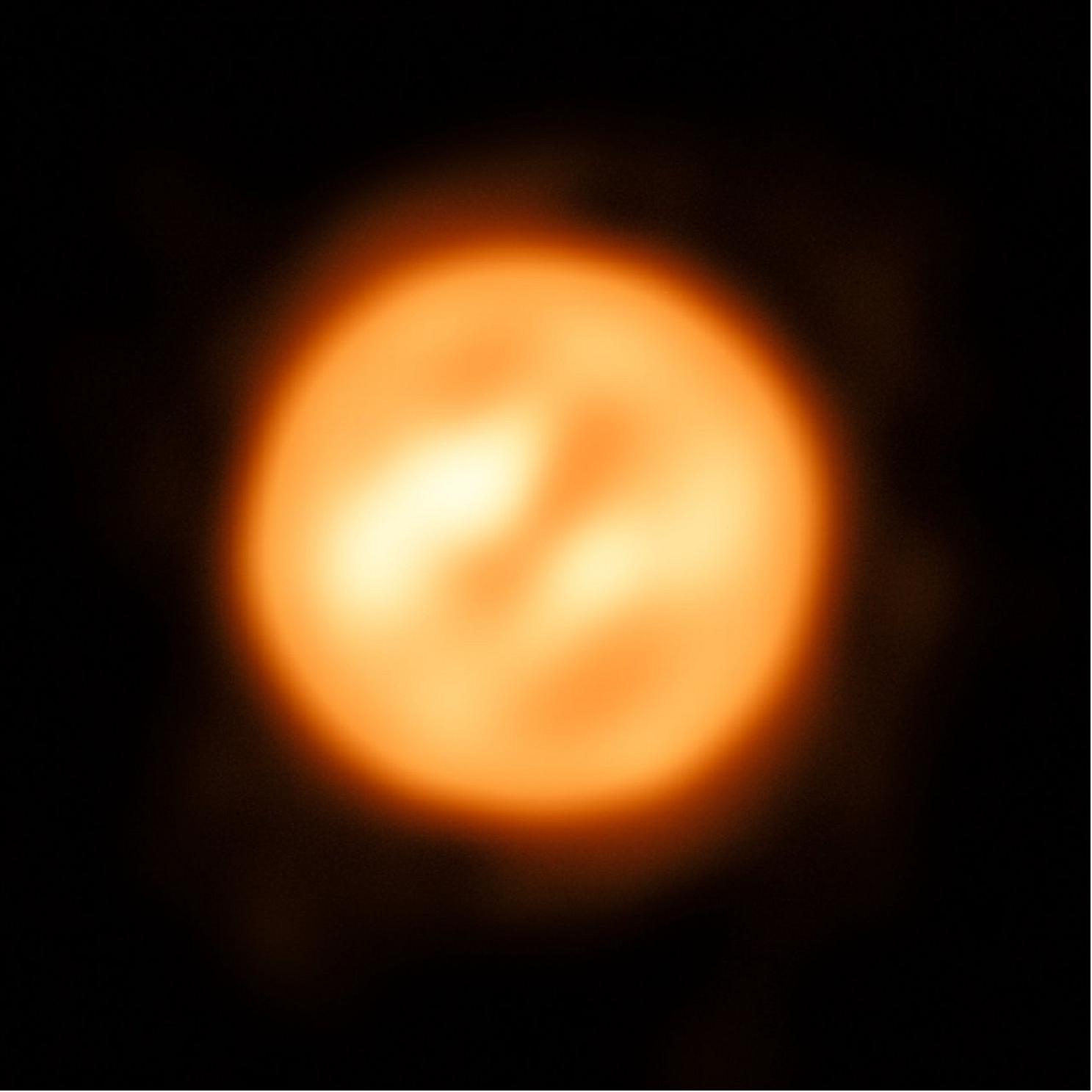
• May 23, 2013: This new picture celebrates an important anniversary for the VLT (Very Large Telescope) – it is fifteen years since the first light on the first of its four Unit Telescopes, on 25 May 1998. Since then the four original giant telescopes have been joined by the four small Auxiliary Telescopes that form part of the VLT Interferometer (VLTI). The VLT is one of the most powerful and productive ground-based astronomical facilities in existence. In 2012 more than 600 refereed scientific papers based on data from the VLT and VLTI were published (ann13009). 124)
- Interstellar clouds of dust and gas are the nurseries where new stars are born and grow. The new picture shows one of them, IC 2944, which appears as the softly glowing pink background . This image is the sharpest view of the object ever taken from the ground. The cloud lies about 6500 light-years away in the southern constellation of Centaurus (The Centaur). This part of the sky is home to many other similar nebulae that are scrutinized by astronomers to study the mechanisms of star formation.
- Emission nebulae like IC 2944 are composed mostly of hydrogen gas that glows in a distinctive shade of red, due to the intense radiation from the many brilliant newborn stars. Clearly revealed against this bright backdrop are mysterious dark clots of opaque dust, cold clouds known as Bok globules. They are named after the Dutch-American astronomer Bart Bok, who first drew attention to them in the 1940s as possible sites of star formation. This particular set is nicknamed the Thackeray Globules (they were discovered from South Africa by the English astronomer A. David Thackeray in 1950).
- Larger Bok globules in quieter locations often collapse to form new stars but the ones in this picture are under fierce bombardment from the ultraviolet radiation from nearby hot young stars. They are both being eroded away and also fragmenting, rather like lumps of butter dropped into a hot frying pan. It is likely that Thackeray’s Globules will be destroyed before they can collapse and form stars.
- Bok globules are not easy to study. As they are opaque to visible light it is difficult for astronomers to observe their inner workings, and so other tools are needed to unveil their secrets — observations in the infrared or in the submillimeter parts of the spectrum, for example, where the dust clouds, only a few degrees over absolute zero, appear bright. Such studies of the Thackeray globules have confirmed that there is no current star formation within them.
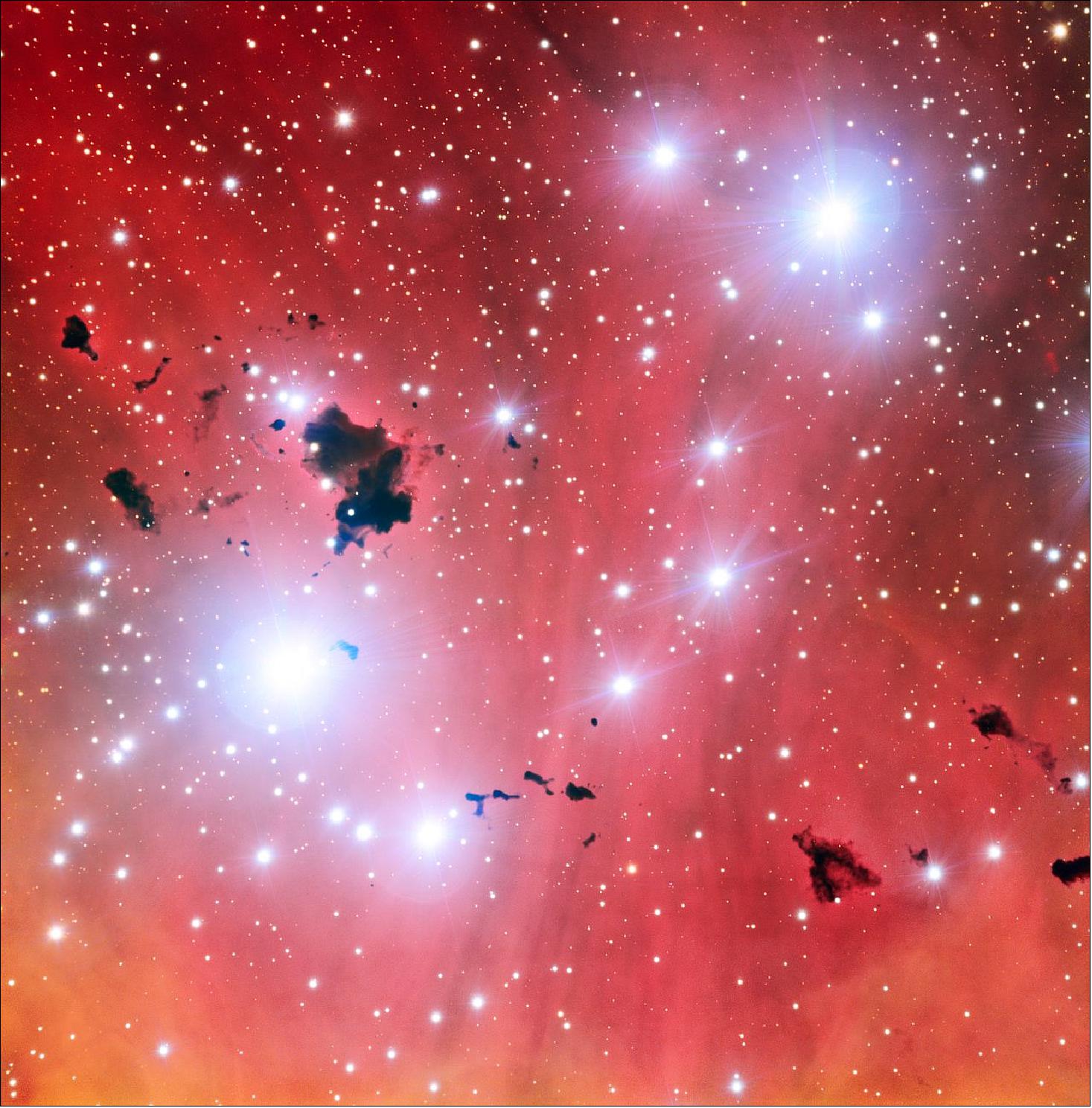
• August 2011: The Eyes are about 50 million light-years away in the constellation of Virgo (The Virgin) and are some 100,000 light-years apart. The nickname comes from the apparent similarity between the cores of this pair of galaxies — two white ovals that resemble a pair of eyes glowing in the dark when seen in a moderate-sized telescope. 125)
- But although the centers of these two galaxies look similar, their outskirts could not be more different. The galaxy in the lower right, known as NGC 4435, is compact and seems to be almost devoid of gas and dust. In contrast, in the large galaxy in the upper left (NGC 4438) a lane of obscuring dust is visible just below its nucleus, young stars can be seen left of its center, and gas extends at least up to the edges of the image.
- The contents of NGC 4438 have been stripped out by a violent process: a collision with another galaxy. This clash has distorted the galaxy’s spiral shape, much as could happen to the Milky Way when it collides with its neighboring galaxy Andromeda in three or four billion years.
- NGC 4435 could be the culprit. Some astronomers believe that the damage caused to NGC 4438 resulted from an approach between the two galaxies to within about 16,000 light-years that happened some 100 million years ago. But while the larger galaxy was damaged, the smaller one was significantly more affected by the collision. Gravitational tides from this clash are probably responsible for ripping away the contents of NGC 4438, and for reducing NGC 4435’s mass and removing most of its gas and dust.
- Another possibility is that the giant elliptical galaxy Messier 86, further away from The Eyes and not visible in this image, was responsible for the damage caused to NGC 4438. Recent observations have found filaments of ionized hydrogen gas connecting the two large galaxies, indicating that they may have collided in the past.
- The elliptical galaxy Messier 86 and The Eyes belong to the Virgo Cluster, a very rich grouping of galaxies. In such close quarters, galaxy collisions are fairly frequent, so perhaps NGC 4438 suffered from encounters with both NGC 4435 and Messier 86.
- This picture is the first to be produced as part of the ESO Cosmic Gems program (Figure 83). This is a new initiative to produce astronomical images for educational and public outreach purposes. The program mainly makes use of time when the sky conditions are not suitable for science observations to take pictures of interesting, intriguing or visually attractive objects. The data are also made available to professional astronomers through ESO’s science archive.
- In this case, although there were some clouds, the atmosphere was exceptionally stable, which allowed very sharp details to be revealed in this image taken using the VLT’s FORS2 (FOcal Reducer and low dispersion Spectrograph) instrument (installed on the VLT’s Unit Telescope 1). Light passing through two different filters was used: red (colored red) and green-yellow (colored blue), and the exposure times were 1800 seconds and 1980 seconds, respectively.
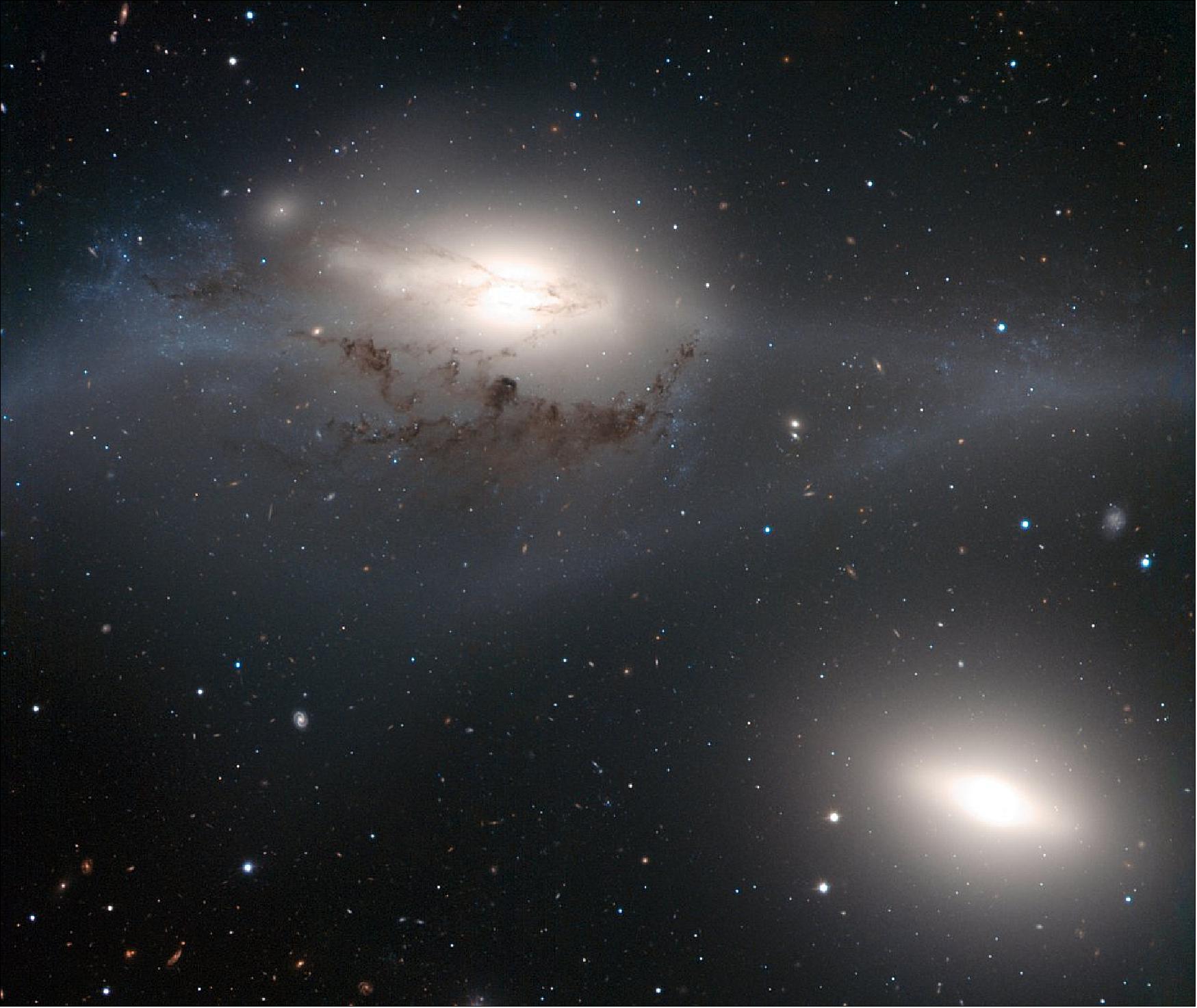
• March 13, 2002: One of the most fundamental tasks of modern astrophysics is the study of the evolution of the Universe . This is a daunting undertaking that requires extensive observations of large samples of objects in order to produce reasonably detailed maps of the distribution of galaxies in the Universe and to perform statistical analysis. Much effort is now being put into mapping the relatively nearby space and thereby to learn how the Universe looks today . But to study its evolution, we must compare this with how it looked when it still was young . This is possible, because astronomers can "look back in time" by studying remote objects - the larger their distance, the longer the light we now observe has been underway to us, and the longer is thus the corresponding "look-back time." This may sound easy, but it is not. Very distant objects are very dim and can only be observed with large telescopes. Looking at one object at a time would make such a study extremely time-consuming and, in practical terms, impossible. To do it anyhow, we need the largest possible telescope with a highly specialized, exceedingly sensitive instrument that is able to observe a very large number of (faint) objects in the remote universe simultaneously. 126) 127)
- VIMOS (VLT VIsible Multi-Object Spectrograph) is such an instrument. It can obtain many hundreds of spectra of individual galaxies in the shortest possible time; in fact, in one special observing mode, up to 6400 spectra of the galaxies in a remote cluster during a single exposure, augmenting the data gathering power of the telescope by the same proportion. This marvelous science machine has just been installed at the 8.2-m MELIPAL telescope, the third unit of the VLT (Very Large Telescope) at the ESO Paranal Observatory. A main task will be to carry out 3-dimensional mapping of the distant Universe from which we can learn its large-scale structure.
- "First light" was achieved on February 26, 2002, and a first series of test observations has successfully demonstrated the huge potential of this amazing facility. Much work on VIMOS is still ahead during the coming months in order to put into full operation and fine-tune the most efficient "galaxy cruncher" in the world. VIMOS is the outcome of a fruitful collaboration between ESO and several research institutes in France and Italy, under the responsibility of the Laboratoire d'Astrophysique de Marseille (CNRS, France). The other partners in the "VIRMOS Consortium" are the Laboratoire d'Astrophysique de Toulouse, Observatoire Midi-Pyrénées, and Observatoire de Haute-Provence in France, and Istituto di Radioastronomia (Bologna), Istituto di Fisica Cosmica e Tecnologie Relative (Milano), Osservatorio Astronomico di Bologna, Osservatorio Astronomico di Brera (Milano) and Osservatorio Astronomico di Capodimonte (Naples) in Italy.

Legend to Figure 84: The image is a composite VRI image obtained on March 4, 2002. The individual exposures lasted 180 seconds; image quality 0.7 arcsec FWHM; field 7 x 7 arcmin2; North is up and East is left.
Development Status
• On 17 March 2011 light collected by all four of the 8-meter Unit Telescopes of ESO’s Very Large Telescope was successfully combined for the first time using PIONIER (a visiting instrument at the Paranal Observatory, developed at LAOG/IPAG in Grenoble, France), a new generation instrument in the VLT Interferometer. 128)
- To have all four Unit Telescopes (UTs) finally working together as a single telescope is a major step in the development of the VLT — the original design always anticipated that the four 8 m telescopes would be able to work either independently or together as part of the giant VLT Interferometer (VLTI). Coincidentally, the new observations took place on the 10th anniversary of the first successful combination of two beams within the VLTI.
- Among the main science goals for the four UTs, working together with PIONIER, are to try to reveal the signatures of planets in the making, to explore the natures and fates of stars by providing images of their surfaces and their environments and to understand better the powerful engines associated with black holes at the centers of galaxies.
- When combined, the UTs can potentially provide image sharpness that equals that of a telescope with a diameter of up to 130 meters. Three telescopes have been combined regularly since the VLT/VLTI began observing, offering three unique baselines; the ability to combine four telescopes bumps this number up to six and allows the very fine structure in astronomical objects to be studied much more easily.
- Individually the 8meter telescopes can spy objects four billion times fainter than the naked eye can see and working together the four large telescopes can pick up details about 16 times finer than can be seen with one UT.
- An earlier important step towards unleashing the full potential of the VLTI was when light from all four of the 1.8 meter VLT Auxiliary Telescopes (ATs) was combined using PIONIER.
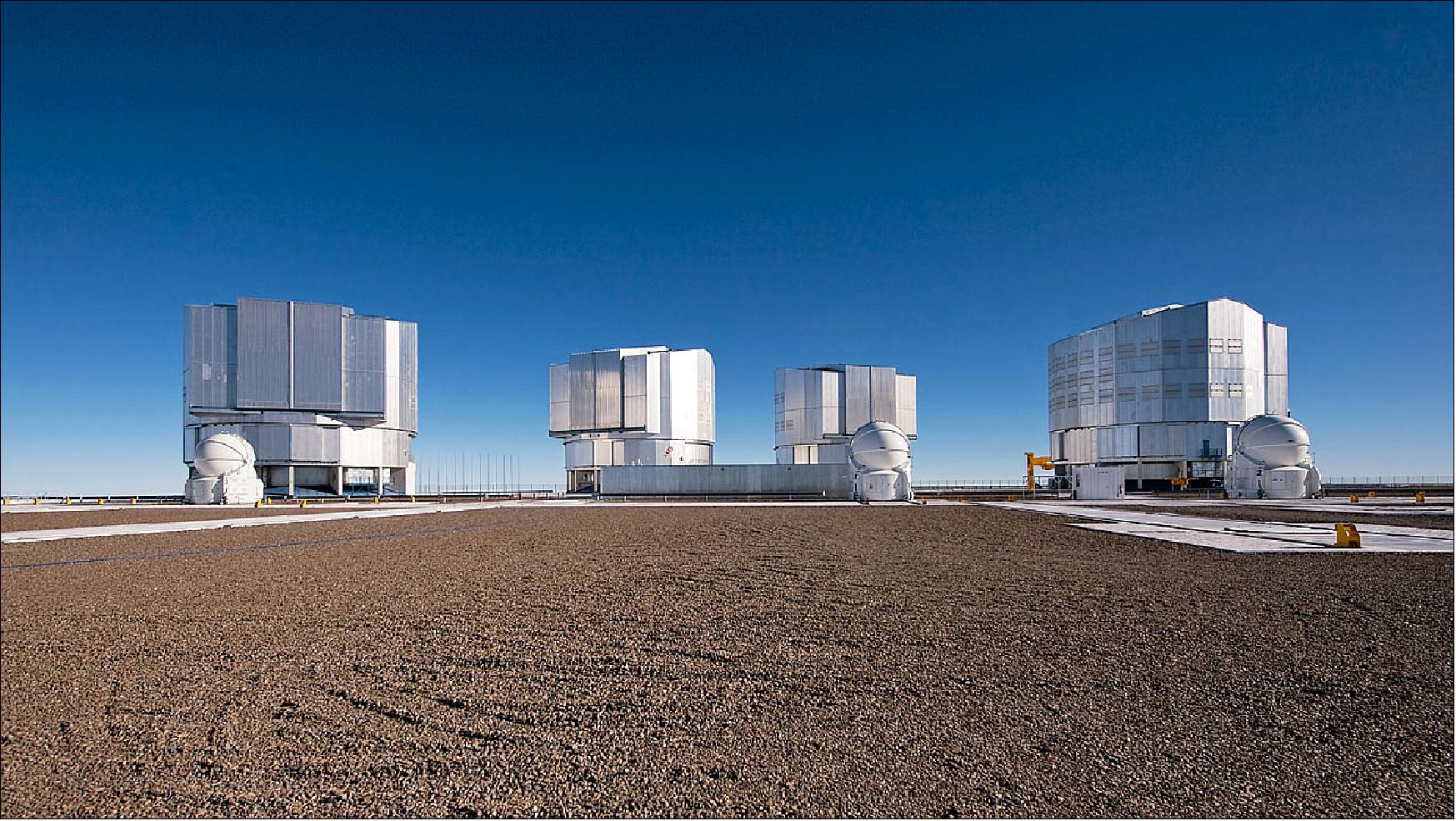
• November 4, 2010: Light coming from the four 1.8 meter Auxiliary Telescopes at the European Southern Observatory’s VLTI (Very Large Telescope Interferometer) based in Paranal, Chile, has been successfully combined for the first time using a new visiting instrument called PIONIER (France). This is an important step towards unleashing the full potential of the VLTI to use multiple telescopes together to reveal fine detail in distant objects. A joint team from Grenoble LAOG (Laboratoire d’Astrophysique de Grenoble) and ESO achieved this very challenging feat of engineering only five days after unpacking the equipment on the mountain. 129)
- The VLTI engineers had to control the distance traversed by the light from the widely separated telescopes with an accuracy of about one hundredth of the thickness of a strand of human hair. Once the light reached PIONIER, it was then channelled into the heart of the instrument: a remarkable optical circuit, smaller than a credit card, that finally brought the light waves from the different telescopes together in a very precise way so that they could create interference. The resulting resolving power of the telescope array has the sharpness not of the individual 1.8 meter Auxiliary Telescopes, but that of a much bigger “virtual telescope” about 100 m across, limited only by how far apart the telescopes can be positioned.
- PIONIER, developed at LAOG in Grenoble, France, is a visiting instrument at the Paranal Observatory, complementing ESO’s existing AMBER and MIDI instruments. AMBER has previously combined the light from three of the telescopes at the VLTI to study many objects, including the surface of the variable star T Leporis (eso0906). PIONIER, however, will eventually allow the VLTI to go one stage further; with the additional information that a fourth telescope brings to the table, it should be possible to use complex mathematical processing techniques to create more detailed images. The PIONIER team hopes to produce its first images by early 2011.
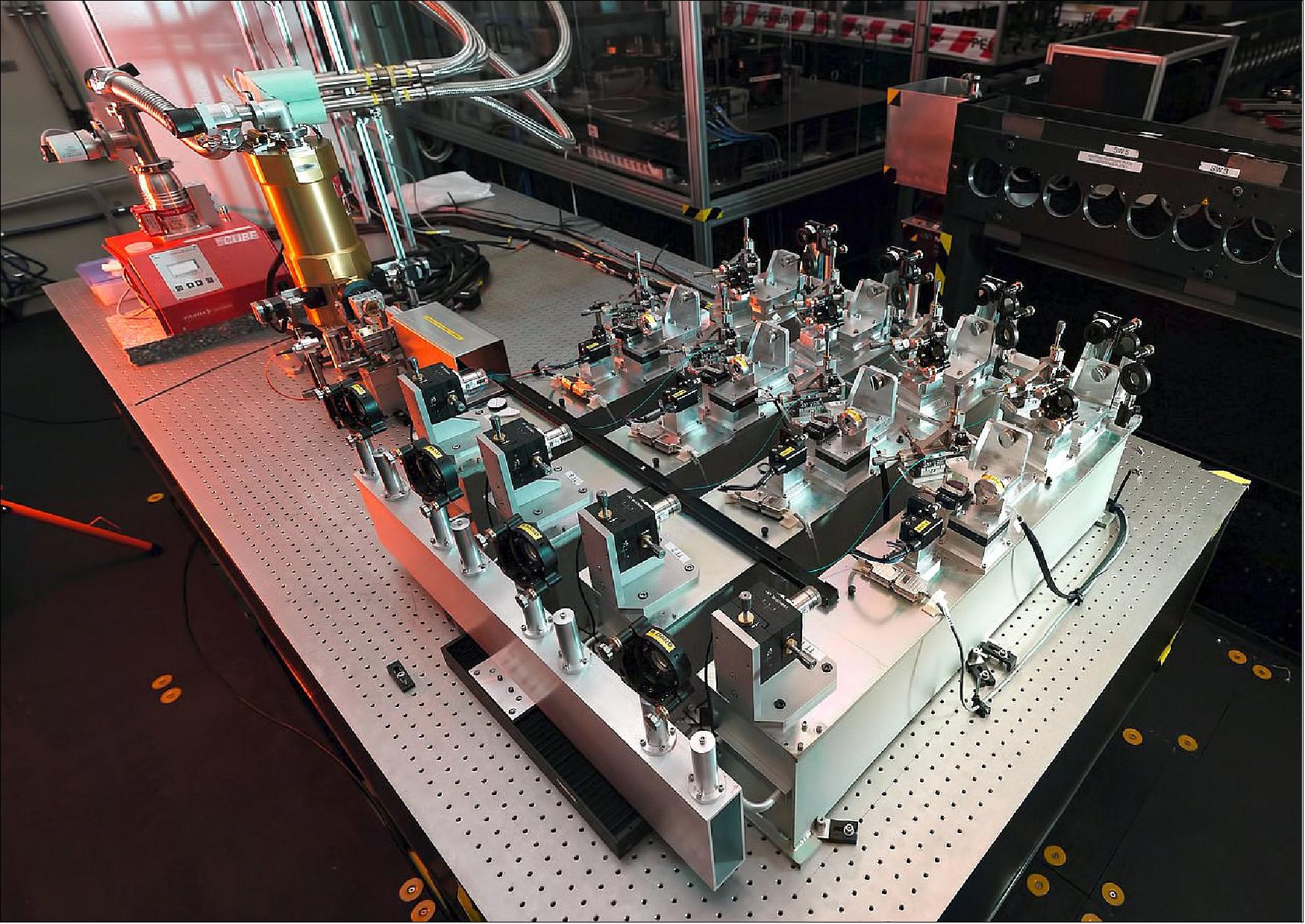
Sensor Complement
ESPRESSO (Echelle SPectrograph for Rocky Exoplanet and Stable Spectroscopic Observations)
ESPRESSO is a super-stable Optical High Resolution Spectrograph for the combined coude' focus of the VLT. It can be operated by either one of the UTs or collecting the light from up to 4 UTs simultaneously.
The main scientific drivers for ESPRESSO are:
• the measurement of high precision radial velocities of solar type stars for search for rocky planets
• the measurement of the variation of the physical constants
• the analysis of the chemical composition of stars in nearby galaxies
These science cases require an efficient, high-resolution, extremely stable and accurate spectrograph.
ESPRESSO, installed at the VLT facility, will combine unprecedented radial velocity precision with the large collecting area of the UTs. Moreover it will be capable of collecting the light simultaneously from the 4UTs, to measure precisely faint or high redshift objects.
The understanding of the formation and evolution of planetary systems is one of the most exciting science cases of these days. The radial velocity technique has been so far the most productive in terms of extra-solar planet detections. Low mass planets (one to few Earth masses) are especially interesting because according to formation models they could represent the bulk of the planet population. However they are more elusive and require extremely stable instruments. The HARPS instrument, with a precision better than 1m/s, has discovered up to now the vast majority of planets with masses smaller than Neptune, giving an invaluable experience in view of the realization of more precise instruments. With a radial velocity precision better than 10 cm/s, an Earth mass planet in the habitable zone of a low mass star can be detected.
The instrument will also have the capability to acquire the most accurate measurements of the fundamental constants α (the fine structure constant) and µ (the proton to electron mass ratio) as a function of redshift, therefore addressing the question of whether the constants of the Standard Model of Physics vary with the age of the Universe. Its capability to collect the light from all the 4 UTs simultaneously will enlarge the number of accessible QSOs (Quasi-Stellar Objects) with great benefit for this science case.
The combination of high resolution and high efficiency opens the possibility of measuring the chemical composition of stars in galaxies other than the Milky Way with unprecedented accuracy.
Given the large light collecting power and its efficiency, its high spectral resolution, and its extreme radial velocity precision and accuracy, we expect that ESPRESSO will not only fulfill its main scientific objectives, but also open new opportunities in observational Astronomy with hopefully new and unexpected results.
ESPRESSO was designed and built by a consortium consisting of: the Astronomical Observatory of the University of Geneva and University of Bern, Switzerland; INAF (Osservatorio Astronomico di Trieste) and INAF (Osservatorio Astronomico di Brera), Italy; Instituto de Astrofísica de Canarias, Spain; Instituto de Astrofisica e Ciências do Espaço, Universidade do Porto and Universidade de Lisboa, Portugal; and ESO. The co-principal investigators are Francesco Pepe (University of Geneva, Switzerland), Stefano Cristiani (INAF (Osservatorio Astronomico di Trieste), Italy, Rafael Rebolo (IAC, Tenerife, Spain) and Nuno Santos (Instituto de Astrofisica e Ciencias do Espaco, Universidade do Porto, Portugal).
Instrument Description
ESPRESSO is a fiber-fed, cross-dispersed, high-resolution, Echelle spectrograph. The telescope light is fed to the instrument via a Coude-Train optical system and fibers. ESPRESSO is located in the VLT CCL (Combined-Coude Laboratory) at the incoherent focus, where a front-end unit can combine the light from up to 4 Unit Telescopes (UT) of the VLT. The telescope light is fed to the instrument via a so-called Coudé Train optical system and within optical fibers. The target and sky light enter the instrument simultaneously through two separate fibers, which together form the slit of the spectrograph. 130) 131)
The incoherent combined focus: a new facility for a larger telescope: Although foreseen since 1977 in the original VLT plan, the incoherent combined focus of the VLT has never been implemented. Only provision for it, in terms of space left in the UTs structures and ducts in the rock of the mountain, is what is actually available at VLT. As part of the project agreement, the ESPRESSO Consortium has been asked to materialize such a focus providing the necessary hardware and software as part of the deliverables. The implementation of the Coudé Train is requiring substantial changes in the Paranal Observatory infrastructure yielding to an elaborated interfaces management. This new facility will allow to use the four telescopes as a large 16 meter equivalent telescope.
Enhanced flexibility and power: ESPRESSO will be located in the VLT’s CCL and, unlike any other instrument built so far, will receive light from any of the four UTs, allowing for a more flexible usage of the observation time. The light of the single UT scheduled to work with ESPRESSO is then fed into the spectrograph (single-UT modes). Alternatively, the combined light of all the UTs can be fed into ESPRESSO simultaneously (multi-UT mode).
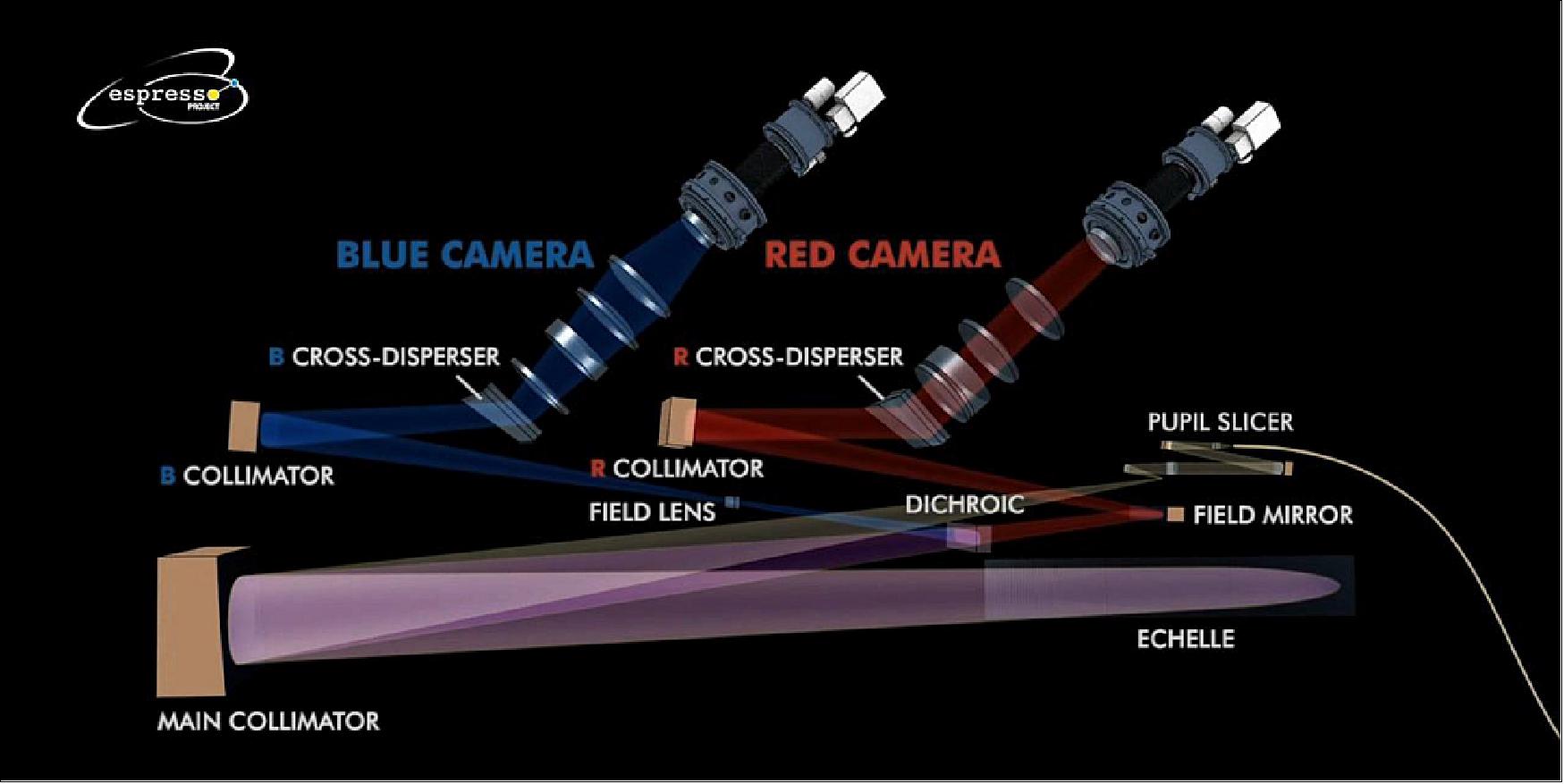
Several optical ‘tricks’ have been used to obtain high spectral resolution and efficiency despite the large size of the telescope and the 1 arcsec sky aperture of the instrument:
• At the spectrograph entrance the APSU (Anamorphic Pupil Slicing Unit) shapes the beam in order to compress it in cross-dispersion and splits in two smaller beams, while superimposing them on the echelle grating to minimize its size. The rectangular white pupil is then re-imaged and compressed.
• Given the wide spectral range, a dichroic beam splitter separates the beam in a blue and a red arm. Each arm is optimized for image quality and optical efficiency.
• The cross-disperser has the function of separating the dispersed spectrum in all its spectral orders. In addition, an anamorphism is re-introduced to make the pupil square and to compress the order height such that the inter-order space and the SNR per pixel are both maximized. Both functions are accomplished using VPHGs (Volume Phase Holographic Gratings) mounted on prisms.
• Finally, two optimized camera lens systems image the full spectrum from 380 nm to 780 nm on two large 92 mm x 92 mm CCDs with 10 µm pixels.
A sketch of the optical layout is shown in Figure 87. The spectral format covered by the blue and the red chips as well as the shape of the pseudo slit are illustrated by Figure 88.
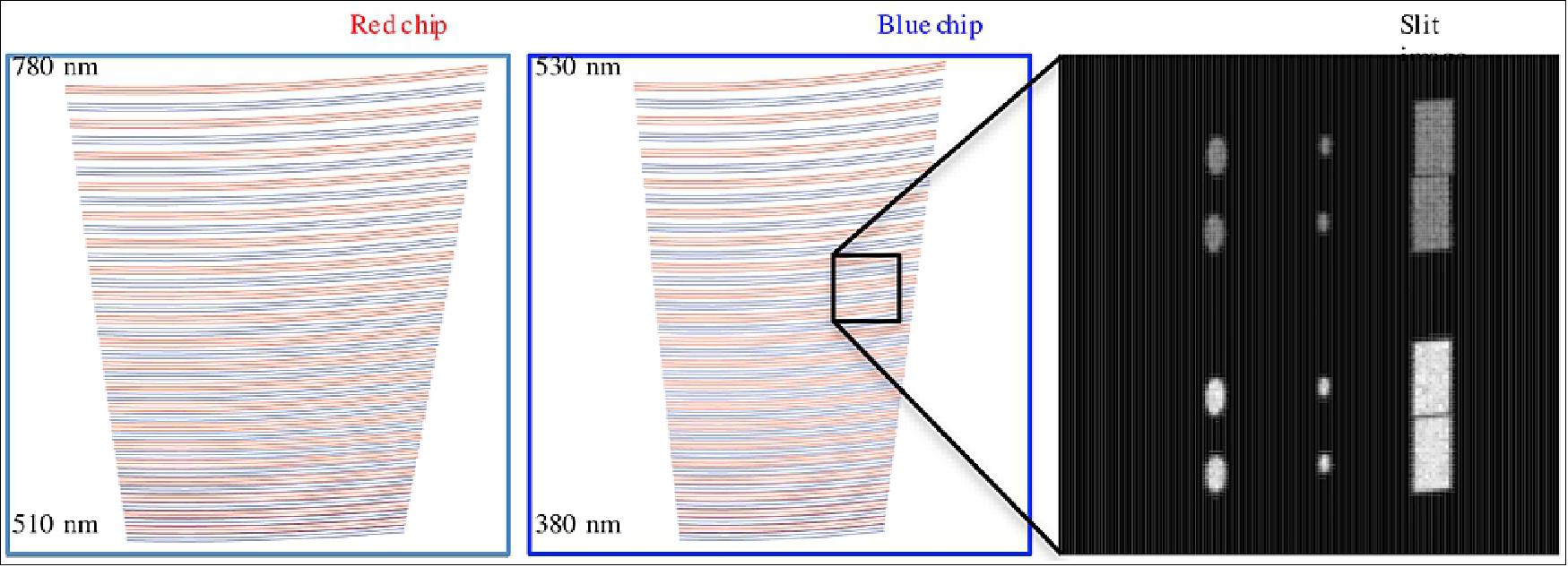
ESPRESSO Development Status
• February 13, 2018: The ESPRESSO instrument on ESO’s Very Large Telescope in Chile has used the combined light of all four of the 8.2 m Unit Telescopes for the first time. Combining light from the Unit Telescopes in this way makes the VLT the largest optical telescope in existence in terms of collecting area. This picture shows in highly simplified form how the light collected by all four VLT Unit Telescopes is combined in the ESPRESSO instrument, located under the VLT platform. 132) 133)
- One of the original design goals of ESO's VLT was for its four UTs (Unit Telescopes) to work together to create a single giant telescope. With the first light of the ESPRESSO spectrograph using the four-Unit-Telescope mode of the VLT, this milestone has now been reached.
- After extensive preparations by the ESPRESSO consortium (led by the Astronomical Observatory of the University of Geneva, with the participation of research centers from Italy, Portugal, Spain and Switzerland) and ESO staff, ESO's Director General Xavier Barcons initiated this historic astronomical observation with the push of a button in the control room.
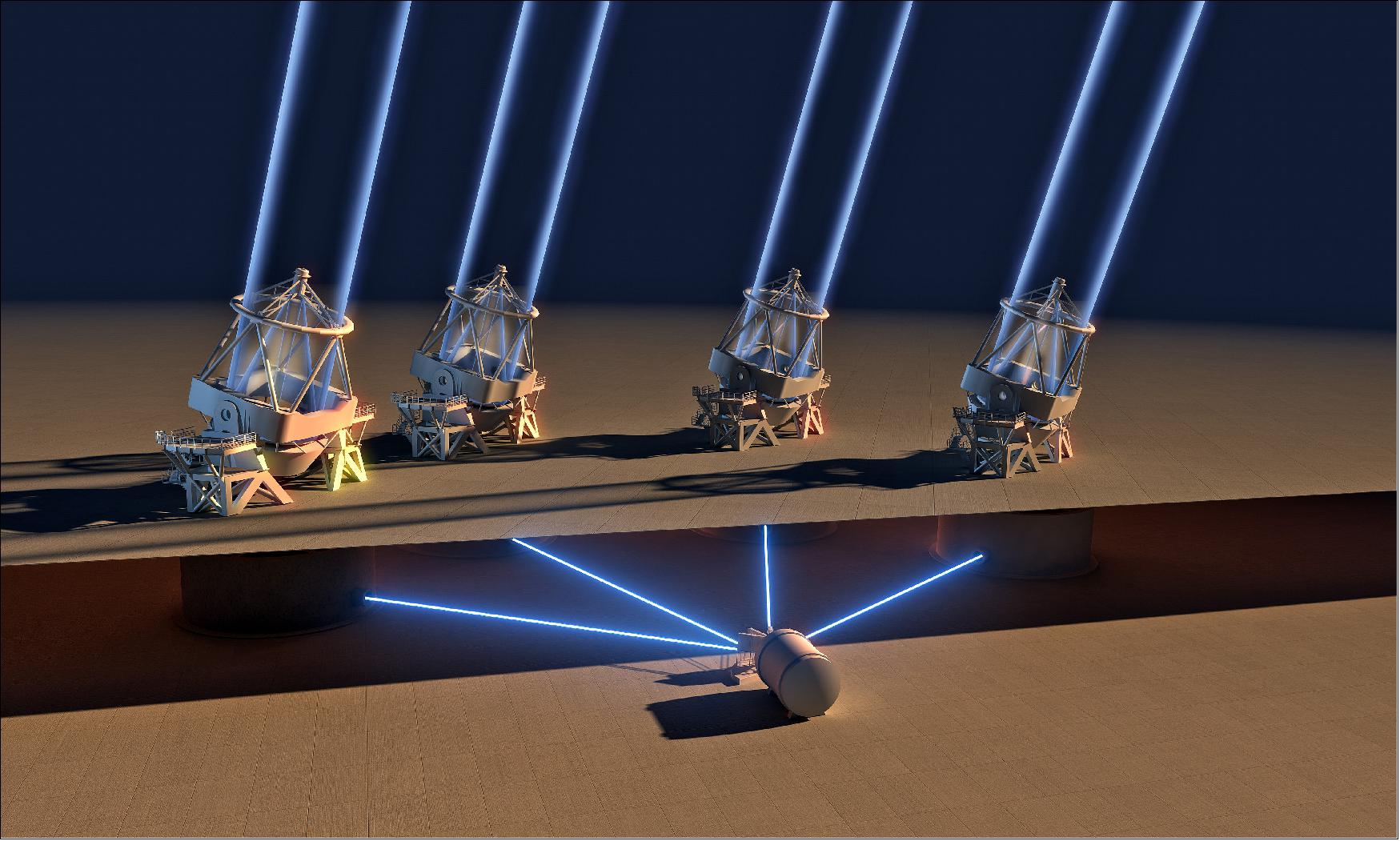
• December 6, 2017: ESPRESSO has achieved first light on ESO’s Very Large Telescope at the Paranal Observatory in northern Chile. This new, third-generation echelle spectrograph is the successor to ESO’s hugely successful HARPS instrument at the La Silla Observatory. HARPS can attain a precision of around 1 m/s in velocity measurements, whereas ESPRESSO aims to achieve a precision of just a few cm/s, due to advances in technology and its placement on a much bigger telescope. 134)
- The lead scientist for ESPRESSO, Francesco Pepe from the University of Geneva in Switzerland, explains its significance: “This success is the result of the work of many people over 10 years. ESPRESSO isn’t just the evolution of our previous instruments like HARPS, but it will be transformational, with its higher resolution and higher precision. And unlike earlier instruments it can exploit the VLT’s full collecting power — it can be used with all four of the VLT Unit Telescopes at the same time to simulate a 16 m telescope. ESPRESSO will be unsurpassed for at least a decade — now I am just impatient to find our first rocky planet!”
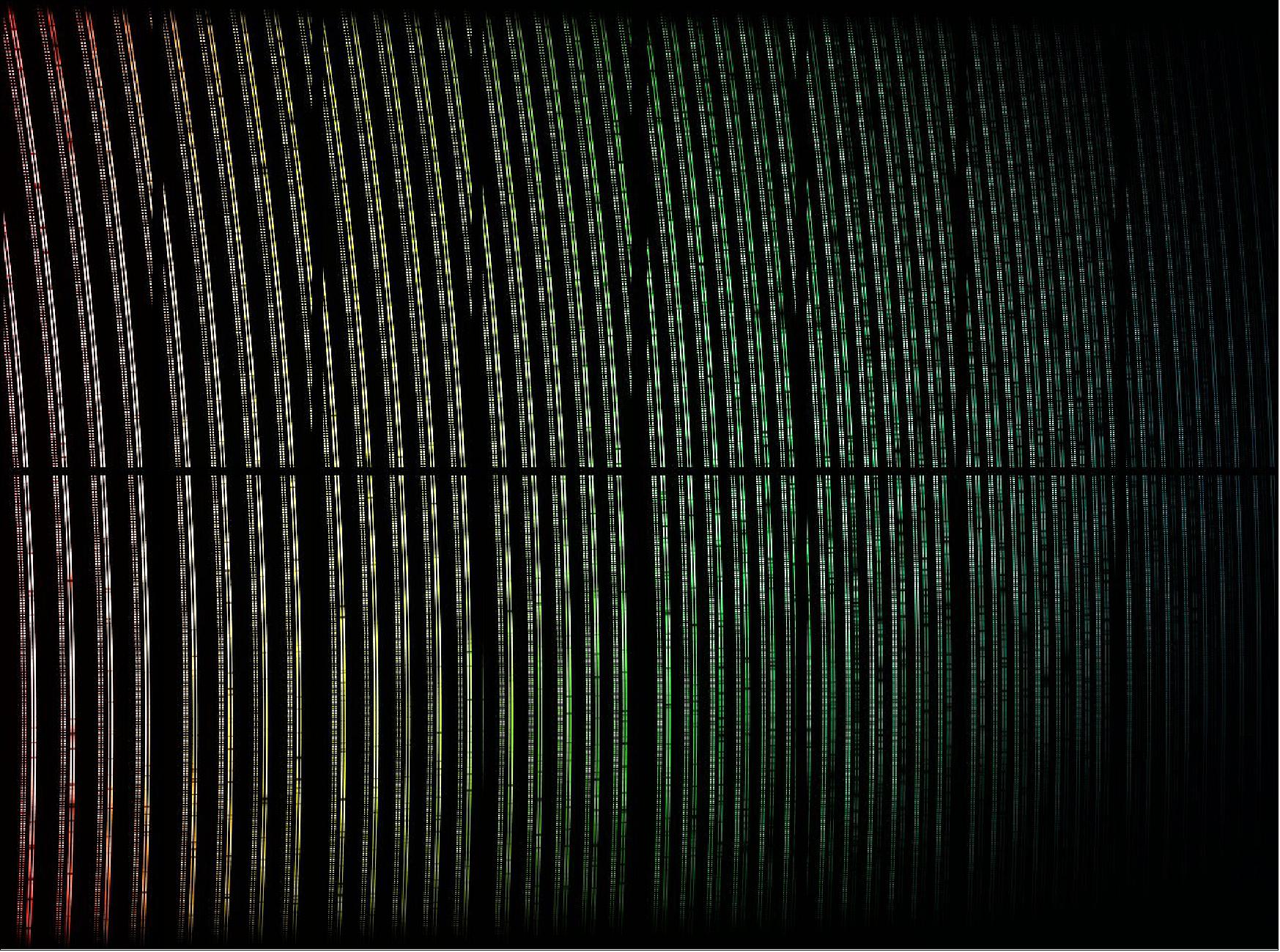
- ESPRESSO can detect tiny changes in the spectra of stars as a planet orbits. This radial velocity method works because a planet’s gravitational pull influences its host star, causing it to “wobble” slightly. The less massive the planet, the smaller the wobble, and so for rocky and possibly life-bearing exoplanets to be detected, an instrument with very high precision is required. With this method, ESPRESSO will be able to detect some of the lightest planets ever found.
- The test observations included observations of stars and known planetary systems. Comparisons with existing HARPS data showed that ESPRESSO can obtain similar quality data with dramatically less exposure time.
- Although the main goal of ESPRESSO is to push planet hunting to the next level, finding and characterizing less massive planets and their atmospheres, it also has many other applications. ESPRESSO will also be the world’s most powerful tool to test whether the physical constants of nature have changed since the Universe was young. Such tiny changes are predicted by some theories of fundamental physics, but have never been convincingly observed.
• September 14, 2015: Engineers at ESO have recently completed the difficult process of aligning the grating. The production and alignment of this component is one of the key ESO contributions to the ESPRESSO project. The grating is the largest ever assembled at ESO, and its length matches the largest echelle grating ever made — the 1.2 x 0.3 m grating for the HIRES spectrograph at the Keck 10 m telescope. 135)
- After its final alignment, the grating is fixed in a permanent mount. All its components are made of Zerodur (the same material that is used for the mirrors of the VLT) and will require no further adjustments, ever. This mounting technique was pioneered at ESO, and demonstrated to work on earlier instruments.
- When installed at ESO’s Paranal Observatory in Chile in 2016, ESPRESSO will combine the light from all four Unit Telescopes of the Very Large Telescope to create a virtual 16-meter aperture telescope. Its diffraction grating will split up the light into its component colors for analysis — spreading the light as a prism does, although relying on a different physical mechanism.
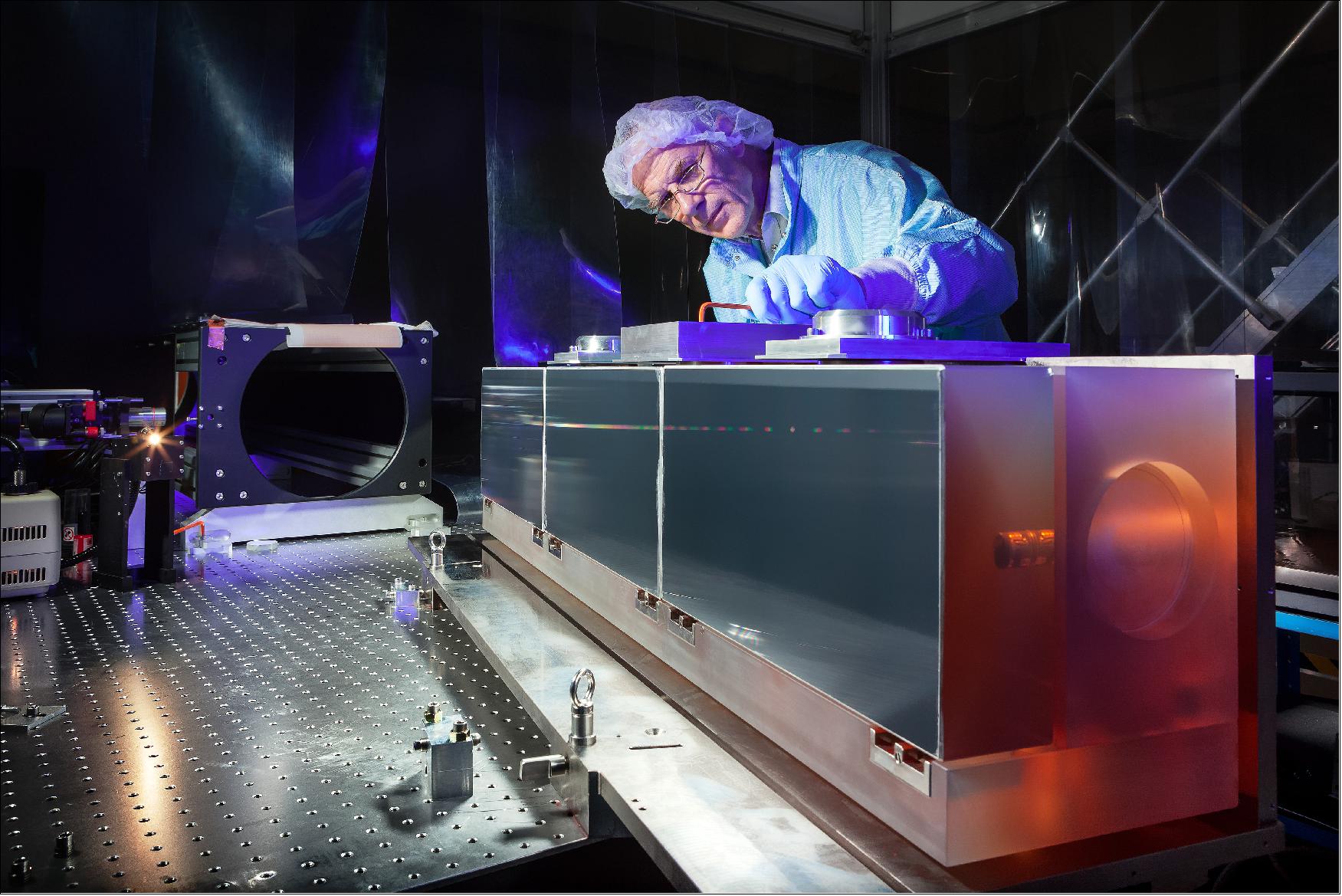
• August 7, 2013: ESO has signed contracts with Winlight Systems (France) for the construction of two cameras for the powerful new exoplanet-finding instrument, ESPRESSO. 136)
- ESPRESSO is an ultra-stable spectrograph that will be installed at ESO’s Paranal Observatory in Chile in 2016. It will be capable of combining light from all four Unit Telescopes of the Very Large Telescope (VLT) to create a virtual 16 meter aperture telescope.
- ESPRESSO is expected to allow astronomers to detect Earth-like planets around nearby stars using the radial velocity method . It will also have many other science applications, including the search for possible variations of the constants of nature at different times and in different directions through the study of the light from very distant quasars.
- The new contract is for the provision of the two refractive cameras, one for the red and one for the blue parts of the spectrum. These are vital components of the instrument. Utilizing highly non-spherical surfaces and novel design principles, they achieve excellent image quality over a large field with only three optical elements.
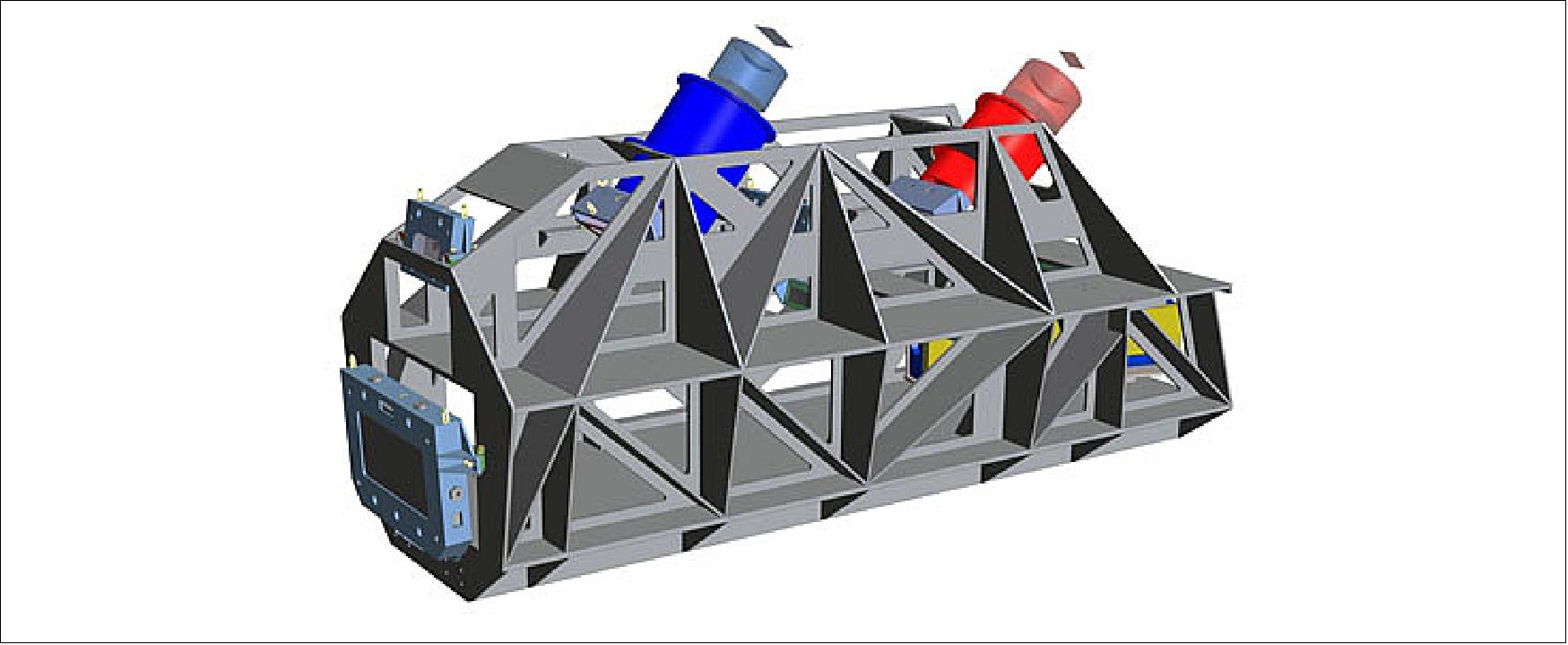
HAWK-I (High Acuity Wide field K-band Imager)
HAWK-I is a cryogenic instrument, a wide field K-band imager, which was installed on the adapter/rotator of one of the Nasmyth foci of the VLT Unit Telescope 4 (UT4) as shown in Figures 93 and 94. HAWK-I is equipped with a mosaic of four 2 k x 2 k arrays and operates from 0.85 -2.5 µm over 7.5 arcmin x 7.5 arcmin with 0.1 arcsec pixels. A novel feature is the use of all reflective optics that, together with filters of excellent throughput and detectors of high quantum efficiency, has yielded an extremely high throughput. 137) 138)
Scale | 106 mas/pixel |
FOV (Field of View) | 7.5 arcmin x 7.5 arcmin |
Image quality (80% EE) | <0.2 arcsec |
Distortion | <0.3% across the field |
Optics throughput (w/o detector) | >70% |
Filters | 4 Broad band, 6 Narrow band |
Detectors | four 2 k x 2 k Hawaii2RG arrays |
Detector quantum efficiency | >80% |
Detector temperature | 75 K ± 1 mK |
Read noise | ~5 e- for integration times >15 s |
Instrument background | ~0.10-0.15 e-/s |
Instrument temperature | <140 K |
With the exception of the entrance window, the optical design is based on an all reflective configuration. The purpose of the optical configuration is to adapt the F-number of the input beam to the pixel field-of-view requirement (0.1 arcsec/pixel) and to limit the stray light reaching the detector by means of a cold field stop located at the entrance of the instrument and the third mirror acting as a cold pupil stop.
Just before the light reaches the detectors, two filter wheels allow the insertion of Broad Band (Y, J, H, Ks) and NarrowBand (interstellar lines and cosmological) filters.
The HAWK-I focal plane is equipped with a mosaic of four 2 k x 2 k Rockwell HgCdTe MBE (Molecular Beam Epitaxy) HAWAII 2 RG arrays. The packaging of this 2 x 2 mosaic detector is provided by GL Scientific re-using the design developed for the JWST program. The acquisition system is based on the IRACE (Infrared Array Control Electronics) system developed at ESO.
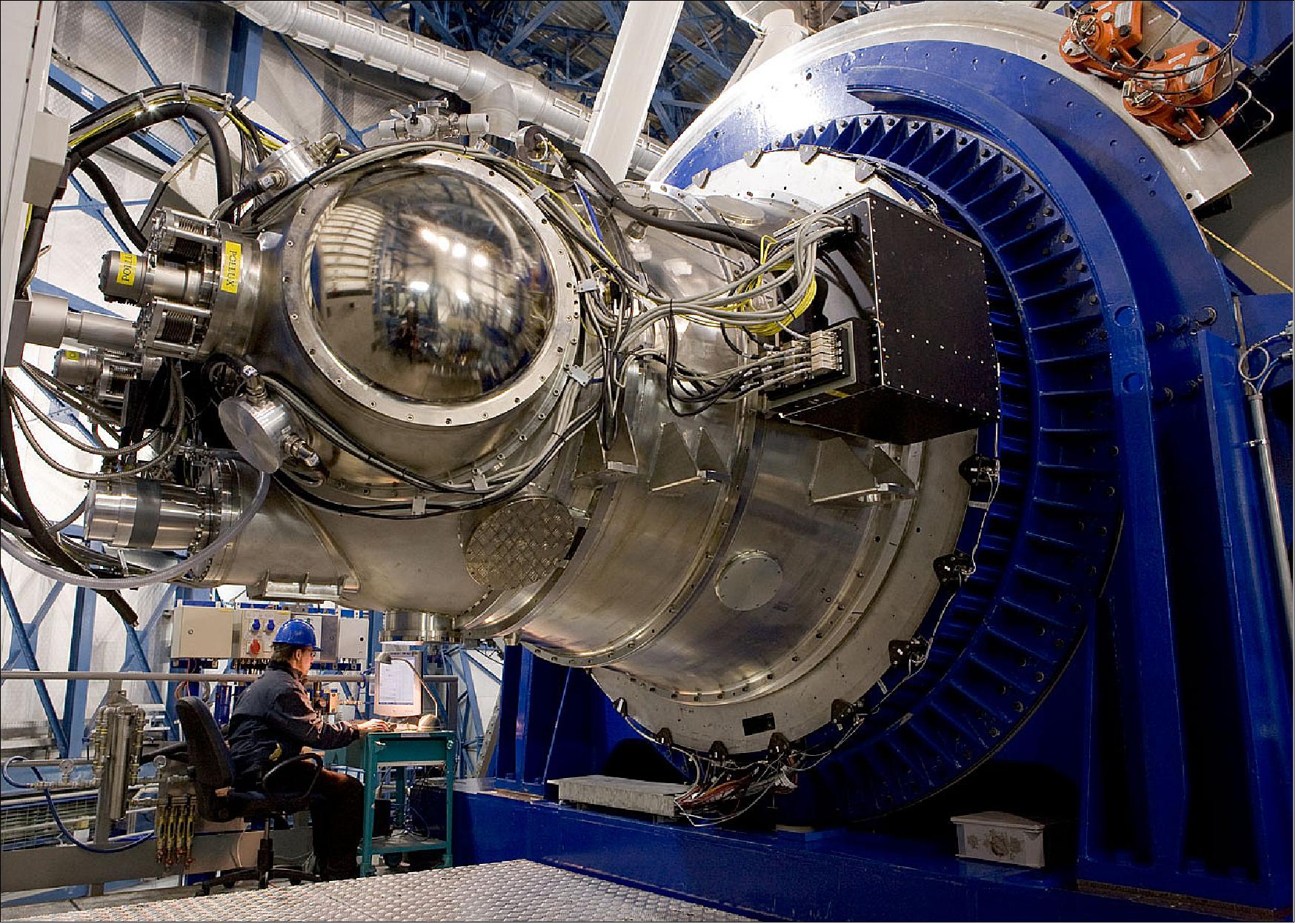
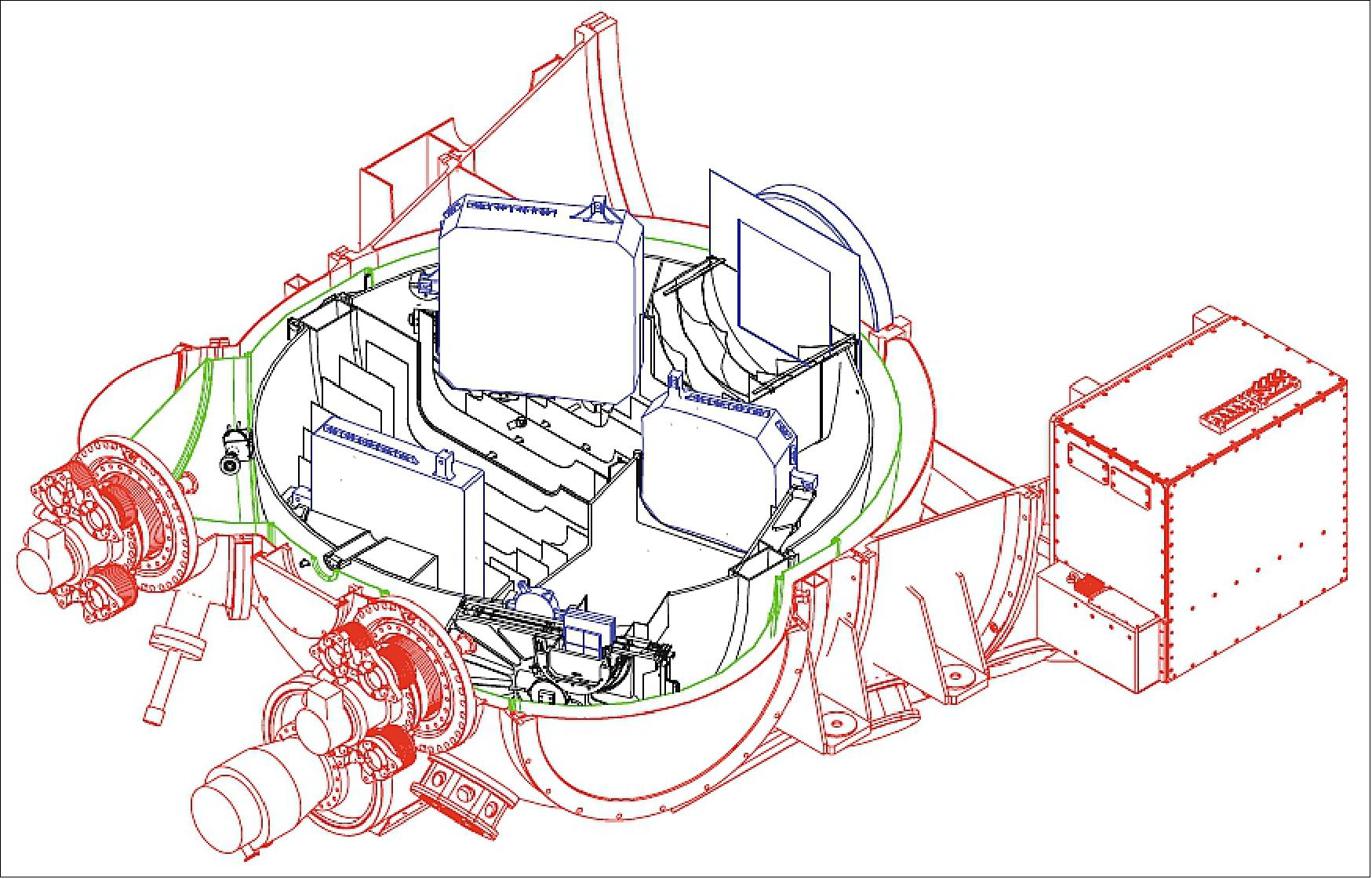
HAWK-I performance: The 7.5' x 7.5' FOV of HAWK-I is covered by four Hawaii-2RG chips of 2048 x 2028 pixels each (1 pixel corresponds
to 0.106'' on the sky). The detectors are separated by gaps of about 15'' as shown in Figure 95. The figure also shows the naming convention of the four detectors. The images of the four detectors are stored together in a single FITS file as four extensions. Note that quadrants 1, 2, 3, 4 are usually, but not necessarily, stored in extensions 1, 2, 4, 3 of the HAWK-I FITS file.
Finally, due to necessary baffling in the all-reflective optical design of HAWK-I, some vignetting at the edges of the field has turned out to be inevitable due to positioning tolerances of the light baffles. The vignetting measured on sky is summarized in Table 3. Note that although the +Y edge vignetting is small in amplitude, it extends to around 40 pixels at <10%.
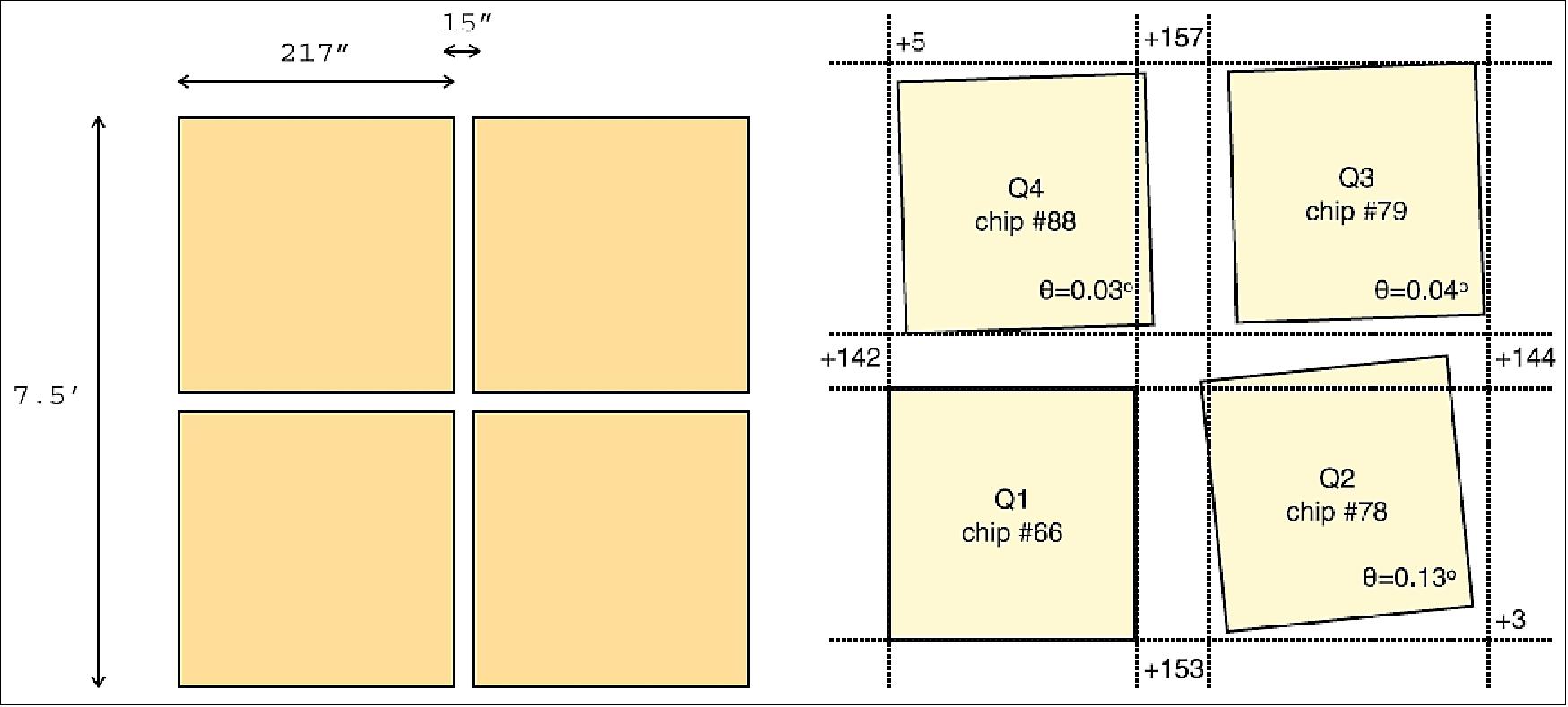
Edge | No of columns or rows vignetted >10% | Maximum vignetting |
+Y | 1 | 14% |
-Y | 8 | 54% |
-X | 7 | 36% |
+X | 2 | 15% |
GRAAL (Ground-layer AOM (Adaptive Optics Module) Assisted by Lasers)
HAWK-I is also designed to work in the future with a GRAAL as part of the AOF (Adaptive Optics Facility) for VLT. GRAAL will improve the quality of HAWK-I images reducing by 12 % in Y and 21% in Ks band the diameter collecting 50% of the energy for 1 arcsec visible seeing conditions over the entire 7.5 arcmin x 7.5 arcmin FOV. 139)
The commissioning instrument for the DSM is a submodule of GRAAL labeled MCM (Maintenance & Commissioning Mode) and will be implemented inside the AO module. One 40 x 40 SH (Shack-Hartmann) retractable WFS (Wave Front Sensor) and its associated optical system will be mounted on the AO structure and will use NGS (Natural Guide-Star) on-axis for wavefront sensing. The AO module consists of the following units (Figure 96):
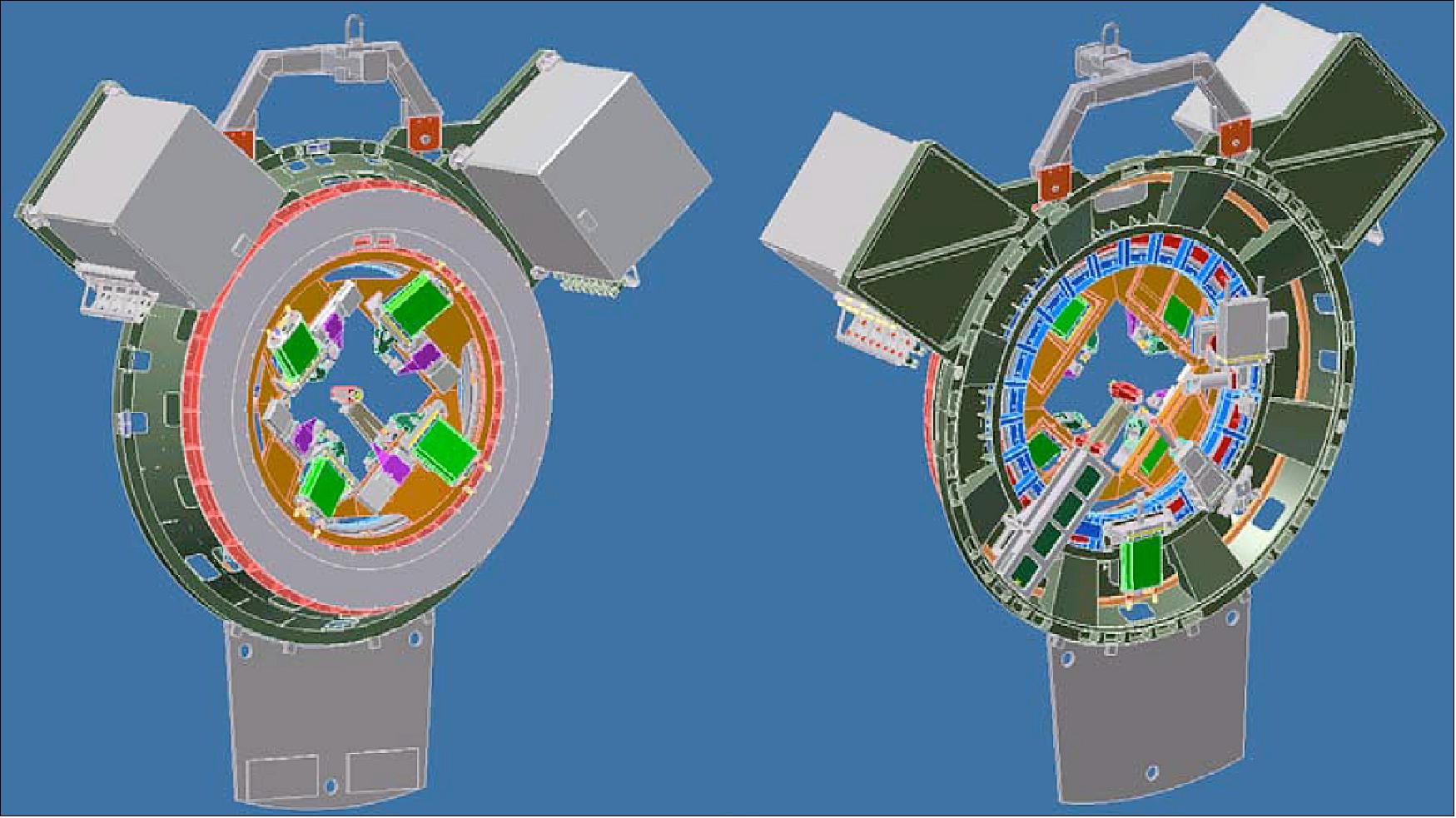
As of 2017, GRAAL is part of AOF and associated with the DSM (Deformable Secondary Mirror) and the 4 Laser Guide Star Facility (4LGSF). It defines an AO system developed to increase the performance of the HAWK-I instrument. Commissioning is proceeding and Science Verification is planned for January 2018, for which applications are invited. 140)
GALACSI (Ground Atmospheric Layer Adaptive Optics for Spectroscopic Imaging)
GALACSI is part of the AOF (Adaptive Optics Facility), and associated with the DSM and the 4LGSF it defines an AO system developed to increase the performance of the MUSE (Multi Unit Spectroscopic Explorer) instrument, a panoramic integral-field spectrograph working at visible wavelength built by a consortium led by CRAL (Centre de Recherche Astrophysique de Lyon).The system GALACSI combined with the MUSE instrument is dubbed MUSE facility.
Note: MUSE entered a new era in 2017 with the advanced capabilities of the AOF (Adaptive Optics Facility). The AOF with Artificial laser stars (4LGSF); deformable active mirrors (ann16078); multiple wavefront sensors GALACSI will develop the full potential of MUSE and is comparable to moving the telescope 900 metres above the Paranal summit, a height free of the effects of the most turbulent layers of the atmosphere, giving much clearer images than before.
GALACSI and GRAAL benefit from several common developments for the AOF and other applications. Specifically these are the DSM and the ASSIST (Adaptive Secondary Setup and Instrument Simulator (AOF test bench)), 4-LGSF, NGC (New General detector Controller) WFS camera and the SPARTA (Real Time Computer platform for the AOF).
FLAMES (Fiber Large Array Multi Element Spectrograph)
LAMES is the multi-object, intermediate and high resolution spectrograph of the VLT. Mounted at the Nasmyth A platform of UT2,FLAMES can access targets over a large corrected field of view (25 arcmin diameter). It consists of three main components: 141)
• A Fiber Positioner (OzPoz) hosting two plates: while one plate is observing the other positions the fibers for the subsequent observations, therefore limiting the dead time between one observation and the next to less than 15 minutes, including the telescope preset and the acquisition of the next field.
• A medium-high resolution optical spectrograph, GIRAFFE (Fiber-fed multi-object spectrograph and part of the VLT) FLAMES facility), with three types of feeding fiber systems : MEDUSA, IFU, ARGUS.
• A link to the UVES (V-Visual Echelle Spectrograph) instrument (Red Arm) via 8 single fibers of 1 arcsec entrance aperture.
Special observing software (FLAMES OS) coordinates the operation of the different subsystems, also allowing simultaneous acquisition of UVES and GIRAFFE observations. For combined observations, the exposure times for UVES and GIRAFFE do not need to be the same. Note that it is not possible to observe simultaneously in two GIRAFFE modes, or to observe the same target simultaneously with the two spectrographs.
Instrument capabilities:
• GIRAFFE is a medium-high (R=5500-65100) resolution spectrograph for the entire visible range, 370-950 nm. It is equipped with two gratings and several filters are available to select the required spectral range. Five additional fibers allow simultaneous wavelength calibration of every exposure. Each object can be only observed in one, or a fraction of a single echelle order at once. The fiber system feeding GIRAFFE consists of the following components:
- The MEDUSA fibers, which allow up to 132 separate objects(including sky fibers) to be observed in one go. Two separate sets of MEDUSA fibers exists, one per positioner plate. Each fiber has an aperture of 1.2 arcsec on the sky.
- The IFU (Integral Field Unit): each deployable IFU consists of a rectangular array of 20 microlenses of 0.52 arcsec each,giving an aperture of 2 x 3 arcsecs. For each plate there are 15 IFU units dedicated to objects and another 15 dedicated to sky measurements. In the latter, only the central fiber is present.
- ARGUS: the large integral field unit ARGUS is mounted at the center of one plate of the fiber positioner and consists of a rectangular array of 22 x 14 microlenses. Two magnification scales are available: ``1:1'' with a sampling of 0.52 arcsec/microlens and a total aperture of 11.5 x 7.3 arcsec, and ``1:1.67'' with 0.3 arcsec/microlens and a total aperture of 6.6 x 4.2 arcsec. In addition, 15 ARGUS sky fibers can be positioned in the 25 arcmin field.
GIRAFFE is equipped with one 2 x 4K EEV CCD (15 µm pixels),with a scale of 0.3 arcsec/pixel in MEDUSA, IFUs and ARGUS direct mode,and a scale of 0.15 arcsec/pixel in the enlarged ARGUS mode. GIRAFFE is operated with 39 fixed setups (31 high resolution + 8 low resolution modes).
• UVES is the high resolution spectrograph at UT2 of the VLT (see Section6.4). It was designed to work in long slit mode but it has been possible to add a fiber mode (6 to 8 fibers, depending on setup and/or mode) fed by the FLAMES positioner to its Red Arm only. Only the three standard UVES Red setups are offered, with central wavelength of 520,580 and 860 nm, respectively.
The standard readout mode of FLAMES-UVES is 225 kHz (unbinned) which ensures low readout noise. As of P76 a high-speed readout mode (625 kHz, unbinned, low gain) with increased readout noise but less overheads is offered in visitor mode only.
With an aperture on the sky of 1 arcsec, the fibers project onto 5 UVES pixels giving a resolving power of 47000. For faint objects and depending on the spectral region, one or more fibers can be devoted to recording the sky contribution. In addition, for the 580 nm setup only, a separate calibration fiber is available to acquire simultaneous ThAr (Thorium Argon) calibration spectra. This allows very accurate radial velocity determinations. In this configuration, 7 fibers remain available for targets on sky.
FORS2 (FOcal Reducer/low dispersion Spectrograph 2)
FORS2 is a multi mode (imaging, polarimetry, long slit and multi-object spectroscopy) optical instrument mounted on the UT1 Cassegrain focus of VLT. FORS2 works in the wavelength range 330-1100 nm. Two different magnifications can be used with pixel scales of 0.25''/pixel (with the Standard Resolution collimator) and 0.125''/pixel (with the High Resolution collimator). The corresponding field sizes are 6.8' x 6.8' and 4.25' x 4.25', respectively. The two different magnifications are chosen by selecting one of two different collimators, hence each magnification has to be calibrated independently. An unbinned CCD readout mode is only offered for applications that specifically require it and must be explicitly requested in the proposal. 142)
Imaging: FORS2 offers imaging with a wide range of broad- and narrow-band filters. The narrow-band filters are exchangeable and chosen from a large range available filters depending on the user-request. It is also possible to use the jaws of the MOS unit as occulting bars to avoid saturation by unwanted bright objects.
Spectroscopy: FORS2 has a number of grisms available with different resolutions, including a number of high-throughput Volume-Phased Holographic (VPH) grisms.
Long-Slit (LSS) mode: FORS2 has 9 long-slits with fixed widths of between 0.3'' and 2.5''.
Moveable Slitlets (MOS) mode: FORS2 has a set of 19 pairs of arms that can be moved into the focal plane to form slitlets with user-defined widths.
Spectroscopic Mask (MXU) mode: In addition, FORS2 offers the possibility to insert in the focal plane a mask where slits of different length, width and shape can be cut with a dedicated laser cutting machine. Up to 10 masks can be mounted in a mask unit inside the instrument and each mask can have up to 470 slits, depending on the grism and filter used. The FIMS tool must be used for Phase 2 preparation of the mask cutting files. Performance in this mode is equivalent to that of the standard MOS mode.
Polarimetry: The polarimetric modes allow the measurement of linear and circular polarization, both for direct imaging (IPOL) and spectroscopy (PMOS). The position angle and degree of the linear polarization or of the circular polarization of an object are determined by using a remotely controlled rotatable lambda/2- or lambda/4-plate in front of the Wollaston prism.
Note: a field-dependent instrumental polarization pattern was discovered in the FORS1 linear polarization mode. This spurious polarization field shows a high degree of axial symmetry and smoothly increases from less than 3x10e-4 on the optical axis to 7x10e-3 at a distance of 3 arcmin from it (V band). The problem is yet to be characterized on FORS2, but it is likely it will have the same characteristics.
Detector: Two detector systems are available for FORS2. The first is a detector consisting of a mosaic of two 2k x 4k MIT CCD (15 µm pixels), which provides excellent red sensitivity (> 750 nm) and very low fringing. The second is a mosaic of two 2k x 4k E2V CCDs (15 µm pixels), which was formerly the FORS1 (post-upgrade) detector. This is very sensitive in the blue range (< 500 nm) but shows a lot of fringes above 650 nm. The E2V detector is currently only available in Visitor Mode and must be requested at phase I.
Instrument mode | Mag-limit |
Direct Imaging (E2V) | U=25.9, B=27.6, V=27.3, R=26.6, I=25.8 |
Direct Imaging (MIT) | U=24.5, B=27.1, V=27.0, R=26.7, I=25.7, z=24.7 |
The direct imaging "Mag-limit" is the broad band magnitude calculated for a point source of zero color (A0V star) which would give a S/N of 5 in one hour with dark sky, clear conditions, a seeing FWHM of 0.8'' and an airmass of 1.2. The U, B, V magnitudes are calculated using the broadband filters of the standard instrument configuration.
Instrument mode | Rs = λ/Δλ | Mag-limit |
Longslit Spectroscopy [1] | 260-2600 | R=24.2-23.3 |
MOS - movable slits [2] | 260-2600 | R=24.2-23.3 |
MXU - exchangeable masks | 260-2600 | R=24.2-23.3 |
Spectropolarimetry | 260-2600 | R=19.2-17.2 |
Legend to Table 5: [1] In longslit spectroscopy the slit is chosen out of a set of 9 slits with fixed width between 0.3'' and 2.5''. [2] In multiobject spectroscopy one may have 19 slitlets of length alternating between 20'' and 22''.
The spectroscopic Mag-limit given in the table above are the R-band magnitudes of a point source of zero color which would give a S/N of5 per pixel at 650 nm (grisms 150 I and 600 R) in the continuum in one hour with dark sky, clear conditions, a seeing FWHM of 0.8'', an airmass of 1.2, and using a 1.0" slit and the SR-collimator. The two limits given are for the two representative resolutions. The limits on spectropolarimetry are those which for linear/circular polarization allow a 1% accuracy in determination of degree of polarization for one hour of total integration time.
FORS Instrumental Mask Simulator (FIMS): To prepare precise target acquisitions at Phase 2, ESO provides the FIMS software tool. FIMS is required when using FORS2 in several spectroscopic modes, and is also used to prepare occulting bar imaging and spectropolarimetry observations. Phase 1 proposers who wish to justify their time request by optimizing movable or MXU slitlet positions during Phase 1, may find it useful to download and install FIMS. Please refer to the FIMS page for instructions on how to install FIMS and to the FIMS User's Manual on how to use FIMS.
Accurate Astrometry or Pre-imaging Required: Highly accurate relative astrometry is required for any observing mode which in Phase 2 will make use of FIMS or blind offset acquisitions. The mask preparation with FIMS requires input images which are astrometrically corrected within the definitions and precision given below. DSS images will, in almost all cases, not be suitable for the task.
In general the relative astrometry must be known to better than 1/6 of the slit widths all over the field of view. Relative astrometry here means that the slit positions must be known relative to those of reference stars in the field of view with the given precision.
If images of adequate quality are not available, Phase 1 proposers must apply for pre-imaging defined as a separate run in the Phase 1 proposal and should be clearly marked as pre-imaging in "instrument configuration" section of the proposal. Failure to do so will, in case the program is approved for execution, result in the deduction of the time necessary for pre-imaging from the allocation destined to the main part of the project. As a rule, pre-imaging runs are carried out in Service Mode, even for programs whose main (spectroscopic) runs are conducted in Visitor Mode.
“Of all instruments at Paranal, this one is the Swiss Army knife”. This is the way Henri Boffin, the instrument scientist behind the FOcal Reducer and low dispersion Spectrograph 2 or FORS2, describes the instrument that is most in demand at ESO's Paranal Observatory. The key to success is that FORS2, installed on UT1 (Antu) of the Very Large Telescope (VLT), is able to study many different astronomical objects in many different ways. 143)
For example, FORS2 can take images of relatively large areas of the sky with very high sensitivity. No wonder that some of the most iconic photos taken with the VLT used this instrument (see eso9845d, eso9948f, eso0202a, eso0338a, eso0338c, eso0617a, and more recently eso1244a and eso1348a).
But FORS2 can also take spectra of one (eso9920r), two or even several tens of objects in the sky simultaneously (eso0223b). “When used as a spectrograph, FORS2 disperses the light into very sophisticated rainbows that help astronomers study chemical composition or estimate the distances of remote objects,” says Boffin.
And this is not all. FORS2 can also measure the polarization of light and is therefore used at the VLT to determine whether some astronomical objects have strong magnetic fields.
Observations with FORS2 and its twin brother FORS1 (decommissioned in 2009) have together led to almost 1800 papers to be published in scientific journals as of 2014, with an average of about 100 scientific papers per year. “Basically, whatever you can think of, you can do it with FORS2. Apart from making the coffee the astronomers need at night!”
Science highlights with FORS
• Constraining size, shape and color of first-observed interstellar asteroid (eso1737)
• Observations of first light from gravitational wave source (eso1733)
• First detection of titanium oxide in an exoplanet (eso1729)
• Observations of neutron star that possibly confirm 80-year-old prediction about the vacuum (eso1641)
• Observations of galaxy clusters (eso1548)
• Alignments between supermassive black hole axes and large-scale structure revealed (eso1438)
• FORS helps explain shape of planetary nebula (eso1244)
• FORS was used to spot “Dark Galaxies”, an early phase of galaxy formation, which are essentially gas-rich galaxies without stars (eso1228)
• VLT “rediscovered” life on Earth (eso1210)
• Comet Halley in the cold – the most distant view of a regular visitor (eso0328)
• Cosmological gamma-ray bursts and hypernovae linked by FORS1 and FORS2 observations (eso0318)
• FORS1 and FORS2 broke several distance records: the most distant gamma-ray burst (eso0034), the most distant group of galaxies (eso0212), the most distant galaxy (eso0314)
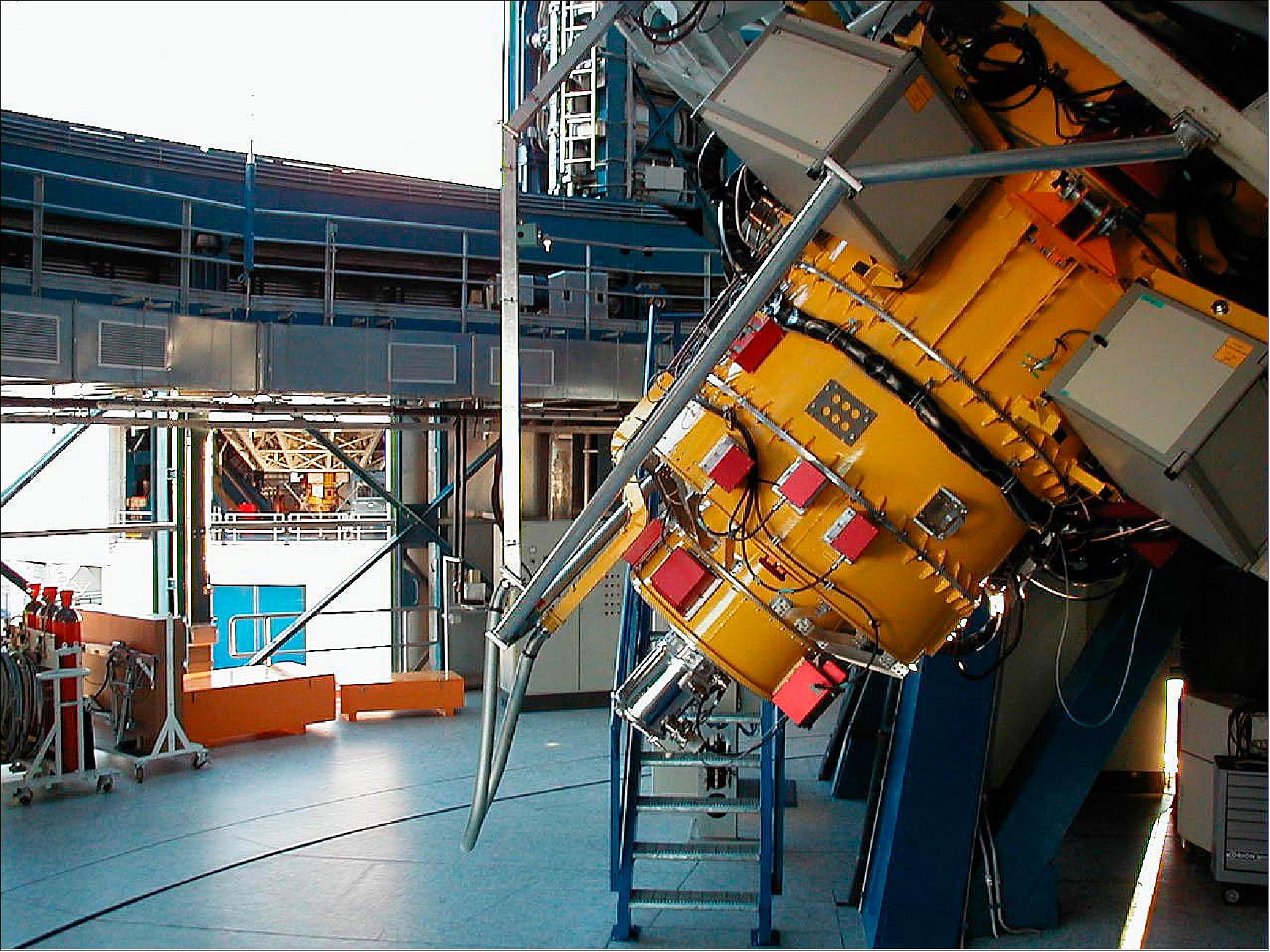
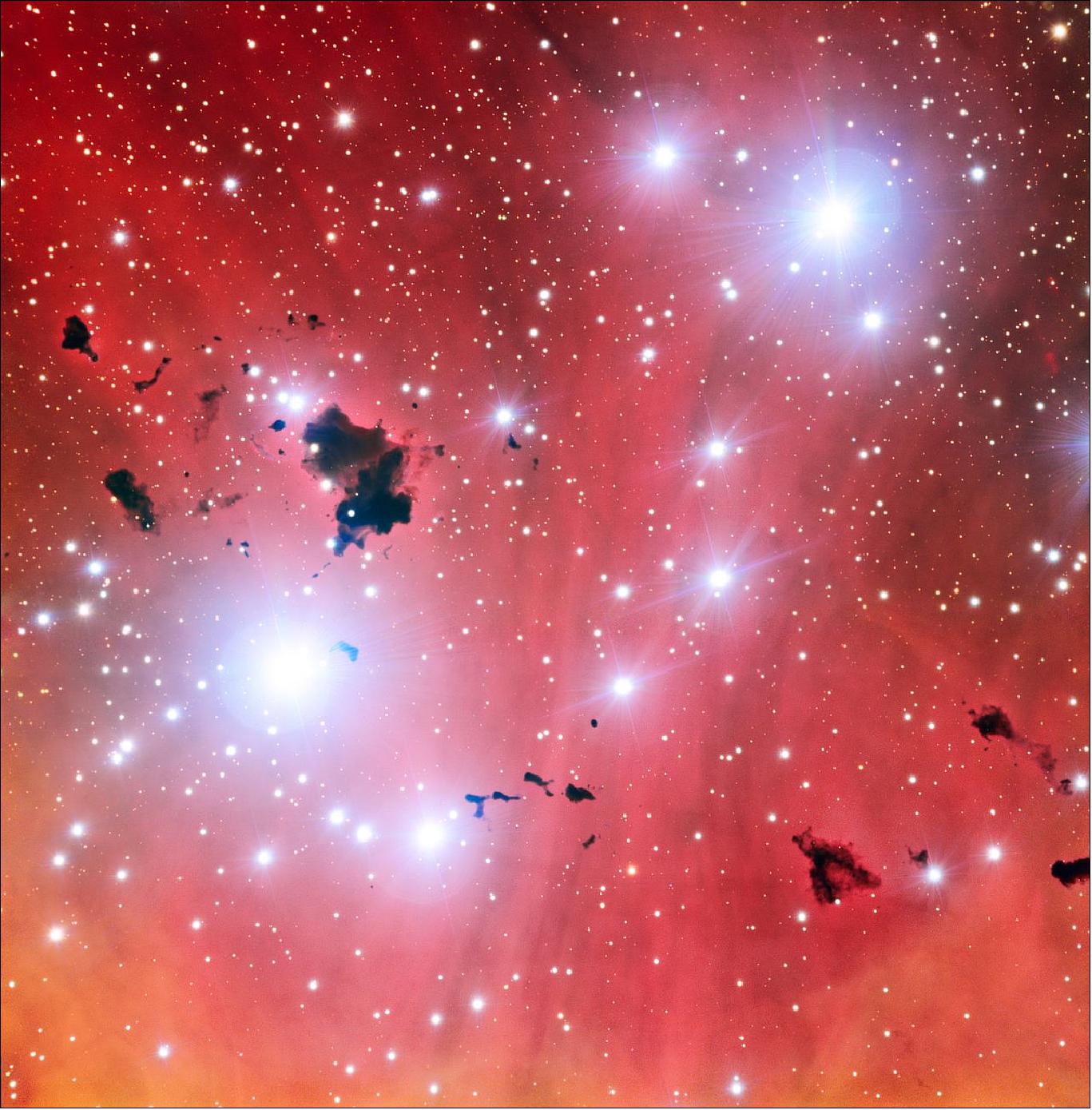
MATISSE (Multi AperTure mid-Infrared SpectroScopic Experiment)
MATISSE is a second-generation interferometry instrument for the ESO VLTI (Very Large Telescope Interferometer). The interconnection of three or four telescopes makes it possible to capture visibilities and closure phases and allows pictures in the mid infrared range to be reconstructed. The maximum baseline length of 200 m (the distance between two telescopes) makes for a high resolution in the generated images. 147) 148) 149)
MATISSE operates in the wavelength range from 2.8 µm to 13 µm. The combined light of the telescopes is spectrally dispersed in order to measure the wavelength dependence of the visibility and closure phase. Two imaging sensors are used to cover the wide wavelength range. One imaging sensor (HAWAII/2RG) covers the wavelength range of the L and M bands (2.8 µm to 5.2 µm), and the other imaging sensor (Aquarius) covers the N band (8 µm to 13 µm). The HAWAII 2RG imaging sensor features low readout noise, while the Aquarius imaging sensor provides a high readout rate. The Aquarius imaging sensor provides precise measurements despite the high thermal background radiation.
MATISSE Consortium:
- INSU: Observatoire de la Cote d'Azur and University of Sophia-Antipolis, Nice, France
- MPIA (Max-Planck-Institut für Astronomie), Heidelberg, Germany
- MPIfR (Max-Planck-Institut für Radioastronomie), Bonn, Germany
- NOVA (Netherlands Research School for Astronomy), Leiden, The Netherlands
- Institut für Theoretische Physik und Astrophysik, University of Kiel, Germany
- Institut für Astronomie, University of Vienna, Austria.
Scientific objectives 150)
The objective of MATISSE is image reconstruction. It will extend the astrophysical potential of the VLTI by overcoming the ambiguities existing in the interpretation of simple visibility measurements. MATISSE will measure closure phase relations thus offering an efficient capability for image reconstruction.
The unique performance of MATISSE is partly related to the existence of the four large apertures of the VLT (UTs) that permits to push the sensitivity limits to values required by selected astrophysical programs such as the study of AGN (Active Galactic Nuclei) and protoplanetary discs.
Moreover, the evaluated performance of MATISSE is linked to the availability of ATs (Auxiliary Telescope for the VLTI) which are relocatable in position in about 30 different stations allowing the exploration of the Fourier plane with up to 200 meters baseline length. Key science programs using the ATs cover for example the formation and evolution of planetary systems, the birth of massive stars as well as the observation of the high-contrast environment of hot and evolved stars.
During Phase A, three constituents of the planetary systems were identified for which MATISSE will bring new insight:
• Protoplanetary disks (T Tauri, HAeBe) and planetary debris disks (beta Pic type),
• Minor bodies of our solar system: main belt asteroids and the comets,
• Young giant planets and so-called hot Jupiter-like planets.
The AMBER (Astronomical Multi-BEam combineR (VLTI Instrument)) and MIDI (Mid-infrared Interferometric Instrument (VLTI)) instruments have started to observe the brightest protoplanetay disks in the infrared sky, approximately a dozen objects. The current capabilities of other observatories are similar (see e.g. Keck Interferometer).
In addition, in our own solar system, a few asteroids have been observed by MIDI (Delbo et al. 2009, ApJ 694, 1228), demonstrating the feasibility to characterize solar system minor bodies with interferometry.
However, for extrasolar planet detections and/or characterization, interferometry has not reached enough dynamic range so far to successfully observe any of them (see e.g. Matter et al. 2010, A& A 515, 69 for MIDI, or Millour et al. 2008, SPIE 7013, 41 and Absil et al. 2010 in press for AMBER).
The second important science topic is active galactic nuclei. The nominal MATISSE sensitivity in blind mode at N-band is 0.6 Jy in 4-telescope mode, similar to the nominal MIDI sensitivity, although to date MIDI has been used to obtain correlated fluxes of AGNs down to 0.17 Jy. The nominal L-band sensitivity from the performance analysis is 0.1 Jy. For MIDI observations, various lists of AGNs have been assembled, often based on the list of Veron-City and Veron 2006 (A& A 455, 773).
Instrument description
MATISSE is a mid-infrared spectro-interferometer combining the beams of up to 4 UTs/ATs of the VLT Interferometer. The number of combined beams is 4. The instrument will be able to operate with 3 or 2 beams. The instrument sensitivity, sampling and throughput are optimized for L- and N-band. The L-band is specified from 3.2 to 3.9 µm and the N-band from 8.0 to 13.0 µm. MATISSE will operate also in M-band, from 4.5 to 5.0 µm. The L-, M- and N-bands can be observed simultaneously.
The instrument will be able to observe with different spectral resolutions. 2 spectral resolutions are possible in N-band (R ~ 30, R ~ 200) and 3 in L&M-bands (R ~ 30, R ~ 500 for L- and M-band, R ~1000 for L-band only). Due to readout time, the full simultaneous coverage of the L- & M- bands in low and medium resolutions, and the full coverage of the L- band in high spectral resolution require an external fringe tracker.
MATISSE will measure: coherent flux, visibilities, closure phases and differential phases. Differential visibilities can also be derived. These quantities will be measured as a function of the wavelength in the selected spectral bands and resolutions.
MATISSE will have an imaging mode (2D image observation without dispersion) for field acquisition and a non-interferometric imaging mode (photometric channels) for flux measurements. It will have also internal devices allowing detector calibration (flat-fielding, bad pixel map), relative flux calibration, wavelength calibration, and instrumental contrast measurement.
MATISSE is a four-beam experiment with a multi-axial global combination. The interferometric beam and the photometric beams receive, respectively, the I and P fraction of the incoming flux (observations without photometric channels are also possible). For an observation with 4 telescopes with photometric channels, 5 images are produced on the detector (4 photometric channels and the interferometric one).During observations with 4 telescopes, the interferogram (in each spectral channel) contains a pattern with 6 fringe periods and is dispersed in the spectral direction. The spatial size of this interferometric channel is larger than the photometric ones in order to optimize the sampling of the 6 fringe structures. The beam combination is made by the camera optics. At this level, the beam configuration is non redundant (separation B between beams equal to 3D, 9D and 6D where D is the spatial diameter of the beam) in order to avoid crosstalk between the fringe peaks in the Fourier space.
The Fourier transform of each spectral column of the interferometric image is thus composed by 6 fringe peaks centered at different frequencies Bij/λ (3 D/λ, 6 D/λ, 9 D/λ, 12 D/λ, 15 D/λ, 18 D/λ) and a low frequency peak that contains the object photometry and the thermal background coming from the 4 telescopes. In order to measure the coherent fluxes with a good accuracy, the design of MATISSE is based on the use of spatial filters, including image and pupil stops.
In order to measure closure and differential phases with a good accuracy, a beam commutation can be made in order to reduce the effect of the instrumental defects on the useful signal.
To measure the coherent fluxes and all the derived interferometric measures such as the differential visibility and phase and the closure phase, the key problem is to eliminate the cross talks between the low frequency peak and all the other peaks that introduce sensitivity of the fringe peaks to variations of the thermal background. Two methods are combined in MATISSE to ensure this result with a large margin: spatial modulation like in AMBER combined with temporal modulation like in MIDI. In addition, to measure the absolute visibility we also have to find the true source photometry. To do that, it is necessary to separate the stellar flux from the sky background, using chopping.
Some devices such as artificial sources, hot screen, optics for flat field or pupil visualization, special material for spectral calibration are implemented in the instrument in order to perform alignment, test, maintenance, calibration and acquisition operations. MATISSE will operate with 2 modes:
• High Sensitivity mode: this mode has no photometry and all photons are collected in the interferometric beam. This maximizes the sensitivity and also the SNR on the coherent flux and the differential and closure phases. Chopping is optional in this mode.
• Simultaneous Photometry mode: this mode uses photometry (2/3 of flux in the interferometric channel and 1/3 in the photometric ones) and chopping to measure the average source photometry and therefore extract the visibility from the coherent flux (the chopping period is longer than the coherence time and hence the chopping has no influence on the limiting magnitude). For an observation with 4 telescopes with photometric channels, 5 images are produced on the detector (4 photometric channels and the interferometric one).
MATISSE Project Development Status (Ref. 150)
• Preliminary acceptance at Paranal Observatory, Chile: Scheduled for 2019
• First light on telescope: February 2018
• Preliminary acceptance Europe: September 2017
• Final Design Review, March 2012
• Optical and Cryogenics Final Design Review, September 2011
• Preliminary Design Review, December 2010.
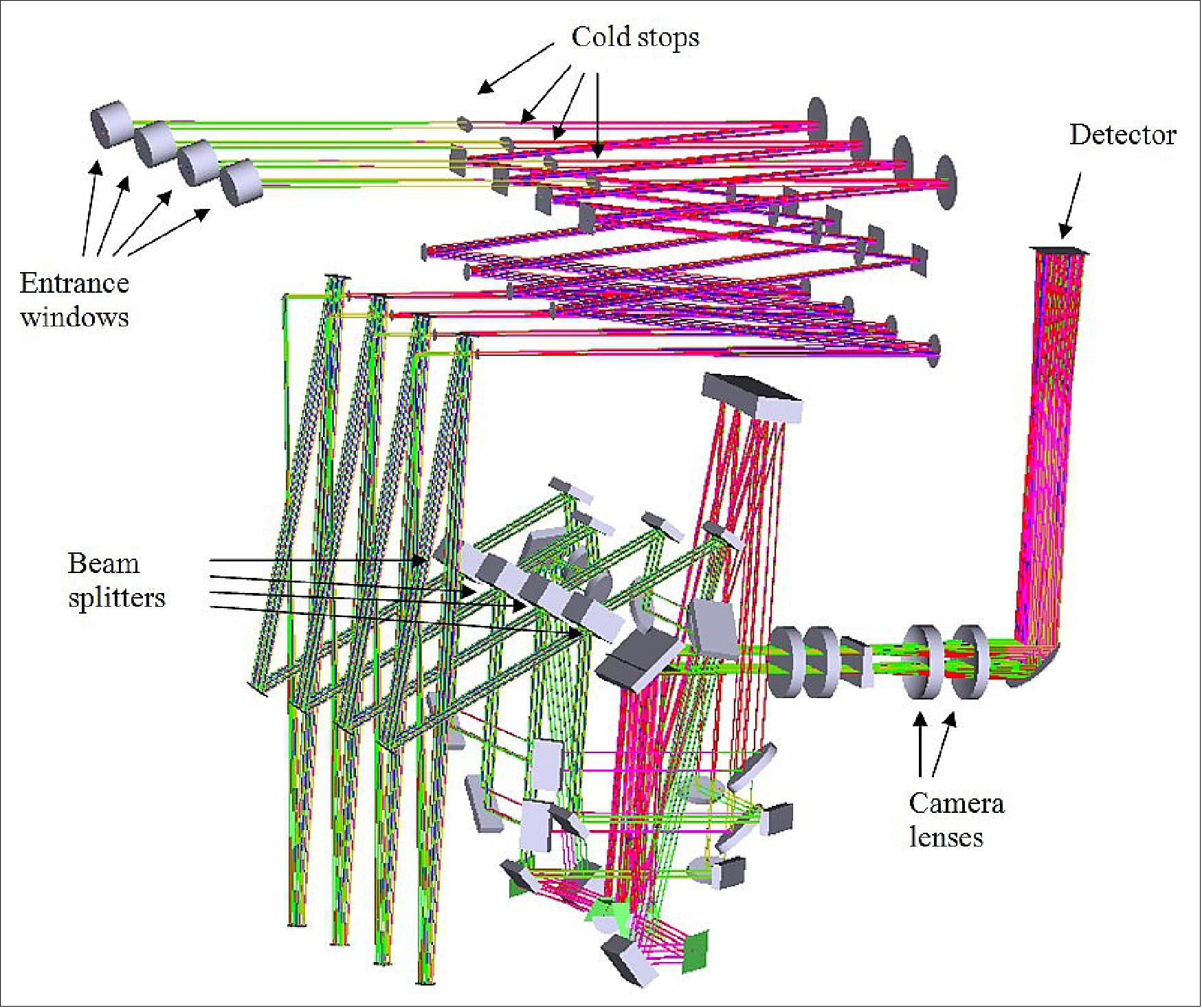
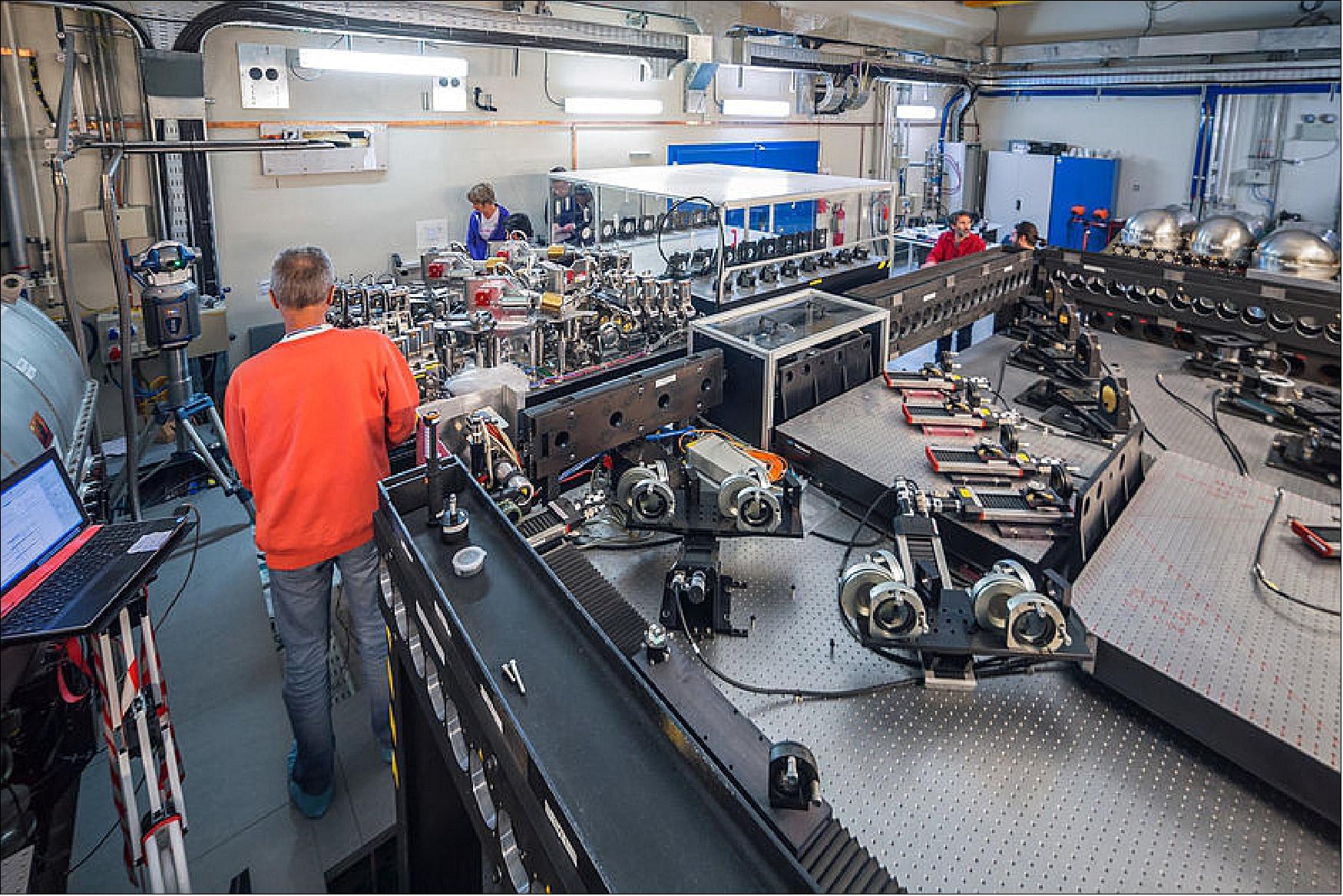
GRAVITY
Gravity is a four way beam combination second generation instrument for the VLTI (Very Large Telescope Interferometer ). Its main operation mode makes use of all four 8 m UTs (Unit Telescopes) to measure astrometric distances between objects located within the 2 arcsec FOV (Field of View) of the VLTI. With the sensitivity of the UTs and the ~10 µas (micro arcsec) astrometric precision, it will allow to measure orbital motions within the galactic center with unprecedented precision. Other modes of the instrument will allow imaging and the use of the 1.8 m Auxiliary Telescopes. 152)
GRAVITY was developed by a collaboration consisting of the Max Planck Institute for Extraterrestrial Physics (Germany), LESIA of Paris Observatory–PSL/CNRS/Sorbonne Université/Univ. Paris Diderot and IPAG of Université Grenoble Alpes/CNRS (France), the Max Planck Institute for Astronomy (Germany), the University of Cologne (Germany), the CENTRA–Centro de Astrofísica e Gravitação (Portugal) and ESO. The PI (Principal Investigator) of GRAVITY is Frank Eisenhauer.
GRAVITY is a new instrument to coherently combine the light of the European Southern Observatory Very Large Telescope Interferometer to form a telescope with an equivalent 130 m diameter angular resolution and a collecting area of 200 m2. The instrument comprises fiber fed integrated optics beam combination, high resolution spectroscopy, built-in beam analysis and control, near-infrared wavefront sensing, phase-tracking, dual-beam operation, and laser metrology. GRAVITY opens up to optical/infrared interferometry the techniques of phase referenced imaging and narrow angle astrometry, in many aspects following the concepts of radio interferometry. This article gives an overview of GRAVITY and reports on the performance and the first astronomical observations during commissioning in 2015/16. 153)
Science Objectives
GRAVITY will carry out the ultimate empirical test to show whether or not the Galactic Center harbors a black hole (BH) of four million solar masses and will finally decide if the near-infrared flares from Sgr A* originate from individual hot spots close to the last stable orbit, from statistical fluctuations in the inner accretion zone or from a jet. If the current hot-spot interpretation of the near-infrared (NIR) flares is correct, GRAVITY has the potential to directly determine the spacetime metric around this BH. GRAVITY may even be able to test the theory of general relativity in the presently unexplored strong field limit. GRAVITY will also be able to unambiguously detect intermediate mass BHs, if they exist. It will dynamically measure the masses of supermassive BHs (SMBHs) in many active galactic nuclei, and probe the physics of their mass accretion, outflow and jets with unprecedented resolution. Furthermore, GRAVITY will explore young stellar objects, their circumstellar discs and jets, and measure the properties of binary stars and exoplanet systems. In short, GRAVITY will enable dynamical measurements in an unexplored regime.
Instrument Description
GRAVITY provides high precision narrowangle astrometry and phase-referenced interferometric imaging in the astronomical K-band (2.2 µm). It combines the light from four Unit Telescopes (UTs) or Auxiliary Telescopes (ATs), measuring the interferograms from six baselines simultaneously. The instrument has three main components: the IR wavefront sensors; the beam-combiner instrument; and the laser metrology system.
The GRAVITY IR wavefront sensors will be mounted in the Coudé rooms of the UTs and will command the existing Multiple Application Curvature Adaptive Optics (MACAO) deformable mirrors. The system can work on either of the two beams (on-axis or off-axis) behind the PRIMA star separators. Any additional tip/tilt from the beam relay down to the VLTI laboratory will be corrected by a dedicated laser-guiding system. Low frequency drifts of the field and pupil will be corrected by GRAVITY’s internal acquisition and guiding camera. The interplay of these systems will guarantee an unperturbed and seeing-corrected beam at the entrance of the beam-combiner instrument in the VLTI laboratory. The interferometric instrument will work on the 2 arsec (for UTs) or 4 arcsec (for ATs) VLTI field of view. Both the reference star and the science object have to lie within this field of view. The light of the two objects from the four telescopes is coupled into optical fibres for modal filtering, to compensate for the differential delay and to adjust the polarisation. The fibres feed two integrated optics beam combiners and the coherently combined light is dispersed in two spectrometers. A low resolution spectrometer provides internal phase- and group-delay tracking on the reference star, and thus enables long exposure times on the science target. Three spectral resolutions with up to R~4000 are implemented in the science spectrometer, and a Wollaston prism provides basic polarimetry.
GRAVITY will measure the visibility of the reference star and the science object simultaneously for all spectral channels, and the differential phase between the two objects. This information will be used for interferometric imaging exploring the complex visibilities, and for astrometry using the differential phase and group delay. All functions of the GRAVITY beam-combiner instrument are implemented in a single cryostat for optimum stability, cleanliness, and thermal background suppression. The internal path lengths of the VLTI and GRAVITY are monitored using dedicated laser metrology. The laser light is back-propagated from the beam combiner and covers the full beam up to the telescope spider above the primary mirror. GRAVITY will make use of high-speed IR photoncountingdetector arrays in both the adaptive optics systems and the fringe tracker. These devices do not suffer from high readoutnoise, which in current IR arrays is tenor more electrons per pixel at framerates of a few hundred Hz.
The GRAVITY system is not a monolithic instrument. 154) It is a collection of subsystems that aims to precisely control the wavefront of the incoming light and its path through the VLTI system before the actual combination of beams takes place and interference fringes are created. A unique aspect of GRAVITY, and the first time this is ever realized, is its ability to interfere the light coming from either a single astronomical source (single-field mode or on-axis) or from two sources simultaneously (dual-field mode or off-axis). In dual-field, the GRAVITY system can perform phase referenced observations supported by the accurate knowledge of the path length which is assessed by a laser system. In this mode of observation, the interferometric phase of the primary star is calibrated to that of the secondary against the detrimental influence of the atmosphere. This enables highly accurate angle measurements on sky and is the basis for GRAVITY's astrometric observing mode. In GRAVITY's imaging observing mode, dual-field observations allow to observe relatively faint targets and use a brighter star as the fringe-track star. The difference between the two modes of GRAVITY is the observation strategy and the use of the laser metrology to measure the light-path.
The subsystems of GRAVITY include:
• The IR wavefront sensing system CIAO (Coudé Infrared Adaptive Optics). CIAO is located in each of the UT coude room and it will operate with the deformable mirror of the MACAOs (Multiple Application Curvature Adaptive Optics).
• A polarization control system to counteract polarization effects in the VLTI. GRAVITY can work either in a split or a combined polarization mode.
• An active pupil guide system including LED sources mounted on each of the telescope spiders.
• A field-guide system to track the position of the source and ensure proper injection into mono-mode fibers.
The overall GRAVITY system interacts and works in harmony with the VLT-I system of telescopes and delay lines. The operation of various GRAVITY subsystems is transparent to the user.
The single and dual field modes. The primary unit of GRAVITY is the Beam Combining Instrument (BCI) that performs the acquisition process and provides the interferometric fringes. The GRAVITY BCI is cryogenically cooled and physically located in the VLT-I laboratory. Within the BCI cryostat, a field is separated and two stars find their way into either the science channel or the fringe-tracking channel. In single-field the FT channel and SC channel receive light from the same star which is split 50%-50%. The GRAVITY fringe-tracker (FT) forms an integral part of the observational approach, i.e. GRAVITY science observations are always done with active fringe-tracking. The FT fringe position is analyzed at a frequency of approximately a kHz in order to correct for the atmospheric and instrumental piston (i.e. a residual optical path difference between beams) by modulating piezo mounted mirrors within the instrument. The FT star thus allows longer detector integration times in the science channel (SC, up to 60 seconds) without compromising the contrast of the fringe pattern. In dual field mode (astrometric or imaging), the fringes of one star are formed in the science channel, and those of the other star in the fringe tracker channel. The two astronomical sources can have an angular separation up to 2 arcsec when observing with the UTs, or 4 arcsec with the ATs. For separations up to 0.4 arcsec and 1.6 arcsec on the UTs and ATs, respectively, the dual-field "on-axis" set-up us used. In this case, the light is split using a beam splitter so that only 50% of the light from each source are injected into the FT and SC channels. In the dual field "off-axis" setup, for larger separations, a roof-top mirror is used and 100% of the light of the FT and SC objects reach the respective fibers.
GRAVITY delivers spectrally dispersed interference fringes that allow stellar interferometry. The FT spectrometer always operates at low spectral resolution (R ~ 22). Taking advantage of the longer integration times, the science channel records the entire K-band at each of the three implemented spectral resolutions of R ~ 22, 500 and 4000. The fringes give access to interferometric quantities such as absolute and differential visibility, spectral differential phase and closure phase. These quantities provide information of physical phenomena at a spatial resolution that can reach 2 mas (depending on the VLT-I baseline), as well as time-resolved differential astrometry at the exquisite accuracy of a few tens of µas.
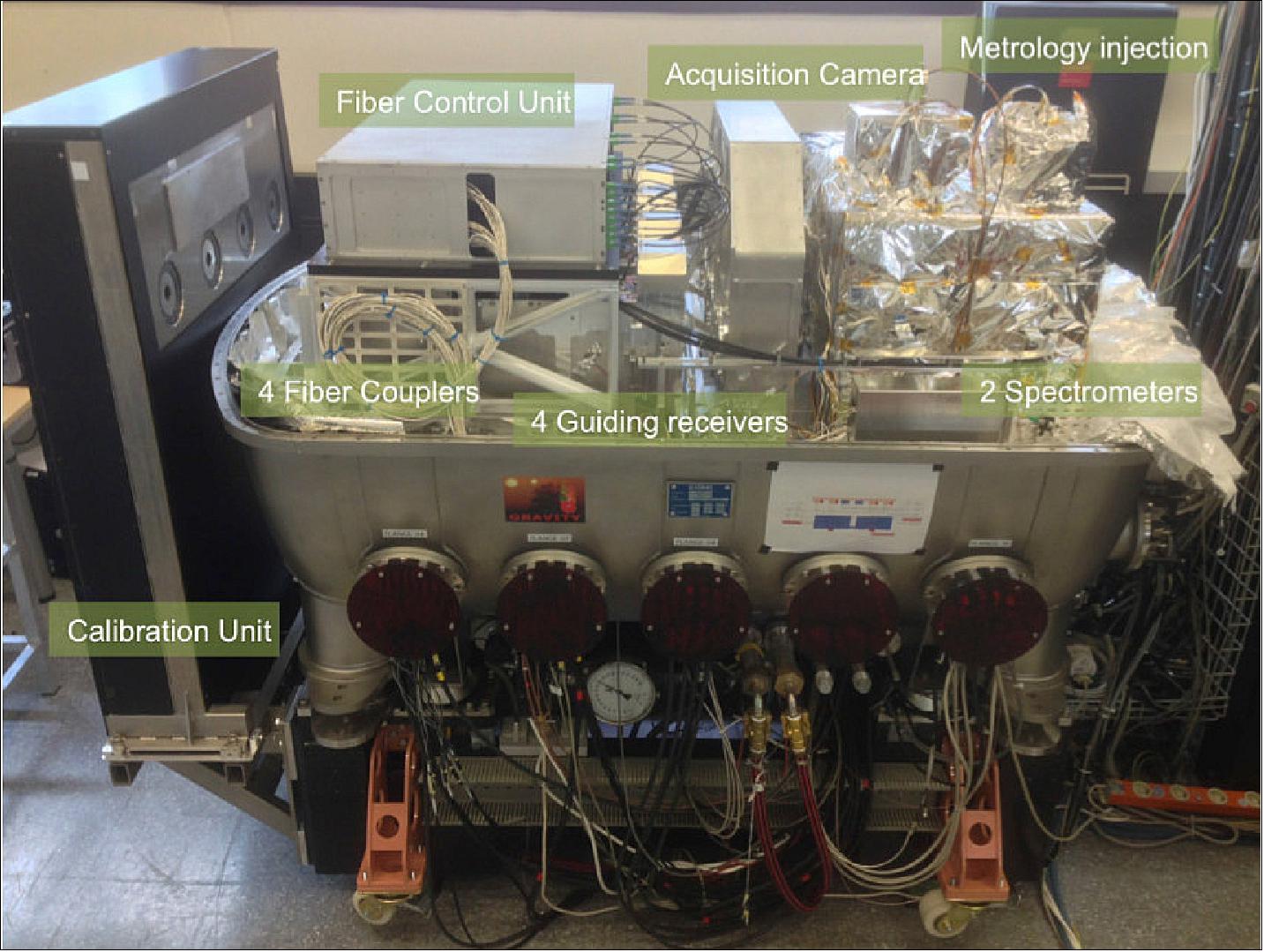
Astrometry and phase-referenced imaging: Astrometry aims at measuring the separation between two targets, whereas phase-referenced imaging aims at measuring the phase of the SC target in reference to the FT target. Both techniques use the dual field mode of GRAVITY and rely on the laser metrology to make the connection between the SC and FT measurements. For astrometry, the metrology measures the evolution of the differential optical path difference as a function of time, which through the interferometer baselines can be converted into a separation between the targets. For phase-referenced imaging the metrology is used to relocate the FT target reference to a separation offset close to the SC target, which helps for producing images. As the laser metrology provides relative optical path measurements only, a metrology zero must be determined for both techniques to work. This determination is typically achieved by swapping a pair of targets (i.e. reversing the sign of the separation), which separates the sidereal metrology signal that changes sign, from the constant metrology zero. When swapping is not directly possible on the target pair of interest, due to a very faint SC target not observable with the FT, the metrology zero determination can be carried out on a more balanced nearby pair. Other than the requirement to calibrate the metrology zero-points, astrometry and phase-referenced imaging observations are similar to dual-field observations and have the same observing constraints.
Whereas the instrument itself is thus perfectly capable of carrying out astrometric and phase-referenced observations, the astrometric part of the GRAVITY pipeline is still under heavy development. The production of separations and referenced phases still rely on custom tools developed by a small group of astrometry-minded astronomers gravitating around the instrument. In addition, the performance of these modes is not fully characterized.
MUSE (Multi Unit Spectroscopic Explorer)
MUSE is the latest of the second-generation instruments to be installed on Yepun (UT4), the fourth Unit Telescope of the Very Large Telescope at the Paranal Observatory. The instrument was built under ESO contract by the MUSE consortium consisting of AIP Potsdam, CRAL Lyon, ESO, EHT Zürich, IRAP Toulouse, Leiden Observatory, and IAG Göttingen. 155)
Like SINFONI, MUSE is an integral field spectrograph (IFS). An IFS allows you to observe the entirety of an astronomical object in one go, and for each pixel measures the intensity of the light as a function of its color, or wavelength. The resulting data is a 3D set where each pixel of the image has a full spectrum of the light. MUSE splits the field of view into 24 individual image segments or channels which are each split further into 48 slices or “mini slits”, giving a total of 1152 mini slits. Each set of 48 mini slits is injected into a spectrograph, which disperses the light into its constituent colors, and MUSE measures over 4000 of these colors! From this, the 3D image is created.
“MUSE has been built with the intention of studying the content and processes going on in the very early Universe, when the first stars and galaxies were forming,” explains Fernando Selman, Instrument Scientist for MUSE. “Closer in time and space, MUSE will map the dark matter distribution in clusters of galaxies using the gravitational microlensing effect on background galaxies.” MUSE will also provide detailed information about the internal dynamics of many classes of galaxies with unprecedented detail. “It has already been used to study the Sombrero Galaxy in Virgo, and, in the same cluster, a recently discovered new type of object — a galaxy being destroyed after falling into the cluster and encountering the cluster’s hot gaseous corona,” continues Fernando. An image of this galaxy is shown on this page. The stars themselves found within bigger objects will also be a focus of study — impressive vistas of the Tarantula Nebula and its huge collection of massive young stars have been obtained during the testing phase, and an enormous mosaic of the Orion Nebula has been produced.
With nearly 400 million pixels to be processed in realtime, MUSE has presented Paranal Observatory with new computation and communication challenges. During the first phase of commissioning alone, nearly half a billion spectra were produced!
MUSE and adaptive optics: MUSE entered a new era in 2017 with the advanced capabilities of the Adaptive Optics Facility (AOF). The AOF with Artificial laser stars (4LGSF); deformable active mirrors (ann16078); multiple wavefront sensors GALACSI will develop the full potential of MUSE and is comparable to moving the telescope 900 meters above the Paranal summit, a height free of the effects of the most turbulent layers of the atmosphere, giving much clearer images than before.
MUSE was will be the first of the VLT’s second generation instruments to taste these new capabilities. The module GALACSI will routinely deliver images to MUSE at optical wavelengths of a quality that was previously possible only on the few clearest nights of the year if at all.
“MUSE with the AOF system will allow for the completion of surveys of the remote Universe with unique sensitivity, permitting studies of the earliest galaxies and large scale structures,” says Selman. “During its lifetime we expect many great contributions from this instrument for a wide range of astronomical investigations".
Instrument: MUSE has a modular structure composed of 24 identical IFU modules that together sample, in Wide Field Mode (WFM), a near-contiguous 1 squared arcmin field of view. Spectrally the instrument samples almost the full optical domain with a mean resolution of 3000. Spatially, the instrument samples the sky with 0.2 arcseconds spatial pixels in the currently offered Wide Field Mode with natural seeing (WFM-noAO). 156) 157) 158)
MUSE offers the GLAO (Ground Layer Adaptive Optics) mode of the VLT Adaptive Optics Facility (AOF) via the GALACSI adaptive optics module, offering an AO corrected 1'x1' field of view with 0.2 arcseconds sampling (WFM-AO). Starting P103 offers a 7.5 x 7.5 arcsec2 LTAO corrected field of view sampled at 0.025"/pixel (NFM-AO).
• Wavelength range: 480-930 nm (nominal); 465-930 nm (extended)
• Detectors: 24 x 4 k x 4 k MIT/LL CCD
• AO type: Ground Layer, 4 x (5-10 W) lasers
• Throughput WFM (Wide Field Mode): 14 % (480 nm) 35 % (750 nm) 14 % (930 nm)
• Throughput NFM (Narrow Field Mode): 13 % (480 nm) 26 % (750 nm) 11 % (930 nm)
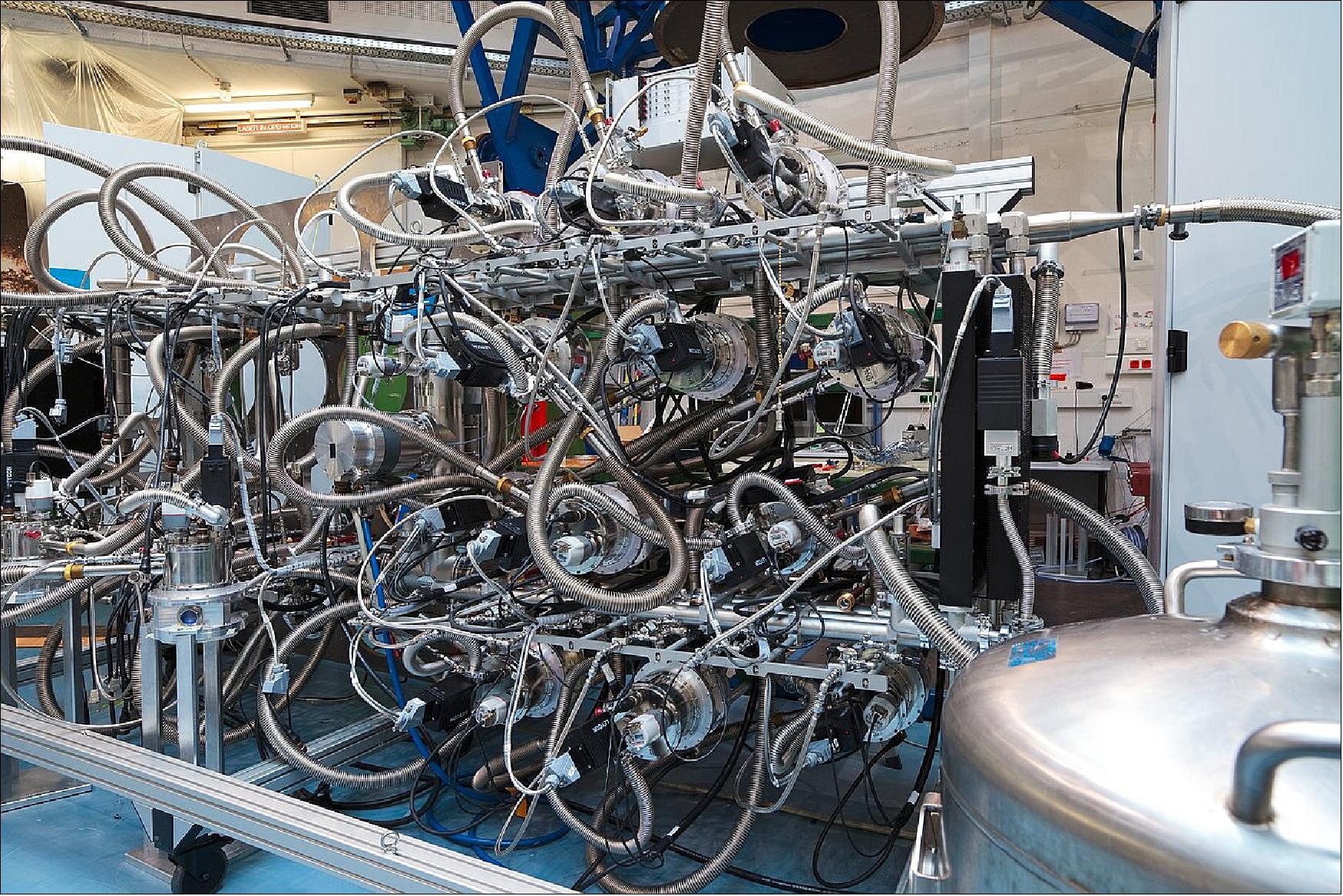
References
1) ”Very Large Telescope - The world's most advanced visible-light astronomical observatory,” ESO, 2018, URL: http://www.eso.org/public/teles-instr/paranal-observatory/vlt/
2) ”Paranal Observatory,” ESO, 2018, URL: https://www.eso.org/public/teles-instr/paranal-observatory/
3) ”European Southern Observatory,” Wikipedia, URL: https://en.wikipedia.org/wiki/European_Southern_Observatory
4) Erik Gregersen, ”Very Large Telescope,” Encyclopedia Britannica, URL: https://www.britannica.com/topic/Very-Large-Telescope
5) ”'Black hole police' discover a dormant black hole outside our galaxy,” eso2210 — Science Release, 18 July 2022, URL: https://www.eso.org/public/news/eso2210/?lang
6) Tomer Shenar, Hugues Sana, Laurent Mahy, Kareem El-Badry, Pablo Marchant, Norbert Langer, Calum Hawcroft, Matthias Fabry, Koushik Sen, Leonardo A. Almeida, Michael Abdul-Masih, Julia Bodensteiner, Paul Crowther, Mark Gieles, Mariusz Gromadzki, Vincent Hénault-Brunet, Artemio Herrero, Alex de Koter, Patryk Iwanek, Szymon Kozłowski, Danny J. Lennon, Jesúus Maíz Apellániz, Przemysław Mróz, Anthony F. J. Moffat, Annachiara Picco, Paweł Pietrukowicz, Radosław Poleski, Krzysztof Rybicki, Fabian R. N. Schneider, Dorota M. Skowron, Jan Skowron, Igor Soszynski, Michał K. Szymanski, Silvia Toonen, Andrzej Udalski, Krzysztof Ulaczyk, Jorick S. Vink, Marcin Wrona”An X-ray quiet black hole born with a negligible kick in a massive binary of the Large Magellanic Cloud,” Nature Astronomy, Published: 23 May 2022, URL: https://www.eso.org/public/archives/releases/sciencepapers/eso2210/eso2210a.pdf
7) ”Astronomers discover micronovae, a new kind of stellar explosion,” eso2207 — Science Release, 20 April 2022, URL: https://www.eso.org/public/news/eso2207/?lang
8) Simone Scaringi, Paul J. Groot, Christian Knigge, Anthony J. Bird, E. Breedt, David A.H. Buckley, Yuri Cavecchi, Nathalie D. Degenaar, Domitilla de Martino, Chris Done, Matteo Fratta, Krystian Ilkiewicz, Elmar Koerding, Jean-Pierre Lasota, Colin Littlefield, Carlo F. Manara, Mairi O’Brien, Paula Szkody, Frank X. Timmes, ”Localised thermonuclear bursts from accreting magnetic white dwarfs,” Nature, Vol. 604, pp: 447-450, Published: 20 April 2022, https://doi.org/10.1038/s41586-022-04495-6, URL: https://www.eso.org/public/archives/releases/sciencepapers/eso2207/eso2207a.pdf
9) ”ESO telescope captures surprising changes in Neptune's temperatures,” eso2206 Science Release, 11 April 2022, URL: https://www.eso.org/public/news/eso2206/?lang
10) Michael T. Roman, Leigh N. Fletcher, Glenn S. Orton, Thomas K. Greathouse, Julianne I. Moses, Naomi Rowe-Gurney, Patrick G. J. Irwin, Arrate Antuñano, James Sinclair, Yasumasa Kasaba, Takuya Fujiyoshi, Imke de Pater, and Heidi B. Hammel, ”Subseasonal Variation in Neptune’s Mid-Infrared Emission,” The Planetary Science Journal, Volume 3, Number 4, Published: 11 April 2022, https://doi.org/10.3847/PSJ/ac5aa4, URL: https://iopscience.iop.org/article/10.3847/PSJ/ac5aa4/pdf
11) “'Closest black hole' system found to contain no black hole,” eso2204 — Science Release, 2 March 2022, URL: https://www.eso.org/public/news/eso2204/?lang
12) A. J. Frost, J. Bodensteiner, Th. Rivinius, D. Baade, A. Merand, F. Selman, M. Abdul-Masih, G. Banyard, E. Bordier, K. Dsilva, C. Hawcroft, L. Mahy, M. Reggiani, T. Shenar, M. Cabezas, P. Hadrava, M. Heida, R. Klement and H. Sana, ”HR 6819 is a binary system with no black hole,” Astronomy & Astrophysics, Volume 659, March 2022, Article No L3, Published online: 02 March 2022, https://doi.org/10.1051/0004-6361/202143004
13) ”Supermassive black hole caught hiding in a ring of cosmic dust,” eso2203 — Science Release, 16 February 2022, URL: https://www.eso.org/public/news/eso2203/?lang
14) Violeta Gámez Rosas, Jacob W. Isbell, Walter Jaffe, Romain G. Petrov, James H. Leftley, Karl-Heinz Hofmann, Florentin Millour, Leonard Burtscher, Klaus Meisenheimer, Anthony Meilland, Laurens B. F. M. Waters, Bruno Lopez, Stéphane Lagarde, Gerd Weigelt, Philippe Berio, Fatme Allouche, Sylvie Robbe-Dubois, Pierre Cruzalèbes, Felix Bettonvil, Thomas Henning, Jean-Charles Augereau, Pierre Antonelli, Udo Beckmann, Roy van Boekel, Philippe Bendjoya, William C. Danchi, Carsten Dominik, Julien Drevon, Jack F. Gallimore, Uwe Graser, Matthias Heininger, Vincent Hocdé, Michiel Hogerheijde, Josef Hron, Caterina M. V. Impellizzeri, Lucia Klarmann, Elena Kokoulina, Lucas Labadie, Michael Lehmitz, Alexis Matter, Claudia Paladini, Eric Pantin, Jörg-Uwe Pott, Dieter Schertl, Anthony Soulain, Philippe Stee, Konrad Tristram, Jozsef Varga, Julien Woillez, Sebastian Wolf, Gideon Yoffe & Gerard Zins, ”Thermal imaging of dust hiding the black hole in NGC 1068,” Nature, Volume 602, pp:403-407, Published: 16 February 2022, https://doi.org/10.1038/s41586-021-04311-7
15) ”New planet detected around star closest to the Sun,” eso2202 — Science Release, 10 February 2022, URL: https://www.eso.org/public/news/eso2202/?lang
16) J. P. Faria, A. Suárez Mascareño, P. Figueira, A. M. Silva, M. Damasso, O. Demangeon, F. Pepe, N. C. Santos, R. Rebolo, S. Cristiani, V. Adibekyan, Y. Alibert, R. Allart, S. C. C. Barros, A. Cabral, V. D’Odorico, P. Di Marcantonio, X. Dumusque, D. Ehrenreich, J. I. González Hernández, N. Hara, J. Lillo-Box, G. Lo Curto, C. Lovis, C. J. A. P. Martins, D. Mégevand, A. Mehner, G. Micela, P. Molaro, N. J. Nunes, E. Pallé, E. Poretti, S. G. Sousa, A. Sozzetti, H. Tabernero, S. Udry and M. R. Zapatero Osorio”A candidate short-period sub-Earth orbiting Proxima Centauri,” Astronomy & Astrophysics, Volume 658, February 2022, Published: 10 February 2022, Section: Planets and planetary systems, https://doi.org/10.1051/0004-6361/202142337
17) ”ESO telescopes help uncover largest group of rogue planets yet,” eso2120 — Science Release, 22 December 2021, URL: https://www.eso.org/public/news/eso2120/?lang
18) ”Watch stars move around the Milky Way’s supermassive black hole in deepest images yet,” eso2119 — Science Release, 14 December 2021, URL: https://www.eso.org/public/news/eso2119/?lang
19) ”The Very Large Telescope Interferometer,” ESO, URL: https://www.eso.org/sci/facilities/paranal/telescopes/vlti.html
20) Gravity collaboration: R. Abuter, N. Aimar, A. Amorim, J. Ball, M. Bauböck, J.P. Berger, H. Bonnet, G. Bourdarot, W. Brandner, V. Cardoso, Y. Clénet, Y. Dallilar, R. Davies, P.T. de Zeeuw, J. Dexter, A. Drescher, A. Eckart, F. Eisenhauer, N.M. Förster Schreiber, P. Garcia, F. Gao, E. Gendron, R. Genzel1, S. Gillessen, M. Habibi, X. Haubois, G. Heiße, T. Henning, S. Hippler, M. Horrobin, L. Jochum, L. Jocou, A. Kaufer, P. Kervella, S. Lacour, V. Lapeyrère, J.-B. Le Bouquin, P. Léna, D. Lutz, T. Ott, T. Paumard, K. Perraut, G. Perrin, O. Pfuhl, S. Rabien, G. Rodríguez-Coira, J. Shangguan, T. Shimizu, S. Scheithauer, J. Stadler, O. Straub, C. Straubmeier, E. Sturm, L.J. Tacconi, K.R.W. Tristram, F. Vincent, S. von Fellenberg, F. Widmann, E. Wieprecht, E. Wiezorrek, J. Woillez, S. Yazici, and A. Young, ”Mass distribution in the Galactic Center based on interferometric astrometry of multiple stellar orbits,” Astronomy & Astrophysics, 15 September 2021, URL: https://www.eso.org/public/archives/releases/sciencepapers/eso2119/eso2119b.pdf
21) ”ESO telescope images planet around most massive star pair to date,” eso2118 — Science Release 8 December 2021, URL: https://www.eso.org/public/news/eso2118/?lang
22) Markus Janson, Raffaele Gratton, Laetitia Rodet, Arthur Vigan, Mickaël Bonnefoy, Philippe Delorme, Eric E. Mamajek, Sabine Reffert, Lukas Stock, Gabriel-Dominique Marleau, Maud Langlois, Gaël Chauvin, Silvano Desidera, Simon Ringqvist, Lucio Mayer, Gayathri Viswanath, Vito Squicciarini, Michael R. Meyer, Matthias Samland, Simon Petrus, Ravit Helled, Matthew A. Kenworthy, Sascha P. Quanz, Beth Biller, Thomas Henning, Dino Mesa, Natalia Engler & Joseph C. Carson, ”A wide-orbit giant planet in the high-mass b Centauri binary system,” Nature, Volume 600, pp: 231-234, Published: 08 December 2021, https://doi.org/10.1038/s41586-021-04124-8
23) ”ESO telescope uncovers closest pair of supermassive black holes yet,” eso2117 — Science Release, 30 November 2021, URL: https://www.eso.org/public/news/eso2117/?lang
24) K. T. Voggel, A. C. Seth, H. Baumgardt, B. Husemann, N. Neumayer, M. Hilker, R. Pechetti, S. Mieske, A. Dumont, I. Georgiev, ”First direct dynamical detection of a dual super-massive black hole system at sub-kpc separation,” Astronomy & Astrophysics, Accepted: 31 October 2021, https://doi.org/10.1051/0004-6361/202140827
25) ”Black hole found hiding in star cluster outside our galaxy,” eso2116 — Science Release, 11 November 2021, URL: https://www.eso.org/public/news/eso2116/?lang
26) S. Saracino, S. Kamann, M. G. Guarcello, C. Usher, N. Bastian, I. Cabrera-Ziri, M. Gieles, S. Dreizler, G. S. Da Costa, T.-O. Husser, V. Hénault-Brunet, ”A black hole detected in the young massive LMC cluster NGC 1850,” Monthly Notices of the Royal Astronomical Society, stab3159, Published: 11 November 2021, https://doi.org/10.1093/mnras/stab3159
27) ”Meet the 42: ESO images some of the biggest asteroids in our Solar System,” eso2114 — Photo Release, 12 October 2021, URL: https://www.eso.org/public/news/eso2114/?lang
28) ”ESO captures best images yet of peculiar “dog-bone” asteroid,” eso2113 — Photo Release, 9 September 2021, URL: https://www.eso.org/public/news/eso2113/?lang
29) F. Marchis, L. Jorda, P. Vernazza, M. Brož, J. Hanuš, M. Ferrais, F. Vachier, N. Rambaux, M. Marsset, M. Viikinkoski, E. Jehin, S. Benseguane, E. Podlewska-Gaca, B. Carry, A. Drouard, S. Fauvaud, M. Birlan, J. Berthier, P. Bartczak, C. Dumas, G. Dudziński, J. Ďurech, J. Castillo-Rogez, F. Cipriani, F. Colas, R. Fetick, T. Fusco, J. Grice, A. Kryszczynska, P. Lamy, A. Marciniak, T. Michalowski, P. Michel, M. Pajuelo, T. Santana-Ros, P. Tanga, A. Vigan, O. Witasse and B. Yang, ”(216) Kleopatra, a low density critically rotating M-type asteroid,” Astronomy & Astrophysics, Volume 653, Published online: 09 September 2021, https://doi.org/10.1051/0004-6361/202140874
30) ”New ESO observations show rocky exoplanet has just half the mass of Venus,” eso2112 — Science Release, 5 August 2021, URL: https://www.eso.org/public/news/eso2112/?lang
31) O. D. S. Demangeon, M. R. Zapatero Osorio, Y. Alibert, S. C. C. Barros, V. Adibekyan, H. M. Tabernero, A. Antoniadis-Karnavas, J. D. Camacho, et al., ”Warm terrestrial planet with half the mass of Venus transiting a nearby star,” Astronomy & Astrophysics, Published: 3 August 2021, URL: https://www.aanda.org/articles/aa/pdf/forth/aa40728-21.pdf
32) ”Galactic fireworks: new ESO images reveal stunning features of nearby galaxies,” eso2110 — Photo Release, 16 July 2021, URL: https://www.eso.org/public/news/eso2110/?lang
33) ”First measurement of isotopes in atmosphere of exoplanet,” Astronomie.nl, 14 July 2021, URL: https://www.astronomie.nl/nieuws/en/first-measurement-of-isotopes-in-atmosphere-of-exoplanet-2876
34) Yapeng Zhang, Ignas A. G. Snellen, Alexander J. Bohn, Paul Mollière, Christian Ginski, H. Jens Hoeijmakers, Matthew A. Kenworthy, Eric E. Mamajek, Tiffany Meshkat, Maddalena Reggiani & Frans Snik, ”The 13CO-rich atmosphere of a young accreting super-Jupiter,” Nature, Volume 595, pp: 370-372, Published: 14 July 2021, https://doi.org/10.1038/s41586-021-03616-x
35) ”Mystery of Betelgeuse’s dip in brightness solved,” eso2109 — Science Release, 16 June 2021, URL: https://www.eso.org/public/news/eso2109/?lang
36) ”Heavy metal vapors unexpectedly found in comets throughout our Solar System — and beyond,” eso2108 — Science Release, 19 May 2021, URL: https://www.eso.org/public/news/eso2108/?lang
37) J. Manfroid, D. Hutsemékers & E. Jehin, ”Iron and nickel atoms in cometary atmospheres even far from the Sun,” Nature, Volume 593, pp: 372–374, Published: 19 May 2021, https://doi.org/10.1038/s41586-021-03435-0
38) ”First interstellar comet may be the most pristine ever found,” eso2106 — Science Release, 30 March 2021, URL: https://www.eso.org/public/news/eso2106/?lang
39) S. Bagnulo, A. Cellino, L. Kolokolova, R. Nežič, T. Santana-Ros, G. Borisov, A. A. Christou, Ph. Bendjoya & M. Devogèle, ”Unusual polarimetric properties for interstellar comet 2I/Borisov,” Nature Communications, Volume 12, Article number: 1797, Published: 30 March 2021, https://doi.org/10.1038/s41467-021-22000-x
40) Bin Yang, Aigen Li, Martin A. Cordiner, Chin-Shin Chang, Olivier R. Hainaut, Jonathan P. Williams, Karen J. Meech, Jacqueline V. Keane & Eric Villard, ”Compact pebbles and the evolution of volatiles in the interstellar comet 2I/Borisov,” Nature Astronomy, Published: 30 March 2021, URL: https://doi.org/10.1038/s41550-021-01336-w
41) ”Most distant quasar with powerful radio jets discovered,” ESO, eso2103 — Science Release, 8 March 2021, URL: https://www.eso.org/public/news/eso2103/?lang
42) Eduardo Bañados, Chiara Mazzucchelli, Emmanuel Momjian, Anna-Christina Eilers, Feige Wang, Jan-Torge Schindler, Thomas Connor, Irham Taufik Andika, Aaron J. Barth, Chris Carilli, Frederick B. Davies, Roberto Decarli, Xiaohui Fan, Emanuele Paolo Farina, Joseph F. Hennawi, Antonio Pensabene, Daniel Stern, Bram P. Venemans, Lukas Wenz, and Jinyi Yang, ”The Discovery of a Highly Accreting, Radio-loud Quasar at z = 6.82,” The Astrophysical Journal, Volume 909, Number 1, Published: 1 March 2021, https://doi.org/10.3847/1538-4357/abe239, URL: https://iopscience.iop.org/article/10.3847/1538-4357/abe239/pdf
43) ”Frank Eisenhauer receives Tycho Brahe Medal,” MPE, 02 March 2021, URL: https://www.mpe.mpg.de/7570112/news20210301
44) ”On the quest for other earths,” ETH Zürich News, 17 February 2021, URL: https://ethz.ch/en/news-and-events/eth-news/news/2021/02/on-the-quest-for-other-earths.html
45) K. Wagner, A. Boehle, P. Pathak, M. Kasper, R. Arsenault, G. Jakob, U. Käufl, S. Leveratto, A.-L. Maire, E. Pantin, R. Siebenmorgen, G. Zins, O. Absil, N. Ageorges, D. Apai, A. Carlotti, É. Choquet, C. Delacroix, K. Dohlen, P. Duhoux, P. Forsberg, E. Fuenteseca, S. Gutruf, O. Guyon, E. Huby, D. Kampf, M. Karlsson, P. Kervella, J.-P. Kirchbauer, P. Klupar, J. Kolb, D. Mawet, M. N’Diaye, G. Orban de Xivry, S. P. Quanz, A. Reutlinger, G. Ruane, M. Riquelme, C. Soenke, M. Sterzik, A. Vigan, T. de Zeeuw, ”Imaging low-mass planets within the habitable zone of α Centauri ,” Nature Communications, Published: 10February 2021, https://doi.org/10.1038/s41467-021-21176-6
46) ”Astronomers finally measure polarized light from exoplanet,” Phys.org, 12 January 2021, URL: https://phys.org/news/2021-01-astronomers-polarized-exoplanet.html
47) R. G. van Holstein, T. Stolker, R. Jensen-Clem, C. Ginski, J. Milli, J. de Boer, J. H. Girard, Z. Wahhaj, A. J. Bohn, M. A. Millar-Blanchaer, M. Benisty, M. Bonnefoy, G. Chauvin, C. Dominik, S. Hinkley, C. U. Keller, M. Keppler, M. Langlois, S. Marino, F. Ménard, C. Perrot, T. O. B. Schmidt, A. Vigan, A. Zurlo, F. Snik, ”A survey of the linear polarization of directly imaged exoplanets and brown dwarf companions with SPHERE-IRDIS. First polarimetric detections revealing disks around DH Tau B and GSC 6214-210 B,” Astronomy & Astrophysics, Section: Planets and planetary systems, Accepted 18 December 2020, https://doi.org/10.1051/0004-6361/202039290
48) ”New Observations Show Planet-forming Disc Torn Apart by its Three Central Stars,” ESO Release No eso2014, 3 September 2020, URL: https://www.eso.org/public/news/eso2014/
49) Stefan Kraus, Alexander Kreplin, Alison K. Young, Matthew R. Bate,John D. Monnier, Tim J. Harries, Henning Avenhaus, Jacques Kluska, Anna S. E. Laws, Evan A. Rich, Matthew Willson, Alicia N. Aarnio, Fred C. Adams, Sean M. Andrews, Narsireddy Anugu, Jaehan Bae, Theo ten Brummelaar, Nuria Calvet, Michel Curé, Claire L. Davies, Jacob Ennis, Catherine Espaillat, Tyler Gardner, Lee Hartmann, Sasha Hinkley, Aaron Labdon, Cyprien Lanthermann, Jean-Baptiste LeBouquin, Gail H. Schaefer, Benjamin R. Setterholm, David Wilner, Zhaohuan Zhu, ”A triple star system with a misaligned and warpedcircumstellar disk shaped by disk tearing,” Science, Vol. 369, Issue 6508, pp. 1233-1238 4, September 2020, https://doi.org/10.1126/science.aba4633, URL: https://www.eso.org/public/archives/releases/sciencepapers/eso2014/eso2014a.pdf
50) ”Astrophysics: A direct view of star/disk interactions,” University of Cologne, Press Release 28August 2020, URL: https://portal.uni-koeln.de/en/universitaet/aktuell/press-releases/single-news/universitaet/aktuell/press-releases/single-news/star-disk-interactions
51) R. Garcia Lopez, A. Natta, A. Caratti o Garatti, T. P. Ray, R. Fedriani, M. Koutoulaki, L. Klarmann, K. Perraut, J. Sanchez-Bermudez, M. Benisty, C. Dougados, L. Labadie, W. Brandner, P. J. V. Garcia, Th. Henning, P. Caselli, G. Duvert, T. de Zeeuw, R. Grellmann, R. Abuter, A. Amorim, M. Bauböck, J. P. Berger, H. Bonnet, A. Buron, Y. Clénet, V. Coudé du Foresto, W. de Wit, A. Eckart, F. Eisenhauer, M. Filho, F. Gao, C. E. Garcia Dabo, E. Gendron, R. Genzel, S. Gillessen, M. Habibi, X. Haubois, F. Haussmann, S. Hippler, Z. Hubert, M. Horrobin, A. Jimenez Rosales, L. Jocou, P. Kervella, J. Kolb, S. Lacour, J.-B. Le Bouquin, P. Léna, T. Ott, T. Paumard, G. Perrin, O. Pfuhl, A. Ramirez, C. Rau, G. Rousset, S. Scheithauer, J. Shangguan, J. Stadler, O. Straub, C. Straubmeier, E. Sturm, E. van Dishoeck, F. Vincent, S. von Fellenberg, F. Widmann, E. Wieprecht, M. Wiest, E. Wiezorrek, J. Woillez, S. Yazici & G. Zins, ”A measure of the size of the magnetospheric accretion region in TW Hydrae,” Nature, Volume 584, pp: 547-550, Published: 26 August 2020, https://doi.org/10.1038/s41586-020-2613-1
52) ”Stunning Space Butterfly Captured by ESO Telescope,” eso2012 — Photo Release, 30 July 2020, URL: https://www.eso.org/public/news/eso2012/
53) ”First ever image of a multi-planet system around a sun-like star captured by ESO telescope,” Science Daily, 22 July 2020: https://www.sciencedaily.com/releases/2020/07/200722093501.htm
54) ”First ever image of a multi-planet system around a Sun-like star captured by ESO telescope,” ESO, eso2011 Photo Release, 22 July 2020, URL: https://www.eso.org/public/news/eso2011/
55) Alexander J. Bohn, Matthew A. Kenworthy, Christian Ginski, Steven Rieder, Eric E. Mamajek, Tiffany Meshkat, Mark J. Pecaut, Maddalena Reggiani, Jozua de Boer, Christoph U. Keller, Frans Snik, and John Southworth, ”Two Directly Imaged, Wide-orbit Giant Planets around the Young, Solar Analog TYC 8998-760-1,” The Astrophysical Journal Letters, Volume 898, Number 1, Published: 22 July 2020, https://doi.org/10.3847/2041-8213/aba27e
56) ”A Cosmic Mystery: ESO Telescope Captures the Disappearance of a Massive Star,” eso2010 — Science Release, 30 June 2020, URL: https://www.eso.org/public/news/eso2010/
57) Andrew P. Allan, Jose H. Groh, Andrea Mehner, Nathan Smith, Ioana Boian,Eoin J. Farrell and Jennifer E. Andrews, ”The possible disappearance of a massive star in the low metallicitygalaxy PHL 293B,” MNRAS, Preprint 9 June 2020, URL: https://www.eso.org/public/archives/releases/sciencepapers/eso2010/eso2010a.pdf
58) ”ESPRESSO confirms the presence of an Earth around the nearest star,” UNIGE Press Release, 28 May 2020, URL: https://www.unige.ch/communication/communiques/files/1315/9064/8564/ESPRESSO_confirms_the_existence_of_an_exo-Earth_4_light-years_away.pdf
59) A. Suárez Mascareño, J. P. Faria, P. Figueira, C. Lovis, M. Damasso, J. I. González Hernández, R. Rebolo, S. Cristiano, F. Pepe, N. C. Santos, M. R. Zapatero Osorio, V. Adibekyan, S. Hojjatpanah, A. Sozzetti, F. Murgas, M. Abreo, M. Affolter, Y. Alibert, M. Aliverti, R. Allart, C. Allende Prieto, D. Alves, M. Amate, G. Avila, V. Baldini, T. Bandi, S. C. C. Barros, A. Bianco, W. Benz, F. Bouchy, C. Broeng, A. Cabral, G. Calderone, R. Cirami, J. Coelho, P. Conconi, I. Coretti, C. Cumani, G. Cupani, V. D'Odorico, S. Deiries, B. Delabre, P. Di Marcantonio, X. Dumusque, D. Ehrenreich, A. Fragoso, L. Genolet, M. Genoni, R. Génova Santos, I. Hughes, O. Iwert, K. Ferber, J. Knusdrtrup, M. Landoni, B. Lavie, J. Lillo-Box, J. Lizon, G. Lo Curto, C. Maire, A. Manescau, C. J. A. P. Martins, D. Mégevand, A. Mehner, G. Micela, A. Modigliani, P. Molaro, M. A. Monteiro, M. J. P. F. G. Monteiro, M. Moschetti, E. Mueller, N. J. Nunes, L. Oggioni, A. Oliveira, E. Pallé, G. Pariani, L. Pasquini, E. Poretti, J. L. Rasilla, E. Redaelli, M. Riva, S. Santana Tschudi, P. Santin, P. Santos, A. Segovia, D. Sosnoswska, S. Sousa, P. Spanò, F. Tenegi, S. Udry, A. Zanutta, F. Zerbi, ”Revisiting Proxima with ESPRESSO,” Astronomy&Astrophysics, manuscript no. proxima_rev, 26 May 2020, ©ESO 2020, URL: https://arxiv.org/pdf/2005.12114v1.pdf
60) ”ESO Telescope Sees Signs of Planet Birth,” eso2008 — Photo Release, 20 May 2020, URL: https://www.eso.org/public/news/eso2008/
61) A. Boccaletti, E. Di Folco, E. Pantin, A. Dutrey, S. Guilloteau, Y. W. Tang, V. Piétu, E. Habart, J. Milli, T. L. Beck and A.-L. Maire, ”Possible evidence of ongoing planet formation in AB Aurigae,” Astronomy & Astrophysics, Volume 637, Article No L5, Published online: 20 May 2020, https://doi.org/10.1051/0004-6361/202038008
62) ”Astronomers capture rare images of planet-forming disks around stars ,” KU Leuven, 30 April 2020, URL: https://nieuws.kuleuven.be/en/content/2020/astronomers-capture-rare-images-of-planet-forming-disks-around-stars
63) J. Kluska, J.-P. Berger, F. Malbet, B. Lazareff, M. Benisty, J.-B. Le Bouquin, O. Absil, F. Baron, A. Delboulbé, G. Duvert, A. Isella, L. Jocou, A. Juhasz, S. Kraus, R. Lachaume, F. Ménard, R. Millan-Gabet, J. D. Monnier, T. Moulin, K. Perraut, S. Rochat, C. Pinte, F. Soulez, M. Tallon, W.-F. Thi, E. Thiébaut, W. Traub and G. Zins, ”A family portrait of disk inner rims around Herbig Ae/Be stars,” Astronomy & Astrophysics, Volume 636, Article Nr. A116, Published online: 30 April 2020, https://doi.org/10.1051/0004-6361/201833774
64) ”ESO Telescope Sees Star Dance Around Supermassive Black Hole, Proves Einstein Right,” eso2006 — Science Release, 16 April 2020, URL: https://www.eso.org/public/news/eso2006/
65) R. Abuter, A. Amorim, M. Bauböck, J. P. Berger, H. Bonnet, W. Brandner, V. Cardoso, Y. Clénet, P. T. de Zeeuw, J. Dexter, A. Eckart, F. Eisenhauer, N. M. Förster Schreiber, P. Garcia, F. Gao, E. Gendron, R. Genzel, S. Gillessen, M. Habibi, X. Haubois, T. Henning, S. Hippler, M. Horrobin, A. Jiménez-Rosales, L. Jochum, L. Jocou, A. Kaufer, P. Kervella, S. Lacour, V. Lapeyrère, J.-B. Le Bouquin, P. Léna, M. Nowak, T. Ott, T. Paumard, K. Perraut, G. Perrin, O. Pfuhl, G. Rodríguez-Coira, J. Shangguan, S. Scheithauer, J. Stadler, O. Straub, C. Straubmeier, E. Sturm, L. J. Tacconi, F. Vincent, S. von Fellenberg, I. Waisberg, F. Widmann, E. Wieprecht, E. Wiezorrek, J. Woillez, S. Yazici1, and G. Zins, ”Detection of the Schwarzschild precession in the orbit of the star S2 near the Galactic center massive black hole,” Astronomy & Astrophysics, Volume 636, Letters to the Editor,Published online: 16 April 2020, https://doi.org/10.1051/0004-6361/202037813, URL: https://www.aanda.org/articles/aa/pdf/2020/04/aa37813-20.pdf
66) ”ESO Telescope Observes Exoplanet Where It Rains Iron,” ESO News, eso2005 — Science Release, 11 March 2020, URL: https://www.eso.org/public/news/eso2005/
67) David Ehrenreich, Christophe Lovis, Romain Allart, María Rosa Zapatero Osorio, Francesco Pepe, Stefano Cristiani, Rafael Rebolo, Nuno C. Santos, Francesco Borsa, Olivier Demangeon, Xavier Dumusque, Jonay I.González Hernández,Núria Casasayas-Barris, Damien Ségransan, Sérgio Sousa, Manuel Abreu, Vardan Adibekyan, Michael Affolter, et al. ”Nightside condensation of iron in an ultra-hot giant exoplanet,” URL: https://www.eso.org/public/archives/releases/sciencepapers/eso2005/eso2005a.pdf
68) David Ehrenreich, Christophe Lovis, [.....] Filippo Zerbi, ”Nightside condensation of iron in an ultrahot giant exoplanet,” Nature, Published: 11 March 2020, https://doi.org/10.1038/s41586-020-2107-1
69) ”ESO Telescope Sees Surface of Dim Betelgeuse,” ESO Release No: eso2003, 14 February 2020, URL: https://www.eso.org/public/news/eso2003/
70) ”Star formation in the center of the Milky Way came in bursts, new study shows,” MPIA (Max Planck Institute for Astronomy), Heidelberg, 16 December 2019, URL: http://www.mpia.de/news/science/2019-11-starformation
71) ”ESO Telescope Images Stunning Central Region of Milky Way, Finds Ancient Star Burst,” eso 1920 - Photo Release, 16 December 2019, URL: https://www.eso.org/public/news/eso1920/
72) Francisco Nogueras-Lara, Rainer Schödel, Aurelia Teresa Gallego-Calvente, Eulalia Gallego-Cano, Banafsheh Shahzamanian, Hui Dong, Nadine Neumayer, Michael Hilker, Francisco Najarro, Shogo Nishiyama, Anja Feldmeier-Krause, Julien H. V. Girard and Santi Cassisi, ”Early formation and recent starburst activity in the nuclear disk of the Milky Way,” Nature Astronomy Letters, Vol. 267, Published: 16 December 2019, https://doi.org/10.1038/s41550-019-0967-9
73) ”The simultaneous merging of giant galaxies - Research team discovers three supermassive black holes at the core of one galaxy,” University of Göttingen, Press Release No 254, 21 November 2019, URL: https://www.uni-goettingen.de/en/3240.html?id=5719
74) W. Kollatschny, P.M. Weilbacher, M. W. Ochmann, D. Chelouche, A. Monreal-Ibero, R. Bacon, T. Contini , ”NGC 6240: A triple nucleus system in the advanced or final state of merging,” Astronomy & Astrophysics, in press, Accepted: 27 October 2019, https://doi.org/10.1051/0004-6361/201936540
75) ”ESO Telescope Reveals What Could be the Smallest Dwarf Planet Yet in the Solar System,” eso1918 — Science Release, 28 October 2019, URL: https://www.eso.org/public/news/eso1918/?lang
76) P. Vernazza, L. Jorda, P. Ševeček, M. Brož, M. Viikinkoski, J. Hanuš, B. Carry, A. Drouard, M. Ferrais, M. Marsset, F. Marchis, M. Birlan, E. Podlewska-Gaca, E. Jehin, P. Bartczak, G. Dudzinski, J. Berthier, J. Castillo-Rogez, F. Cipriani, F. Colas, F. DeMeo, C. Dumas, J. Durech, R. Fetick, T. Fusco, J. Grice, M. Kaasalainen, A. Kryszczynska, P. Lamy, H. Le Coroller, A. Marciniak, T. Michalowski, P. Michel, N. Rambaux, T. Santana-Ros, P. Tanga, F. Vachier, A. Vigan, O. Witasse, B. Yang, M. Gillon, Z. Benkhaldoun, R. Szakats, R. Hirsch, R. Duffard, A. Chapman, J. L. Maestre, ”A basin-free spherical shape as outcome of a giant impact on asteroid Hygiea,” Nature Astronomy, 28 October 2019, https://doi.org/10.1038/s41550-019-0915-8
77) Anatomy of a Cosmic Seagull,” eso 1913 — Photo Release, 7 August 2019, URL: https://www.eso.org/public/news/eso1913/?lang
78) ”Breakthrough Watch and the European Southern Observatory achieve “first light” on upgraded planet-finding instrument to search for Earth-like planets in nearest star system,” ESO, eso1911 — Organization Release, 10 June 2019, URL: https://www.eso.org/public/news/eso1911/
79) M. Kasper, R. Arsenault, H. Käufl, G. Jakob, E. Fuenteseca, M. Riquelme, R. Siebenmorgen, M. Sterzik, G. Zins, N. Ageorges, S. Gutruf, A. Reutlinger, D. Kampf, O. Absil, B. Carlomagno, O. Guyon, P. Klupar, D. Mawet, G. Ruane, M. Karlsson, E. Pantin, K. Dohlen, ”NEAR: Low-mass Planets in α Cen with VISIR,” The Messenger, Telescopes and Instrumentation. No. 169 (September 2017), 16–20, DOI: 10.18727/0722-6691/5033, URL: https://www.eso.org/sci/publications/messenger/archive/no.169-sep17/messenger-no169-16-20.pdf
80) ”ESO contributes to protecting Earth from dangerous asteroids - VLT observes a passing double asteroid hurtling by Earth at 70,000 km/h,” eso 1910 Organization Release, 3 June 2019, URL: https://www.eso.org/public/news/eso1910/?lang
81) ”Pinpointing Gaia to Map the Milky Way,” ESO, ESO’s VST helps determine the spacecraft’s orbit to enable the most accurate map ever of more than a billion stars, eso1908 — Organization Release, 2 May 2019, URL: https://www.eso.org/public/news/eso1908/
82) ”Exoplanet under the looking glass,” MPIA (Max Planck Institute for Astronomy) Heidelberg, 27 March 2019, URL: http://www.mpia.de/news/science/2019-03-gravity-exoplanet?c=2285
83) ”GRAVITY instrument breaks new ground in exoplanet imaging,” eso 1905 — Science Release, 27 March 2019, URL: https://www.eso.org/public/news/eso1905/
84) GRAVITY Collaboration: S. Lacour, M. Nowak, J. Wang, O. Pfuhl, F. Eisenhauer, R. Abuter, A. Amorim, N. Anugu, M. Benisty, J. P. Berger, H. Beust, N. Blind, M. Bonnefoy, H. Bonnet, P. Bourget, W. Brandner, A. Buron, C. Collin, B. Charnay, F. Chapron, Y. Clénet, V. Coudé du Foresto, P. T. de Zeeuw, C. Deen, R. Dembet, J. Dexter, G. Duvert, A. Eckart, N. M. Förster Schreiber, P. Fédou, P. Garcia, R. Garcia Lopez, F. Gao, E. Gendron, R. Genze, S. Gillessen, P. Gordo, A. Greenbaum, M. Habibi, X. Haubois, F. Haußmann, Th. Henning, S. Hippler, M. Horrobin, Z. Hubert, A. Jimenez Rosales, L. Jocou, S. Kendrew, P. Kervella, J. Kolb, A.-M. Lagrange, V. Lapeyrère, J.-B. Le Bouquin, P. Léna, M. Lippa, R. Lenzen, A.-L. Maire, P. Mollière, T. Ott, T. Paumard, K. Perraut, G. Perrin, L. Pueyo, S. Rabien, A. Ramírez, C. Rau, G. Rodríguez-Coira, G. Rousset, J. Sanchez-Bermudez, S. Scheithauer, N. Schuhler, O. Straub, C. Straubmeier, E. Sturm, L. J. Tacconi, F. Vincent, E. F. van Dishoeck, S. von Fellenberg, I. Wank, I. Waisberg, F. Widmann, E. Wieprecht, M. Wiest, E. Wiezorrek, J. Woillez, S. Yazici, D. Ziegler, and G. Zins,”First direct detection of an exoplanet by optical interferometry -Astrometry and K-band spectroscopy of HR 8799 e,” Astronomy & Astrophysics, Volume 623, Article No L11, March2019, https://doi.org/10.1051/0004-6361/201935253 , URL: https://www.eso.org/public/archives/releases/sciencepapers/eso1905/eso1905a.pdf
85) ”A Cosmic Bat in Flight - ESO’s Cosmic Gems Program captures the Cosmic Bat’s dusty clouds,” eso1904 — Photo Release, 14 March 2019, URL: https://www.eso.org/public/news/eso1904/
86) ”Bubbles of brand new stars,” ESO 1903 Photo Release, 6 February 2019, URL: https://www.eso.org/public/news/eso1903/
87) Anna F. McLeod, Megan Reiter, Rolf Kuiper, Pamela D. Klaassen & Christopher J. Evans, ”A parsec-scale optical jet from a massive young star in the Large Magellanic Cloud,” Nature Letter, Volume 554, pp: 334-336, 15 February 2019, https://www.nature.com/articles/nature25189
88) ”In the whirlpool around a gigantic black hole — Astronomers peer closely into heart of the quasar 3C 273,” MPG (Max-Planck-Gesellschaft), 29 November 2018, URL: https://www.mpg.de/12545668/a-close-up-look-at-the-whirlpool-around-a-gigantic-black-hole
89) E. Sturm, J. Dexter, O. Pfuhl, M. R. Stock, R. I. Davies, D. Lutz, Y. Clénet, A. Eckart, F. Eisenhauer, R. Genzel, D. Gratadour, S. F. Hönig, M. Kishimoto, S. Lacour, F. Millour, H. Netzer, G. Perrin, B. M. Peterson, P. O. Petrucci, D. Rouan, I. Waisberg, J. Woillez, A. Amorim, W. Brandner, N. M. Förster Schreiber, P. J. V. Garcia, S. Gillessen, T. Ott, T. Paumard, K. Perraut, S. Scheithauer, C. Straubmeier, L. J. Tacconi, F. Widmann, ”Spatially resolved rotation of the broad-line region of a quasar at sub-parsec scale,” Nature, 29 November 2018, URL: https://arxiv.org/ftp/arxiv/papers/1811/1811.11195.pdf
90) ”Doomed star in Milky Way threatens rare gamma-ray burst,” Phys.org, 19 November 2018, URL: https://phys.org/news/2018-11-doomed-star-milky-threatens-rare.html
91) J. R. Callingham, P. G. Tuthill, B. J. S. Pope, P. M. Williams, P. A. Crowther, M. Edwards, B. Norris & L. Kedziora-Chudczer , ”Anisotropic winds in a Wolf–Rayet binary identify a potential gamma-ray burst progenitor,” Nature Astronomy Letter, Published: 19 November 2018, DOI: https://doi.org/10.1038/s41550-018-0617-7
92) ”Most Detailed Observations of Material Orbiting close to a Black Hole,” ESO1835 Science Release, 31 October 2018, URL: https://www.eso.org/public/news/eso1835/
93) R. Abuter, A. Amorim, M. Bauböck, J.P. Berger, H. Bonnet, W. Brandner, Y. Clénet, V. Coudé du Foresto, P.T. de Zeeuw, C. Deen, J. Dexter, G. Duvert, A. Eckart, F. Eisenhauer, N. M. Förster Schreiber, P. Garcia, F. Gao, E. Gendron, R. Genzel, S. Gillessen, P. Guajardo, M. Habibi, X. Haubois, Th. Henning, S. Hippler, M. Horrobin, A. Huber, A. Jiménez-Rosales, L. Jocou, P. Kervella, S. Lacour, V. Lapeyrère, B. Lazareff, J.-B. Le Bouquin, P. Léna, M. Lippa, T. Ott, J. Panduro, T. Paumard, K. Perraut, G. Perrin, O. Pfuhl, P.M. Plewa, S. Rabien, G. Rodríguez-Coira, G. Rousset, A. Sternberg, O. Straub, C. Straubmeier, E. Sturm, L. J. Tacconi, F. Vincent, S. von Fellenberg, I. Waisberg, F. Widmann, E. Wieprecht, E. Wiezorrek, J. Woillez, and S. Yazici, ”Detection of orbital motions near the last stable circular orbit of the massive black hole SgrA*,” Astronomy & Astrophysics manuscript No. sgra_SAGA_v01 c! October 18, 2018, URL: https://www.eso.org/public/archives/releases/sciencepapers/eso1835/eso1835a.pdf
94) ”A Universe Aglow -MUSE spectrograph reveals that nearly the entire sky in the early Universe is glowing with Lyman-alpha emission,” ESO 1832 Science Release, 01 October 2018, URL: https://www.eso.org/public/news/eso1832/
95) L. Wisotzki, R. Bacon, J. Brinchmann, S. Cantalupo, P. Richter, J. Schaye, K. B. Schmidt, T. Urrutia, P. M. Weilbacher, M. Akhlaghi, N. Bouché, T. Contini, B. Guiderdoni, E. C. Herenz, H. Inami, J. Kerutt, F. Leclercq, R. A. Marino, M. Maseda, A. Monreal-Ibero, T. Nanayakkara, J. Richard, R. Saust, M. Steinmetz & M. Wendt, ”Nearly all the sky is covered by Lyman-α emission around high-redshift galaxies,” Nature Letter, https://www.nature.com/articles/s41586-018-0564-6, Published: 01 October 2018, URL: https://tinyurl.com/yafzkfdw
96) ”A Galactic Gem, ESO’s FORS2 instrument captures stunning details of spiral galaxy NGC 3981,” eso1830 — Photo Release, 12 September 2018, URL: https://www.eso.org/public/news/eso1830/
97) ”Elliptical Elegance,” ESO, 8 August 2018, URL: https://www.eso.org/public/news/eso1827/
98) Marilena Spavone, Enrichetta Iodice, Massimo Capaccioli, Daniela Bettoni, Roberto Rampazzo,Noah Brosch,Michele Cantiello,Nicola R. Napolitano,Luca Limatola, Aniello Grado, Pietro Schipani, ”VEGAS: A VST Early-type GAlaxy Survey. III. Mapping the galaxy structure, interactions and intragroup light in the NGC 5018 group,” Astrophysical Journal, in press, arXiv: 1807.11204, 31 July 2018, URL: https://www.eso.org/public/archives/releases/sciencepapers/eso1827/eso1827a.pdf
99) ”First Successful Test of Einstein’s General Relativity Near Supermassive Black Hole,” ESO 1825 Science Release, 26 July 2018, URL: https://www.eso.org/public/news/eso1825/
100) R. Abuter, A. Amorim, N. Anugu, M. Bauböck, M. Benisty, J. P. Berger, N. Blind, H. Bonnet, W. Brandner, A. Buron, C. Collin, F. Chapron, Y. Clénet, V. Coudé du Foresto, P. T. de Zeeuw, C. Deen, F. Delplancke-Ströbele, R. Dembet, J. Dexter, G. Duvert, A. Eckart, F. Eisenhauer, G. Finger, N. M. Förster Schreiber, P. Fédou, P. Garcia, R. Garcia Lopez, F. Gao, E. Gendron, R. Genzel, S. Gillessen, P. Gordo, M. Habibi, X. Haubois, M. Haug, F. Haußmann, Th. Henning, S. Hippler, M. Horrobin, Z. Hubert, N. Hubin, A. Jimenez Rosales, L. Jochum, L. Jocou, A. Kaufer, S. Kellner, S. Kendrew, P. Kervella, Y. Kok, M. Kulas, S. Lacour, V. Lapeyrère, B. Lazareff, J.-B. Le Bouquin, P. Léna, M. Lippa, R. Lenzen, A. Mérand, E. Müler, U. Neumann, T. Ott, L. Palanca, T. Paumard, L. Pasquini, K. Perraut, G. Perrin, O. Pfuhl, P. M. Plewa, S. Rabien, A. Ramírez, J. Ramos, C. Rau, G. Rodríguez-Coira, R.-R. Rohloff, G. Rousset, J. Sanchez-Bermudez, S. Scheithauer, M. Schöller, N. Schuler, J. Spyromilio, O. Straub, C. Straubmeier, E. Sturm, L. J. Tacconi, K. R. W. Tristram, F. Vincent, S. von Fellenberg, I. Wank, I. Waisberg, F. Widmann, E. Wieprecht, M. Wiest, E. Wiezorrek, J. Woillez, S. Yazici, D. Ziegler, and G. Zins,”Detection of the gravitational redshift in the orbit of the star S2 near the Galactic center massive black hole,” Astronomy & Astrophysics, Vol. 615, L15, July 2018, https://doi.org/10.1051/0004-6361/201833052, URL: https://www.aanda.org/articles/aa/pdf/2018/07/aa33718-18.pdf
101) ”The daily motion of the S2 star as seen with GRAVITY” ESO, 26 July 2018, URL: https://www.eso.org/public/images/eso1825e/
102) ”Supersharp Images from New VLT Adaptive Optics,” eso1824 — Photo Release, 18 July 2018, URL: https://www.eso.org/public/news/eso1824/
103) ”Colorful Celestial Landscape,” eso1823 — Photo Release, 11 July 2018, URL: http://www.eso.org/public/news/eso1823/
104) ”The Messenger Issue 172, June 2018,” URL: http://www.eso.org/public/archives/messengers/pdf/messenger_0172.pdf
105) ”Hunting molecules to find new planets,” UNIGE (University of Geneva), June 20, 2018, URL: https://www.unige.ch/communication/communiques/en/2018/cdp180619/
106) ”SPHERE Reveals Fascinating Zoo of Discs Around Young Stars,” ESO 1811 Photo Release, 11 April 2018, URL: https://www.eso.org/public/news/eso1811/
107) ”SPHERE images a zoo of dusty discs around young stars,” ESO, 11 April 2018, URL: https://www.eso.org/public/images/eso1811a/
108) ”SPHERE image of the dusty disc around IM Lupi,” ESO 1811c Photo Release, 11 April 2018, URL: https://www.eso.org/public/images/eso1811c/
109) ”Dead Star Circled by Light -MUSE data points to isolated neutron star beyond our galaxy,” ESO 1811a Photo Release, 5 April 2018, URL: https://www.eso.org/public/news/eso1810/
110) Frédéric P. A. Vogt, Elizabeth S. Bartlett, Ivo R. Seitenzahl, Michael A. Dopita, Parviz Ghavamian, Ashley J. Ruiter, Jason P. Terry, ”Identification of the central compact object in the young supernova remnant 1E 0102.2-7219,” Nature Astronomy, 2 March 2018, URL: http://www.eso.org/public/archives/releases/sciencepapers/eso1810/eso1810a.pdf
111) ”High-resolution View into the Infrared Universe,” Max Planck Institute for Radio Astronomy, Bonn, 5 March 2018, URL: https://www.mpifr-bonn.mpg.de/pressreleases/2018/3
112) ”MATISSE Instrument Sees First Light on ESO’s Very Large Telescope Interferometer,” ESO Organisation Release1808, 5 March, 2018, URL: https://www.eso.org/public/news/eso1808/
113) Miguel Sanchez, ”Light pollution threatens Chile's dark skies,” Space Daily, 17 Feb. 2018, URL: http://www.spacedaily.com/reports/Light_pollution_threatens_Chiles_dark_skies_999.html
114) ”ESO Views Pulsating Red Giant Star R Sculptoris,” SciTech Daily, 13 Feb. 2018, URL: https://scitechdaily.com/eso-views-pulsating-red-giant-star-r-sculptoris/
115) M. Wittkowski, K.-H. Hofmann, S. Höfner, J. B. Le Bouquin, W. Nowotny, C. Paladini, J. Young, J.-P. Berger, M. Brunner, I. de Gregorio-Monsalvo, K. Eriksson, J. Hron, E. M. L. Humphreys, M. Lindqvist, M. Maercker, S. Mohamed, H. Olofsson, S. Ramstedt, G. Weigelt, ”Aperture synthesis imaging of the carbon AGB star R Sculptoris,” Astronomy & Astrophysics manuscript no. 30214 c, ©ESO 2017, February 10, 2017, URL: https://arxiv.org/pdf/1702.02574.pdf
116) ”Images taken with the VLT,”, URL: http://www.eso.org/public/images/archive/search/?adv=&facility=31
117) ”Sharper Images for VLT Infrared Camera -Adaptive optics facility extended to HAWK-I instrument,” ESO ann18006 — Announcement, 30 Jan. 2018, URL: http://www.eso.org/public/announcements/ann18006/
118) ”The Tarantula Nebula region imaged with HAWK-I with the Adaptive Optics Facility,” ESO , Id: ann18006a, 30 Jan. 2018, URL: http://www.eso.org/public/images/ann18006a/
119) ”Odd Behavior of Star Reveals Lonely Black Hole Hiding in Giant Star Cluster,” eso 1802 Science Release, 17 January 2018, URL: https://www.eso.org/public/news/eso1802/
120) Benjamin Giesers, Stefan Dreizler, Tim-Oliver Husser, Sebastian Kamann, Guillem Anglada Escudé, Jarle Brinchmann, C. Marcella Carollo, Martin M. Roth, Peter M. Weilbacher, Lutz Wisotzki, ”A detached stellar-mass black hole candidate in the globular cluster NGC 3201,” URL: https://www.eso.org/public/archives/releases/sciencepapers/eso1802/eso1802a.pdf
121) ”Stellar Nursery Blooms into View,” ESO, Release No.: eso1740, 13 Dec. 2017, Preprint 9 January 2018, URL: https://www.eso.org/public/news/eso1740/
122) ”Best Ever Image of a Star’s Surface and Atmosphere — First map of motion of material on a star other than the Sun,” ESO, Release No.: eso1726, 23 Aug. 2017, URL: https://www.eso.org/public/news/eso1726/
123) K. Ohnaka, G. Weigelt, K.-H. Hofmann, ”Vigorous atmospheric motions in the red supergiant supernova progenitor Antares,” Nature, 2017, Vol. 548, pp: 310-312, DOI: 10.1038/nature23445, Published online: 16 August 2017, URL: https://www.eso.org/public/archives/releases/sciencepapers/eso1726/eso1726a.pdf
124) ”ESO's Very Large Telescope Celebrates 15 Years of Success,” ESO Release No eso1322, 23 May 2013, URL: https://www.eso.org/public/news/eso1322/
125) ”VLT Looks into The Eyes of the Virgin,” ESO Release No.:eso1131, 24 August 2011, URL: https://www.eso.org/public/news/eso1131/
126) ”VIMOS - a Cosmology Machine for the VLT,” ESO Release No.: eso0209, 13 March 2002, URL: http://www.eso.org/public/news/eso0209/
127) ”The Crab Nebula,” ESO Release No eso0209f, 13 March, 2002, URL: http://www.eso.org/public/images/eso0209f/
128) ”Light from all Four VLT Unit Telescopes Combined for the First Time,” ESO, Release No ann 11021, 20 April 2011, URL: http://www.eso.org/public/announcements/ann11021/
129) ”Light from Four Telescopes Combined at ESO's Paranal Observatory,” ESO, Release No ann 1081, 4 Nov. 2010, URL: http://www.eso.org/public/announcements/ann1081/
130) ”A new-generation instrument for the VLT,” University of Geneva, 2015, URL: https://obswww.unige.ch/wordpress/espresso/the-instrument/
131) Jonay I. Gonzalez Hernandez, Francesco Pepe, Paolo Molaro, Nuno Santos, ”ESPRESSO on VLT: An Instrument for Exoplanet Research,” 14, Nov. 2017, URL: https://arxiv.org/pdf/1711.05250.pdf
132) ”ESPRESSO instrument achieves first light with all four Unit Telescopes,” ESO, 13 Feb. 2018, URL: https://www.eso.org/public/images/eso1806a/
133) ”ESO's VLT working as 16-meter telescope for first time,” Phys.org, 13 Feb. 2018, URL: https://phys.org/news/2018-02-eso-vlt-meter-telescope.html
134) ”First Light for ESPRESSO — the Next Generation Planet Hunter,” ESO, Release No 1739, 6 Dec. 2017, URL: https://www.eso.org/public/news/eso1739/
135) ”A taste of ESPRESSO,” ESO, 14 Sept. 2015, URL: http://www.eso.org/public/images/potw1537a/
136) ”ESO Awards Contracts for Cameras for New Planet Finder,” ESO, Release No ann13065, 7 Aug. 2013, URL: http://www.eso.org/public/announcements/ann13065/
137) M. Kissler-Patig, J.-F. Pirard, M. Casali, A. Moorwood, N. Ageorges, C. Alves De Oliveira, P. Baksai, L. R. Bedin, E. Bendek, P. Biereichel, B. Delabre, R. Dorn1, R. Esteves, G. Finger, D. Gojak, G. Huster, Y. Jung, M. Kiekebush, B. Klein, F. Koch, J.-L. Lizon, L. Mehrgan, M. Petr-Gotzens, J. Pritchard, F. Selman, J. Stegmeier, ”HAWK-I: the high-acuity wide-field K-band imager for the ESO Very Large Telescope,” Astronomy & Astrophysics, Vol. 491, pp: 941–950, 2008, DOI: 10.1051/0004-6361:200809910, URL: http://www.eso.org/~rdorn/papers/aa09910-08.pdf
138) ”HAWK-I - High Acuity Wide field K-band Imager (HAWK-I),” ESO, URL: http://www.eso.org/sci/facilities/paranal/instruments/hawki.html
139) R. Arsenault, P.-Y. Madec, N. Hubin, J. Paufique, S. Stroebele, C. Soenke, R. Donaldson, E. Fedrigo, S. Oberti, S. Tordo, M. Downing, M. Kiekebusch, R. Conzelmann, M. Duchateau, A. Jost, W. Hackenberg, D. Bonaccini Calia, B. Delabre, R. Stuik, R. Biasi, D. Gallieni, P. Lazzarini, M. Lelouarn, A. Glindeman, ”ESO Adaptive Optics Facility,” 2008, URL: https://www.eso.org/sci/libraries/SPIE2008/7015-75.pdf
140) ”HAWK-I/GRAAL Science Verification: Call for Proposals,” ESO, 17 Oct. 2017, URL: http://www.eso.org/sci/publications/announcements/sciann17067.html
141) ” FLAMES overview,” ESO, URL: http://www.eso.org/sci/facilities/paranal/instruments/flames/overview.html
142) ”FORS2, FOcal Reducer/low dispersion Spectrograph 2,” ESO, 19 February 2018, URL: https://www.eso.org/sci/facilities/paranal/instruments/fors/overview.html
143) ”FORS1 and FORS2 - ESO,” URL: https://www.eso.org/public/teles-instr/paranal-observatory/vlt/vlt-instr/fors/
144) ”ESOcast 190: Chile Chill 12 — Fire in the Heavens,” ESO, 11 January 2019, URL: https://www.eso.org/public/videos/esocast190a/
145) ”FORS1 and FORS2 at ANTU and KUEYEN,” ESO, 17 November 1999, URL: https://www.eso.org/public/images/eso9948a/
146) ”The Very Large Telescope snaps a stellar nursery and celebrates fifteen years of operations,” ESO, eso1322a, 23 May 2013, URL: https://www.eso.org/public/images/eso1322a/
147) ”The MATISSE instrument,” URL: https://www.mpifr-bonn.mpg.de/393087/matisse
148) ”MATISSE (Multi-AperTure mid-Infrared SpectroScopic Experiment), ” ESO, URL: https://www.eso.org/public/teles-instr/paranal-observatory/vlt/vlt-instr/matisse/
149) A. Matter, B. Lopez, P. Antonelli, M. Lehmitz, F. Bettonvil, U. Beckmann, S. Lagarde, W. Jaffe, R. G. Petrov, P. Berio, F. Millour, S. Robbe-Dubois, A. Glindemann, P. Bristow, M. Schoeller, T. Lanz, T. Henning, G. Weigelt, M. Heininger, S. Morel, P. Cruzalebes, K. Meisenheimer, R. Hofferbert, S. Wolf, Y. Bresson, T. Agocs, F. Allouche, J.-C. Augereau, G. Avila, C. Bailet, J. Behrend, G. Van Belle, J.-P. Berger, R. van Boekel, P. Bourget, R. Brast, J.-M. Clausse, C. Connot, R. Conzelmann, G. Csepany, W.C. Danchi, M. Delbo, C. Dominik, A. van Duin, E. Elswijk, Y. Fantei, G. Finger, A. Gabasch, F. Gonté, U. Graser, F. Guitton, S. Guniat, M. De Haan, P. Haguenauer, H. Hanenburg, K.-H. Hofmann, M. Hogerheijde, R. ter Horst, J. Hron, C. Hummel, J. Isderda, D. Ives, G. Jakob, A. Jasko, P. Jolley, S. Kiraly, J. Kragt, T. Kroener, G. Kroes, S. Kuindersma, L. Labadie, W. Laun, C. Leinert, J.-L. Lizon, C. Lucuix, A. Marcotto, F. Martinache, G. Martinot-Lagarde, N. Mauclert, L. Mehrgan, A. Meilland, M. Mellein, S. Menardi, A. Merand, U. Neumann, E. Nussbaum, S. Ottogalli, R. Palsa, J. Panduro, E. Pantin, I. Percheron, T. Phan Duc, J.-U. Pott, E. Pozna, R. Roelfsema, G. Rupprecht, D. Schertl, C. Schmidt, M. Schuil, A. Spang, J. Stegmeier, N. Tromp, F. Vakili, M. Vannier, K. Wagner, L. Venema, J. Woillez, ”An overview of the mid-infrared spectro-interferometer MATISSE: science, concept, and current status,” Proceedings of SPIE, Vol. 9907, 'Optical and Infrared Interferometry and Imaging V,' 99070A (4 August 2016); doi: 10.1117/12.2233052; https://doi.org/10.1117/12.2233052, 8 Aug. 2016, URL: https://arxiv.org/pdf/1608.02350.pdf
150) ”MATISSE”, ESO, URL: https://www.eso.org/sci/facilities/develop/instruments/matisse.html
151) ”MATISSE sees first light at ESO´s Paranal Observatory in Chile,” MPIA, 5 March, 2018, URL: http://www.mpia.de/news/institute/2018-03-Matisse-FirstLight
152) ”Gravity,” ESO, 12 February 2014, URL: https://www.eso.org/sci/facilities/develop/instruments/gravity.html
153) R. Abuter, M. Accardo, A. Amorim, N. Anugu, G. Ávila, N. Azouaoui, M. Benisty, J. P. Berger, N. Blind, H. Bonnet, P. Bourget, W. Brandner, R. Brast, A. Buron, L. Burtscher, F. Cassaing, F. Chapron, É. Choquet, Y. Clénet, C. Collin, V. Coudé du Foresto, W. de Wit, P. T. de Zeeuw, C. Deen, F. Delplancke-Ströbele, R. Dembet, F. Derie, J. Dexter, G. Duvert, M. Ebert, A. Eckart, F. Eisenhauer, M. Esselborn, P. Fédou, G. Finger, P. Garcia, C. E. Garcia Dabo, R. Garcia Lopez, E. Gendron, R. Genze, S. Gillessen, F. Gonte, P. Gordo, M. Grould, U. Grözinger, S. Guieu, P. Haguenauer, O. Hans, X. Haubois, M. Haug, F. Haussmann, Th. Henning, S. Hippler, M. Horrobin, A. Huber, Z. Hubert, N. Hubin, C. A. Hummel, G. Jakob, A. Janssen, L. Jochum, L. Jocou, A. Kaufer, S. Kellner, S. Kendrew, L. Kern, P. Kervella, M. Kiekebusch, R. Klein, Y. Kok, J. Kolb, M. Kulas, S. Lacour, V. Lapeyrère, B. Lazareff, J.-B. Le Bouquin, P. Lèna, R. Lenzen, S. Lévêque, M. Lippa1, Y. Magnard, L. Mehrgan, M. Mellein, A. Mérand, J. Moreno-Ventas, T. Moulin, E. Müller, F. Müller, U. Neumann, S. Oberti, T. Ott, L. Pallanca, J. Panduro, L. Pasquini, T. Paumard, I. Percheron, K. Perraut, G. Perrin, A. Pflüger, O. Pfuhl, T. Phan Duc, P. M. Plewa, D. Popovic, S. Rabien, A. Ramírez, J. Ramos, C. Rau, M. Riquelme, R.-R. Rohloff, G. Rousset, J. Sanchez-Bermudez, S. Scheithauer, M. Schöller, N. Schuhler, J. Spyromilio, C. Straubmeier, E. Sturm, M. Suarez, K. R. W. Tristram, N. Ventura, F. Vincent, I. Waisberg, I. Wank, J. Weber, E. Wieprecht, M. Wiest, E. Wiezorrek, M. Wittkowski, J. Woillez, B. Wolff, S. Yazici, D. Ziegler and G. Zins,”First light for GRAVITY: Phase referencing optical interferometry for the Very Large Telescope Interferometer,”Astronomy & Astrophysics, Vol. 602, A94, published online 21 June 2017, DOI: https://doi.org/10.1051/0004-6361/201730838, URL: https://www.aanda.org/articles/aa/pdf/2017/06/aa30838-17.pdf
154) ”GRAVITY Instrument Description,” ESO, 30 August 2018, URL: https://www.eso.org/sci/facilities/paranal/instruments/gravity/inst.html
155) ”Multi Unit Spectroscopic Explorer,” ESO, URL: https://www.eso.org/public/teles-instr/paranal-observatory/vlt/vlt-instr/muse/
156) ”MUSE overview,” ESO, URL: https://www.eso.org/sci/facilities/paranal/instruments/muse/overview.html
157) https://www.eso.org/sci/facilities/paranal/instruments/muse/inst.html
158) Roland Bacon, ”The Multi Unit Spectroscopic Explorer (MUSE) Project,” URL: http://muse.univ-lyon1.fr/spip.php?article155
The information compiled and edited in this article was provided by Herbert J. Kramer from his documentation of: ”Observation of the Earth and Its Environment: Survey of Missions and Sensors” (Springer Verlag) as well as many other sources after the publication of the 4th edition in 2002. - Comments and corrections to this article are always welcome for further updates (eoportal@symbios.space).
Mission Status Sensor Complement ESPRESSO Hawk-I FLAMES FORS2 MATISSE GRAVITY MUSE References Back to top